文章
lenny
2017年05月23日
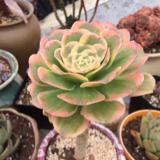
Growing Banana trees in pots is easy, if you’re unable to grow it on the ground either due to lack of space or cold climate. Learn how to grow banana trees in this complete article.
There are banana varieties that can withstand temperature drops and grows well in containers, popular especially among the fans of exotic tropical plants in the garden.
The first question that may come up in your mind is– Will banana tree in a pot can bear fruits?
And the answer is yes. It is possible, a banana tree bears fruits in pot prolifically. It may take up to 3 to 5 years to fruit if grown from seeds.
Growing Banana Trees in Pots
Banana is a lush green, fast-growing plant that can give any place a tropical look and feel. Many varieties become excellent houseplants that don’t need much care and grow up very quickly.
Dwarf varieties of banana trees can grow anywhere between 2 to 4 meters. Compared to the ordinary banana trees that can reach up to 15 meters high.
Growing Banana Trees in Pots in Tropics
Growing banana tree in pot in a tropical climate is extremely easy, with little to no care banana tree grows in the container. If you’re living under USDA Zones 9 to 11, keep your banana tree in the shade in afternoon in summer, when the plant is young. All the other requirements are similar as given below in the article for temperate zones.
Banana Varieties you can Grow in Pots and Indoors
These dwarf varieties of banana tree restrict up to only 1.5 m to 4 m. (4 to 12 feet) tall and are suitable to grow in containers. You can also grow these banana varieties indoors.
Dwarf RedDwarf CavendishDwarf BrazilianDwarf JamaicanRajapuriWilliams HybridGran NainDwarf ‘Lady Finger’
If you would like to grow ornamental bananas check out these varieties:
Ensete ventricosumMusa sikkimensis ‘Red Tiger’Musa ornata
Also read: How to grow lemon in Pots
Requirements for Growing Banana Trees in PotsSun
Banana trees grow in tropical and subtropical parts of the world and therefore they love full sun, heat and humidity. If you’re growing banana tree you should keep it in a spot that receives the sun most of the day but preferably sheltered from the wind.
Soil
Growing Banana tree requires well-draining soil, sandy soil that is rich in organic matters and compost. Buy a good quality potting mix for your banana tree. If you are making it at home make sure to mix sand, perlite, and compost or manure.
Banana needs slightly acidic to neutral soil to produce those potassium rich nutritious bananas. The soil pH should be around 6 – 7. If your soil is alkaline mix sulfur to decrease the pH.
Watering
Banana loves moisture. Water it regularly and deeply but care not to overwater. In summer, water it every day. It may need water even two times a day in hot weather or when it is root bound. Soil for growing banana plants should be kept uniformly moist. Reduce watering in winter.
Banana Plant in Pot Care
Humidity
Banana plant prefers humidity levels above 50%. To increase humidity level around the plant, mist the plant and place it on a layer of pebbles in a tray filled with water.
Overwintering Banana Tree
Banana plants stop growing when the temperature drops below 50 ° Fahrenheit.
Before the onset of winter, do heavy mulching and prune the leaves.
Put it in a warm, bright room till the spring.
Fertilizer
Banana is a fast growing plant and it requires heavy feeding to grow at its full strength. Fertilize young plant when it establishes well with nitrogen-rich fertilizer to help it grow faster. Once your banana tree in pot becomes mature enough to produce fruit, fertilize it with 15:5:30 fertilizer regularly.
Pests and diseases
Bananas are quite resistant to diseases, still when you see the leaves turning brown and drying at the edges it means you’re overwatering and if the leaves turn yellow, banana plant is having a lack of nutrients.
Some pests that might attack banana plant are banana aphids, banana weevil, and coconut scale. These pests can easily be repelled using organic pesticides.

There are banana varieties that can withstand temperature drops and grows well in containers, popular especially among the fans of exotic tropical plants in the garden.
The first question that may come up in your mind is– Will banana tree in a pot can bear fruits?
And the answer is yes. It is possible, a banana tree bears fruits in pot prolifically. It may take up to 3 to 5 years to fruit if grown from seeds.
Growing Banana Trees in Pots
Banana is a lush green, fast-growing plant that can give any place a tropical look and feel. Many varieties become excellent houseplants that don’t need much care and grow up very quickly.
Dwarf varieties of banana trees can grow anywhere between 2 to 4 meters. Compared to the ordinary banana trees that can reach up to 15 meters high.
Growing Banana Trees in Pots in Tropics
Growing banana tree in pot in a tropical climate is extremely easy, with little to no care banana tree grows in the container. If you’re living under USDA Zones 9 to 11, keep your banana tree in the shade in afternoon in summer, when the plant is young. All the other requirements are similar as given below in the article for temperate zones.
Banana Varieties you can Grow in Pots and Indoors

These dwarf varieties of banana tree restrict up to only 1.5 m to 4 m. (4 to 12 feet) tall and are suitable to grow in containers. You can also grow these banana varieties indoors.
Dwarf RedDwarf CavendishDwarf BrazilianDwarf JamaicanRajapuriWilliams HybridGran NainDwarf ‘Lady Finger’
If you would like to grow ornamental bananas check out these varieties:
Ensete ventricosumMusa sikkimensis ‘Red Tiger’Musa ornata
Also read: How to grow lemon in Pots
Requirements for Growing Banana Trees in PotsSun
Banana trees grow in tropical and subtropical parts of the world and therefore they love full sun, heat and humidity. If you’re growing banana tree you should keep it in a spot that receives the sun most of the day but preferably sheltered from the wind.
Soil
Growing Banana tree requires well-draining soil, sandy soil that is rich in organic matters and compost. Buy a good quality potting mix for your banana tree. If you are making it at home make sure to mix sand, perlite, and compost or manure.
Banana needs slightly acidic to neutral soil to produce those potassium rich nutritious bananas. The soil pH should be around 6 – 7. If your soil is alkaline mix sulfur to decrease the pH.
Watering
Banana loves moisture. Water it regularly and deeply but care not to overwater. In summer, water it every day. It may need water even two times a day in hot weather or when it is root bound. Soil for growing banana plants should be kept uniformly moist. Reduce watering in winter.
Banana Plant in Pot Care

Humidity
Banana plant prefers humidity levels above 50%. To increase humidity level around the plant, mist the plant and place it on a layer of pebbles in a tray filled with water.
Overwintering Banana Tree
Banana plants stop growing when the temperature drops below 50 ° Fahrenheit.
Before the onset of winter, do heavy mulching and prune the leaves.
Put it in a warm, bright room till the spring.
Fertilizer
Banana is a fast growing plant and it requires heavy feeding to grow at its full strength. Fertilize young plant when it establishes well with nitrogen-rich fertilizer to help it grow faster. Once your banana tree in pot becomes mature enough to produce fruit, fertilize it with 15:5:30 fertilizer regularly.
Pests and diseases
Bananas are quite resistant to diseases, still when you see the leaves turning brown and drying at the edges it means you’re overwatering and if the leaves turn yellow, banana plant is having a lack of nutrients.
Some pests that might attack banana plant are banana aphids, banana weevil, and coconut scale. These pests can easily be repelled using organic pesticides.
4
2
文章
Colorful
2017年05月23日
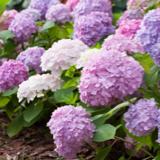
Unique looking succulents can make your rooms look better, also, they are low-maintenance and easiest plants to grow. Check out the 14 best indoor succulents for your home!
Are you looking for the one ingredient that’s capable of making any room look much better? The answer is indoor plants. After the failure of faux plants, indoor houseplants are back in fashion, and why not. A splatter of healthy greenery in your room can make it feel instantly welcoming and fresh. Another good reason to plant indoor plants is they purify air and in turn create a healthier living place.
Also Read: Plants for a Restful Sleep
Now face it, not all houseplants are easy to grow, especially for beginners. However, succulents, when grown as houseplants, adjust well to indoor conditions and are easiest to grow. And that’s why we’ve made a selection of succulents that are popular and easiest to grow.
Also Read: The Most Easy to Grow Houseplants
1. Burro’s Tail (Sedum morganianum)
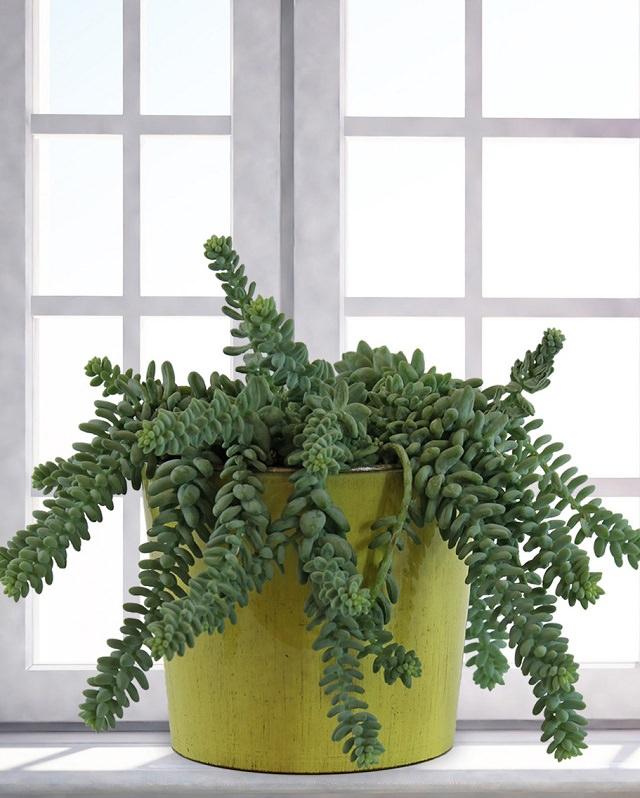
A native of Mexico, Burro’s tail is best planted in hanging baskets due to its fat trailing stems. Its beautiful gray-blue or gray-green leaves can grow up to 2 feet long. This plant does best when kept in a spot that receives bright sun.
Growing TipsLet the soil dry out between watering spells, and ensure that soil is kept on a dry side in times of winter dormancy, especially, if you’re growing it in a cool-temperate zone.Fertilize the plant once in summer using a 10:10:10 fertilizer or any cactus fertilizer.Leaves will fall off with the slightest of touches, so it is important the plant is placed where there will be a minimal disturbance.If you have to move it outside for the summer sun, ensure it will acclimate well before keeping it in a full sun.
2. Zebra Cactus (Haworthia fasciata)

Native to the African continent, the zebra plant perch on top of the soil and sports a neat for of leaves which boasts stunning horizontal white stripes. The beauty of this little plant is that it looks exceptional, takes a small space and requires little to no care.
Growing TipsUse a shallow pot since the roots don’t penetrate the soil deeply.Repot it at the interval of 12-24 months with the fresh succulent potting mix for optimum growth.Allow the soils to nearly dry out between watering spells. It’s important for all the succulents.The zebra plant is best placed in a bright spot so as not to expose the plant to the direct sun lest it becomes shriveled.
3. Aloe vera
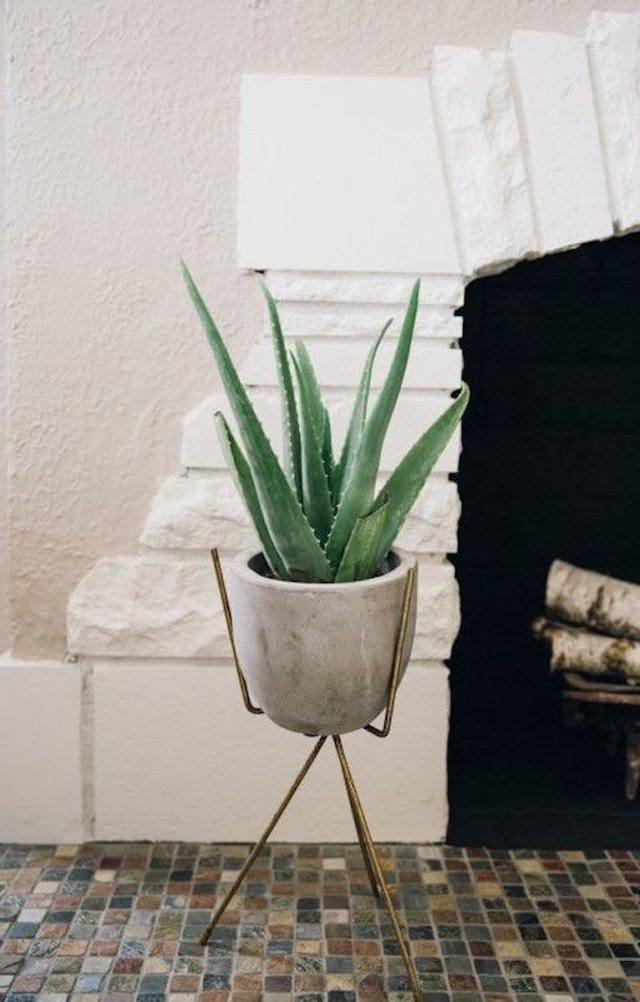
Aloe vera is a medicinal plant, a succulent whose sap has been used to treat sunburn and wounds for centuries. Medicinal value aside, aloe vera is also a great indoor plant. Because the sharp thorns along the margin of the leaves can cut people, the plant is best placed somewhere it can’t be accidentally brushed or fall.
Growing TipsLet the soil dry between soakings.Put it where it can get a couple of hours of sunlight daily.Fertilize the plant twice during the growing season using a balanced 10:10:10 fertilizer but don’t fertilize in winter.Do not repot unless the roots start to push their way out of the pot.
Also Read: How to Care for an Aloe Plants
4. Crown of Thorns (Euphorbia milii)
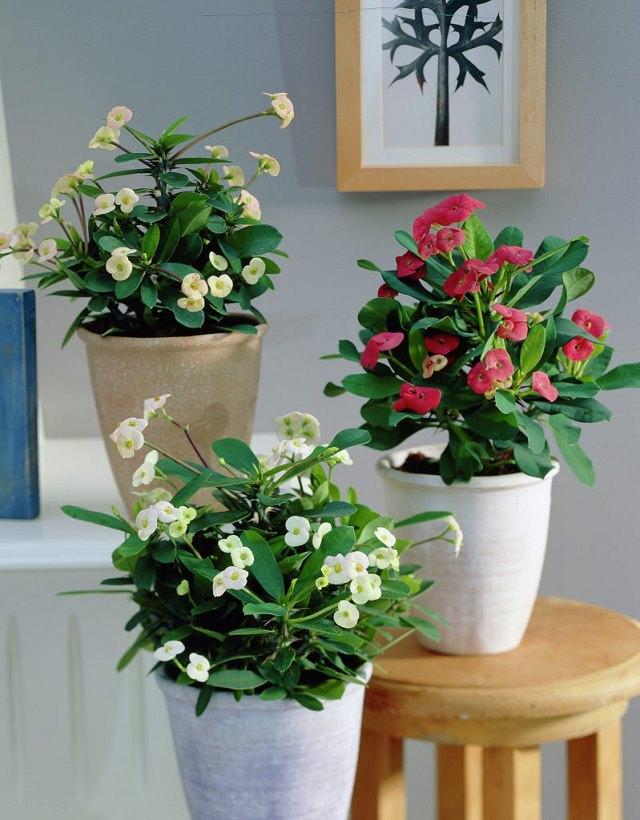
Native to Madagascar, this plant can bloom throughout the year provided you give it enough light. Long and spoon-shaped leaves appear at the end of its spiky branches, together with tiny flowers. The flowers are not noticeable because of their small size, but you will see yellow, red or salmon bracts surround them that looks attractive.
Growing TipsThis plant has low to moderate watering needs.Avoid letting the whole pot dry out or it will drop leaves.Direct light will give you the best bloom although the plant can also adapt to medium-light conditions.Fertilize 2-3 times with a balanced 10:10:10 fertilizer during the growing season.
5. Hens-and-Chicks
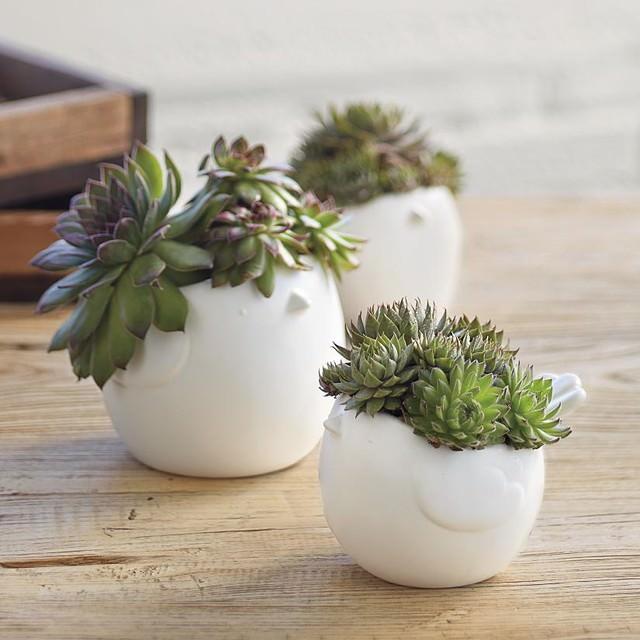
The Hens-and-Chick plants are another great succulent group of plants for indoor gardening, they form flat flowerlike rosettes that have rounded edges. These plants need to be allowed to dry a bit between watering since overwatering can cause rotting.
Growing TipsWater very infrequently during winter dormancy, if growing in a cooler region.Keep these plants in a bright spot, they can also tolerate light shade.You can propagate the plants by cuttings.
6. String of Bananas
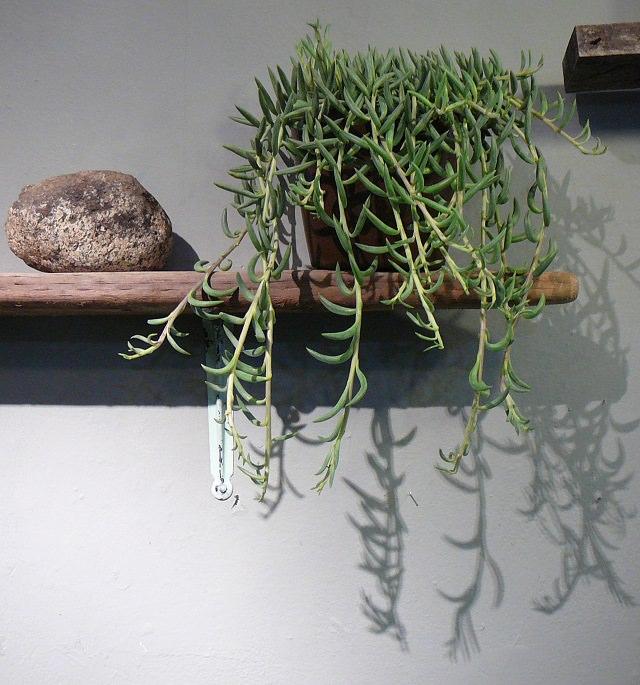
The trailing indoor succulent plant produces long tendrils of small banana-like leaves. The plant looks great when planted on its own and should be pruned regularly to grow thick and full. It also works beautifully when put in a pot containing other succulent indoor plants.
Growing TipsIt requires filtered sunlightWater the plant when soil is dry to touchIt does well in porous soil with excellent drainage.It is toxic, so you need to keep it away from pets and children who might munch it.
7. Lithops

Lithops are unique small and inconspicuous succulent plants that look like stones or pebbles. Growing lithops is very easy and don’t require much care.
Growing TipsKeep the plant in a sunny location, a south or west facing window would be best, away from drafts.Grow lithops in poor, well-drained soil.Stop watering your lithops plants in winter (in cooler zones).
8. Christmas Cactus (Schlumbergera x buckleyi)
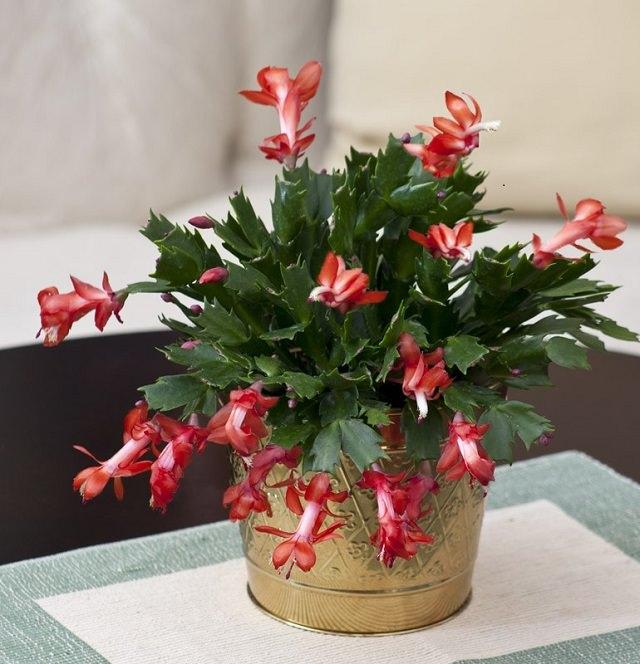
Christmas cactus needs no introduction, it is one of the most beautiful succulent plants, it looks good even without the flowers.
Growing TipsFor this plant to grow, allow the top 2 inches of the soil to dry between watering spells.Keep the plant on a dry side during winter. When it is in bud stage, be very careful since even the slightest overwatering or dehydration can lead to dropping of buds.
9. Ponytail palm (Beaucarnea recurvata)
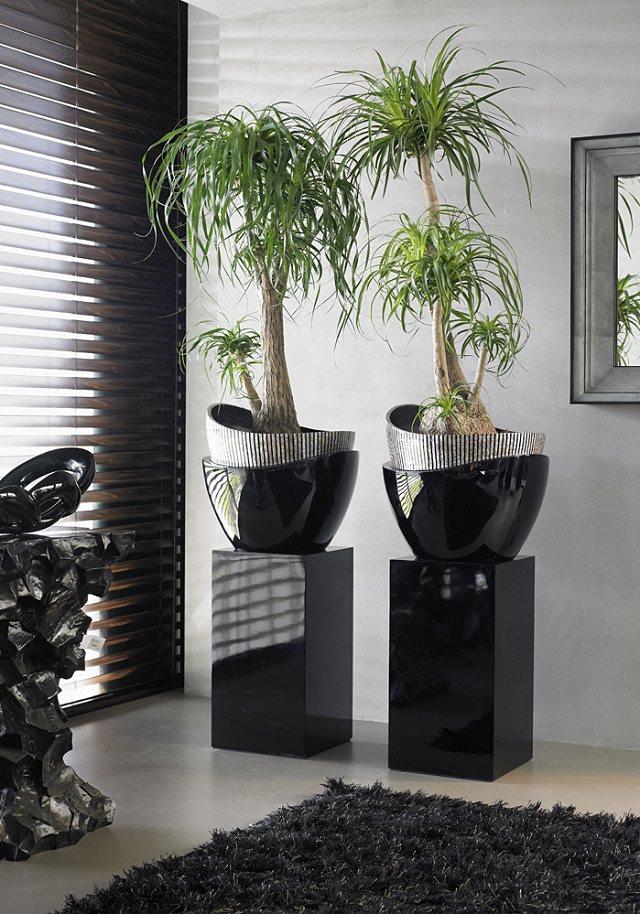
Ponytail palm is not a palm but a succulent. Probably, one of the most appealing houseplants and best in large houseplants. Its water is stored in the swollen stem base, which looks like elephant’s foot that’s why it’s also called “Elephant Foot Palm”.
Growing TipsIt grows well in sunny spots but can be grown in all day long bright indirect sunlight.It’s a plant and forget kind of plant when it comes to watering. Avoid watering regularly and let the top soil dry out before watering again.
10. Snake Plant
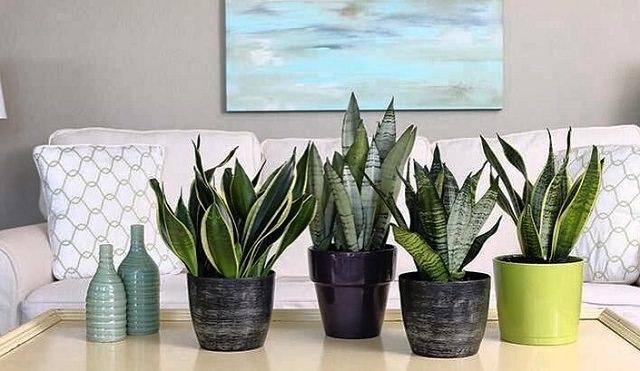
The snake plant or Mother-in-law’s tongue the most low maintenance plant in this list of best succulent plants for indoors and it is well-deserved! We also listed it in our post– Plants You can Grow without Sunlight. And why not, this succulent plant can survive in the darkest of corners and requires very low maintenance.
Growing TipsWater moderately.As snake plant is a very forgiving plant, you can place it in dim spots.
11. String of Pearls

The string of pearls is an exceptional trailing houseplant, very appealing indoors when grown in hanging baskets. You can experiment to grow it in different containers. Like other succulent houseplants growing string of pearls or beads is no different.
Growing TipsKeep the string of pearl plant in a bright light.Be careful with watering, this plant has low watering needs but in warmer regions, moderate watering is required.
12. Panda Plant (Kalanchoe tomentosa)
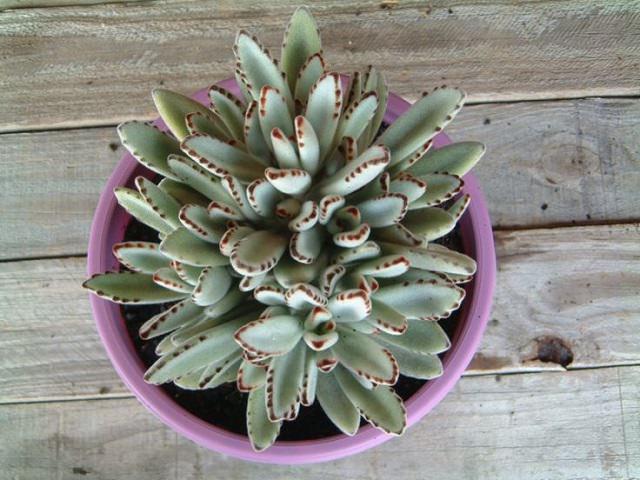
The silver gray hair of this plant makes it look fuzzy, the leaves are fat like other succulents and have rusty color on edges, like many other plants of kalanchoe genus the plant forms flowers too. However, they rarely bloom in indoor conditions.
Growing TipsKeeping the panda plant in a spot that receives bright indirect light and a couple of hours of direct sunlight is a good idea.Water infrequently and let the plant to dry out between the watering spells.Feed the plant once in a month during the growing season.Save the plant from cold and draft, normal room temperature is perfect.
13. Kalanchoe blossfeldiana
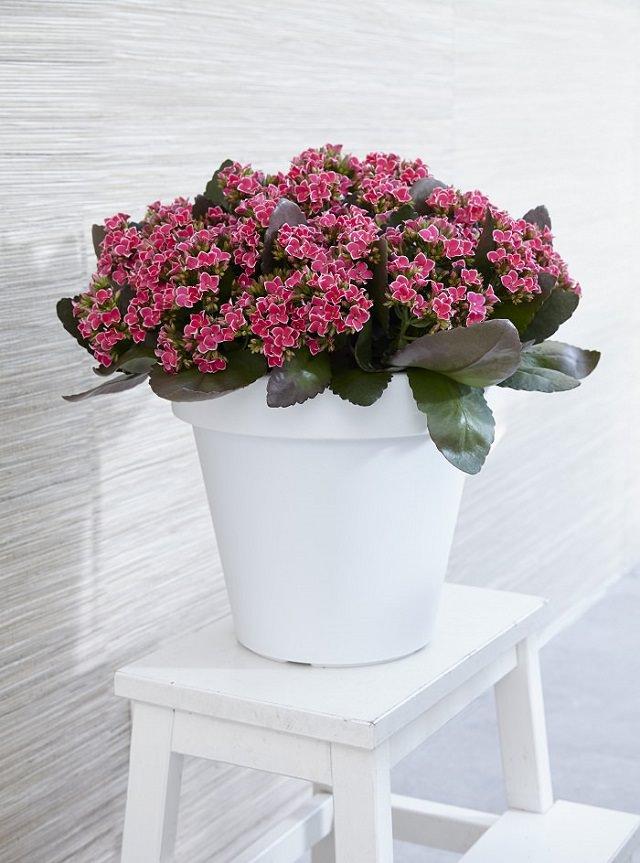
Kalanchoe blossfeldiana is one of the best flowering houseplants you can grow. Plants of this genus grow best outdoors in warm climates. However, it can be grown indoors. This flowering succulent comes in a variety of colors.
Growing TipsLow watering needs.The plant needs to be in a sunny spot to bloom.
Also Read: Flowering Houseplants
14. Pencil Cactus (Euphorbia tirucalli)

Pencil cactus became one of the most popular succulent houseplants from last few years and why not this unique African plant can grow up to 6 feet tall indoors and looks so different, quite a few houseplants like fiddle leaf fig can achieve such height.
Growing TipsKeep the plant near a sunny window.Water every couple of weeks, the plant has low watering needs.Use well-drained, gritty soil.Repot the plant every year or when you find it rootbound.
Are you looking for the one ingredient that’s capable of making any room look much better? The answer is indoor plants. After the failure of faux plants, indoor houseplants are back in fashion, and why not. A splatter of healthy greenery in your room can make it feel instantly welcoming and fresh. Another good reason to plant indoor plants is they purify air and in turn create a healthier living place.
Also Read: Plants for a Restful Sleep
Now face it, not all houseplants are easy to grow, especially for beginners. However, succulents, when grown as houseplants, adjust well to indoor conditions and are easiest to grow. And that’s why we’ve made a selection of succulents that are popular and easiest to grow.
Also Read: The Most Easy to Grow Houseplants
1. Burro’s Tail (Sedum morganianum)

A native of Mexico, Burro’s tail is best planted in hanging baskets due to its fat trailing stems. Its beautiful gray-blue or gray-green leaves can grow up to 2 feet long. This plant does best when kept in a spot that receives bright sun.
Growing TipsLet the soil dry out between watering spells, and ensure that soil is kept on a dry side in times of winter dormancy, especially, if you’re growing it in a cool-temperate zone.Fertilize the plant once in summer using a 10:10:10 fertilizer or any cactus fertilizer.Leaves will fall off with the slightest of touches, so it is important the plant is placed where there will be a minimal disturbance.If you have to move it outside for the summer sun, ensure it will acclimate well before keeping it in a full sun.
2. Zebra Cactus (Haworthia fasciata)

Native to the African continent, the zebra plant perch on top of the soil and sports a neat for of leaves which boasts stunning horizontal white stripes. The beauty of this little plant is that it looks exceptional, takes a small space and requires little to no care.
Growing TipsUse a shallow pot since the roots don’t penetrate the soil deeply.Repot it at the interval of 12-24 months with the fresh succulent potting mix for optimum growth.Allow the soils to nearly dry out between watering spells. It’s important for all the succulents.The zebra plant is best placed in a bright spot so as not to expose the plant to the direct sun lest it becomes shriveled.
3. Aloe vera

Aloe vera is a medicinal plant, a succulent whose sap has been used to treat sunburn and wounds for centuries. Medicinal value aside, aloe vera is also a great indoor plant. Because the sharp thorns along the margin of the leaves can cut people, the plant is best placed somewhere it can’t be accidentally brushed or fall.
Growing TipsLet the soil dry between soakings.Put it where it can get a couple of hours of sunlight daily.Fertilize the plant twice during the growing season using a balanced 10:10:10 fertilizer but don’t fertilize in winter.Do not repot unless the roots start to push their way out of the pot.
Also Read: How to Care for an Aloe Plants
4. Crown of Thorns (Euphorbia milii)

Native to Madagascar, this plant can bloom throughout the year provided you give it enough light. Long and spoon-shaped leaves appear at the end of its spiky branches, together with tiny flowers. The flowers are not noticeable because of their small size, but you will see yellow, red or salmon bracts surround them that looks attractive.
Growing TipsThis plant has low to moderate watering needs.Avoid letting the whole pot dry out or it will drop leaves.Direct light will give you the best bloom although the plant can also adapt to medium-light conditions.Fertilize 2-3 times with a balanced 10:10:10 fertilizer during the growing season.
5. Hens-and-Chicks

The Hens-and-Chick plants are another great succulent group of plants for indoor gardening, they form flat flowerlike rosettes that have rounded edges. These plants need to be allowed to dry a bit between watering since overwatering can cause rotting.
Growing TipsWater very infrequently during winter dormancy, if growing in a cooler region.Keep these plants in a bright spot, they can also tolerate light shade.You can propagate the plants by cuttings.
6. String of Bananas

The trailing indoor succulent plant produces long tendrils of small banana-like leaves. The plant looks great when planted on its own and should be pruned regularly to grow thick and full. It also works beautifully when put in a pot containing other succulent indoor plants.
Growing TipsIt requires filtered sunlightWater the plant when soil is dry to touchIt does well in porous soil with excellent drainage.It is toxic, so you need to keep it away from pets and children who might munch it.
7. Lithops

Lithops are unique small and inconspicuous succulent plants that look like stones or pebbles. Growing lithops is very easy and don’t require much care.
Growing TipsKeep the plant in a sunny location, a south or west facing window would be best, away from drafts.Grow lithops in poor, well-drained soil.Stop watering your lithops plants in winter (in cooler zones).
8. Christmas Cactus (Schlumbergera x buckleyi)

Christmas cactus needs no introduction, it is one of the most beautiful succulent plants, it looks good even without the flowers.
Growing TipsFor this plant to grow, allow the top 2 inches of the soil to dry between watering spells.Keep the plant on a dry side during winter. When it is in bud stage, be very careful since even the slightest overwatering or dehydration can lead to dropping of buds.
9. Ponytail palm (Beaucarnea recurvata)

Ponytail palm is not a palm but a succulent. Probably, one of the most appealing houseplants and best in large houseplants. Its water is stored in the swollen stem base, which looks like elephant’s foot that’s why it’s also called “Elephant Foot Palm”.
Growing TipsIt grows well in sunny spots but can be grown in all day long bright indirect sunlight.It’s a plant and forget kind of plant when it comes to watering. Avoid watering regularly and let the top soil dry out before watering again.
10. Snake Plant

The snake plant or Mother-in-law’s tongue the most low maintenance plant in this list of best succulent plants for indoors and it is well-deserved! We also listed it in our post– Plants You can Grow without Sunlight. And why not, this succulent plant can survive in the darkest of corners and requires very low maintenance.
Growing TipsWater moderately.As snake plant is a very forgiving plant, you can place it in dim spots.
11. String of Pearls

The string of pearls is an exceptional trailing houseplant, very appealing indoors when grown in hanging baskets. You can experiment to grow it in different containers. Like other succulent houseplants growing string of pearls or beads is no different.
Growing TipsKeep the string of pearl plant in a bright light.Be careful with watering, this plant has low watering needs but in warmer regions, moderate watering is required.
12. Panda Plant (Kalanchoe tomentosa)

The silver gray hair of this plant makes it look fuzzy, the leaves are fat like other succulents and have rusty color on edges, like many other plants of kalanchoe genus the plant forms flowers too. However, they rarely bloom in indoor conditions.
Growing TipsKeeping the panda plant in a spot that receives bright indirect light and a couple of hours of direct sunlight is a good idea.Water infrequently and let the plant to dry out between the watering spells.Feed the plant once in a month during the growing season.Save the plant from cold and draft, normal room temperature is perfect.
13. Kalanchoe blossfeldiana

Kalanchoe blossfeldiana is one of the best flowering houseplants you can grow. Plants of this genus grow best outdoors in warm climates. However, it can be grown indoors. This flowering succulent comes in a variety of colors.
Growing TipsLow watering needs.The plant needs to be in a sunny spot to bloom.
Also Read: Flowering Houseplants
14. Pencil Cactus (Euphorbia tirucalli)

Pencil cactus became one of the most popular succulent houseplants from last few years and why not this unique African plant can grow up to 6 feet tall indoors and looks so different, quite a few houseplants like fiddle leaf fig can achieve such height.
Growing TipsKeep the plant near a sunny window.Water every couple of weeks, the plant has low watering needs.Use well-drained, gritty soil.Repot the plant every year or when you find it rootbound.
8
9
文章
lenny
2017年05月23日

Make a Terrace Vegetable Garden on your rooftop, it is easy if you’ll do this with some planning. In this article you’ll learn which vegetables are suitable and how you can grow them on terrace.
Fresh home grown vegetables taste delicious, are good for health and safe from chemicals. You don’t need to acquire a regular garden to grow them, you can also grow these on a balcony or terrace.
There are some really interesting ways to incorporate the vegetable crops on the terrace. These alternatives are space saving and also a real eye-catcher.
1. Creating a vegetable Garden in Pots
In containers you can plant almost any vegetable. Choose large and deep pots, avoid thin and poor quality plastic pots because they heat up quickly and drain poorly.
Soil
Using normal garden soil is a bad idea for growing vegetables in pots. Instead use good quality potting mix for healthy growth of plants and productivity. You can also prepare it yourself, read this article.
Vegetables for Pots
Tomatoes
Cucumbers
Radishes
Beans
Potatoes
Onions
Carrots
Beetroot
Lettuce
Garlic
Chilies and Peppers
Gourds
Eggplant (Brinjal)
2. Create Raised Beds on Terrace
If you’re looking for practical as well as stylish way to make a terrace vegetable garden. Make a raised bed, in raised beds you’ll be able to grow lot of vegetables in compare to containers. Plants will thrive better with less care and maintenance, plus they are cheap.
The raised bed on the terrace does not differ fundamentally from those you see in a regular garden.
In well-stocked hardware stores or even online shops you will find special raised beds for terraces, you’ll only need to configure which one is better for you or you can make your own raised bed, which is very easy. Just ensure before installing it that the surface of terrace below it is waterproofed efficiently or not.
Fill Raised Bed with Soil
If you fill the raised bed with soil, consider to prevent voles and pests from entering the bed.
To make soil, just mix quality garden soil, ripe compost and manure.
Advantage of Raised Beds
Probably the greatest advantage of raised bed is of course its height and wideness on terrace. Gardening can hardly be more convenient.
3. Integrate Vegetable Patch on the Terrace
You can also integrate a vegetable patch on your terrace and grow vegetable on the surface itself. But doing this is only good on large rooftops. Vegetable patch is similar to making a normal garden bed.
The integrated bed should be filled normally with soil like a regular garden bed. An addition of compost in soil is a perfect natural fertilizer for most of the plants.
4. Creating a Vegetable Terrace Garden in Planter boxes
Flower boxes and planters can be used to create a vegetable garden. You can hang these on an existing railing or set them just on the floor. How do you use them is entirely up to you.
Do not use ordinary garden soil in these planter boxes, either use quality potting mix or compost rich soil. Fertilizing is also important to improve productivity but it varies according to plants: peppers and tomatoes are heavy feeders, whereas green leafy vegetables do not need much fertilizer.
Plants for Flower Boxes
Cucumbers
Tomatoes
Garlic
Chilies
Herbs
Radishes
Bush beans
Greens
Cucumbers, tomatoes and beans require a climbing aid, so that the plants do not break.
5. Repurpose Sandboxes
A sandbox is not just for games. From a small simple wooden sandpit, you can also make a hefty vegetable patch. This looks not only decorative, but provides your plants an optimal space to thrive.
Instead of using gravel for drainage, just fill the quality compost with soil. In the sandbox you can grow all sorts of small vegetables and herbs, mostly low growing that spreads too much.
Radishes
Herbs
Garlic
Lettuce
Spinach
Ginger
Asian Greens and lot of other green leafy vegetables
6. Optimize Vertical Space
Your main challenge is how smartly you utilize your vertical space to double up the space you have on your terrace, make a plan on how you should do this, if you have walls, hang planters on it.
Grow vegetable shrubs and vines like beans, squashes, gourds and tall tomato varieties near the walls and railings. This way they’ll not only get support but also grow outside and upward and you’ll save a lot of your space.
Use old shelves, racks to keep pots and buy pot holders, put them around the corners.
On these you can grow herbs to improve the taste of salads and cuisines you’ll prepare, you can also grow lot of flowers to appease ornamental views.
Tips for the Prolific Terrace Vegetable Garden
Fertilize vegetables regularly with good quality organic fertilizer. With some research and experience you’ll be able to find out which type of fertilizer you should feed to specific vegetables.
Water plants regularly and deeply. Read this article for container watering tips.
Check plants regularly for pests. Read this article for homemade natural pesticide recipes.
Prune vegetable plants to keep them in good shape and in healthy growth. Look out for suckers, especially in tomatoes and pinch them off immediately if found one.
For the vegetables, it is always good to grow them on the Southern or Western face, so the plants will have enough sun and can thrive easily. But too much sun is not good either. If you live in a warm tropical climate and the sun is too strong, it is advisable to provide afternoon shade to plants.

Fresh home grown vegetables taste delicious, are good for health and safe from chemicals. You don’t need to acquire a regular garden to grow them, you can also grow these on a balcony or terrace.
There are some really interesting ways to incorporate the vegetable crops on the terrace. These alternatives are space saving and also a real eye-catcher.
1. Creating a vegetable Garden in Pots
In containers you can plant almost any vegetable. Choose large and deep pots, avoid thin and poor quality plastic pots because they heat up quickly and drain poorly.
Soil
Using normal garden soil is a bad idea for growing vegetables in pots. Instead use good quality potting mix for healthy growth of plants and productivity. You can also prepare it yourself, read this article.
Vegetables for Pots
Tomatoes
Cucumbers
Radishes
Beans
Potatoes
Onions
Carrots
Beetroot
Lettuce
Garlic
Chilies and Peppers
Gourds
Eggplant (Brinjal)
2. Create Raised Beds on Terrace

If you’re looking for practical as well as stylish way to make a terrace vegetable garden. Make a raised bed, in raised beds you’ll be able to grow lot of vegetables in compare to containers. Plants will thrive better with less care and maintenance, plus they are cheap.
The raised bed on the terrace does not differ fundamentally from those you see in a regular garden.
In well-stocked hardware stores or even online shops you will find special raised beds for terraces, you’ll only need to configure which one is better for you or you can make your own raised bed, which is very easy. Just ensure before installing it that the surface of terrace below it is waterproofed efficiently or not.
Fill Raised Bed with Soil
If you fill the raised bed with soil, consider to prevent voles and pests from entering the bed.
To make soil, just mix quality garden soil, ripe compost and manure.
Advantage of Raised Beds
Probably the greatest advantage of raised bed is of course its height and wideness on terrace. Gardening can hardly be more convenient.
3. Integrate Vegetable Patch on the Terrace
You can also integrate a vegetable patch on your terrace and grow vegetable on the surface itself. But doing this is only good on large rooftops. Vegetable patch is similar to making a normal garden bed.
The integrated bed should be filled normally with soil like a regular garden bed. An addition of compost in soil is a perfect natural fertilizer for most of the plants.
4. Creating a Vegetable Terrace Garden in Planter boxes
Flower boxes and planters can be used to create a vegetable garden. You can hang these on an existing railing or set them just on the floor. How do you use them is entirely up to you.
Do not use ordinary garden soil in these planter boxes, either use quality potting mix or compost rich soil. Fertilizing is also important to improve productivity but it varies according to plants: peppers and tomatoes are heavy feeders, whereas green leafy vegetables do not need much fertilizer.
Plants for Flower Boxes
Cucumbers
Tomatoes
Garlic
Chilies
Herbs
Radishes
Bush beans
Greens
Cucumbers, tomatoes and beans require a climbing aid, so that the plants do not break.
5. Repurpose Sandboxes
A sandbox is not just for games. From a small simple wooden sandpit, you can also make a hefty vegetable patch. This looks not only decorative, but provides your plants an optimal space to thrive.
Instead of using gravel for drainage, just fill the quality compost with soil. In the sandbox you can grow all sorts of small vegetables and herbs, mostly low growing that spreads too much.
Radishes
Herbs
Garlic
Lettuce
Spinach
Ginger
Asian Greens and lot of other green leafy vegetables
6. Optimize Vertical Space

Your main challenge is how smartly you utilize your vertical space to double up the space you have on your terrace, make a plan on how you should do this, if you have walls, hang planters on it.
Grow vegetable shrubs and vines like beans, squashes, gourds and tall tomato varieties near the walls and railings. This way they’ll not only get support but also grow outside and upward and you’ll save a lot of your space.
Use old shelves, racks to keep pots and buy pot holders, put them around the corners.
On these you can grow herbs to improve the taste of salads and cuisines you’ll prepare, you can also grow lot of flowers to appease ornamental views.
Tips for the Prolific Terrace Vegetable Garden
Fertilize vegetables regularly with good quality organic fertilizer. With some research and experience you’ll be able to find out which type of fertilizer you should feed to specific vegetables.
Water plants regularly and deeply. Read this article for container watering tips.
Check plants regularly for pests. Read this article for homemade natural pesticide recipes.
Prune vegetable plants to keep them in good shape and in healthy growth. Look out for suckers, especially in tomatoes and pinch them off immediately if found one.
For the vegetables, it is always good to grow them on the Southern or Western face, so the plants will have enough sun and can thrive easily. But too much sun is not good either. If you live in a warm tropical climate and the sun is too strong, it is advisable to provide afternoon shade to plants.
1
1
文章
Colorful
2017年05月23日

The houseplants in this list are exceptional; they are bold and pretty. Some of the most unique, beautiful indoor plants you should grow!Grow some of these plants indoors, and you’ll see a big change in your interior. These beautiful houseplants have the ability to change the appearance of any dull-boring room!1. Nerve Plant
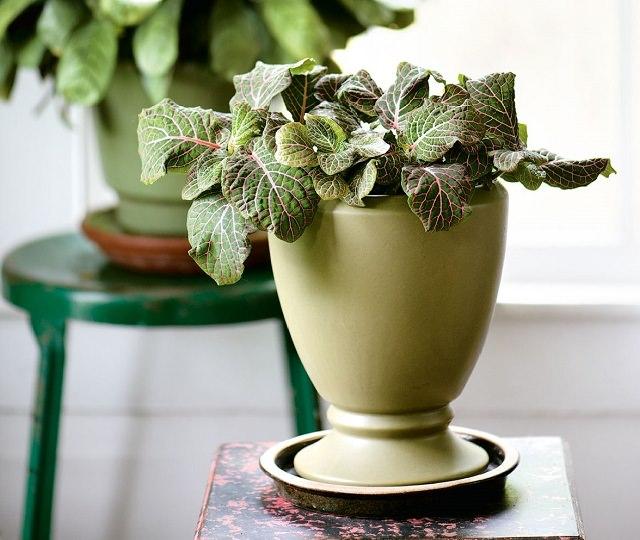
This demanding houseplant looks gorgeous due to its striking leaves. Picky about watering and dry indoor air and cold drafts. You must need to keep balance in watering.
2. Croton
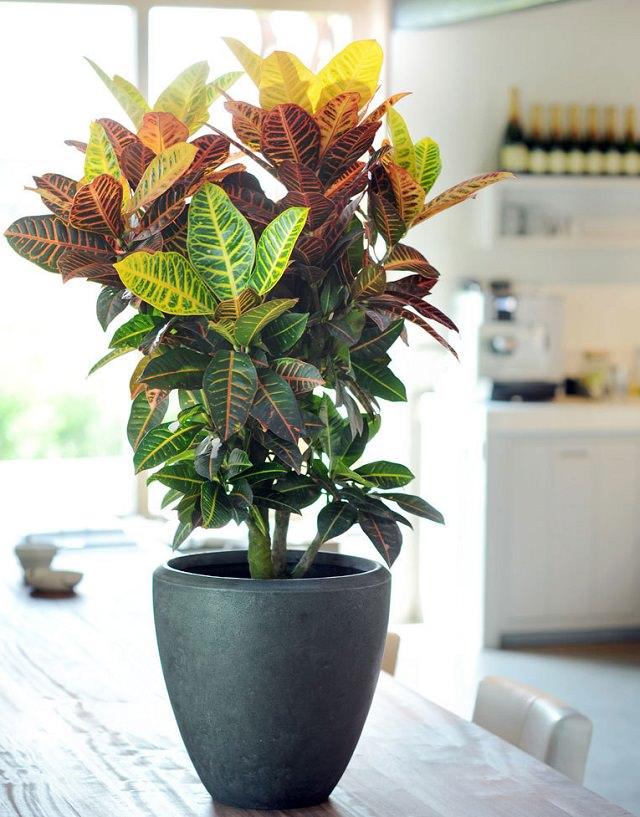
The bold and bodacious houseplant that is low maintenance too. The mix of yellow, amber, and orange color linear markings on thick dark green foliage, croton looks stunning. To grow, keep it in a spot that receives bright indirect light most of the time and water sporadically.
3. Calathea
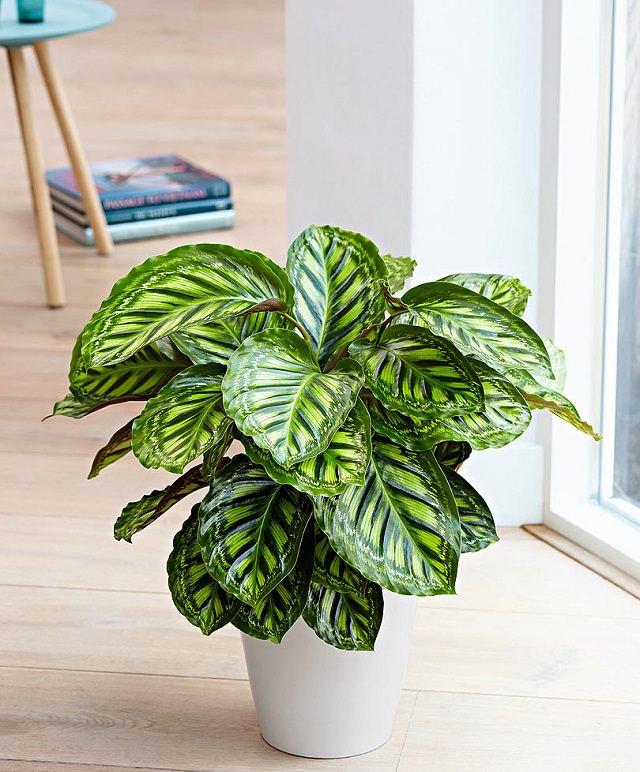
Lovely plant, great to look at! Many varieties are available in astonishing color combinations and patterns. This tropical houseplant doesn’t mind low light conditions. Keep it in warm, normal room temperature, saving from cold drafts. It likes humid surroundings and moderate watering.
4. Pencil Cactus
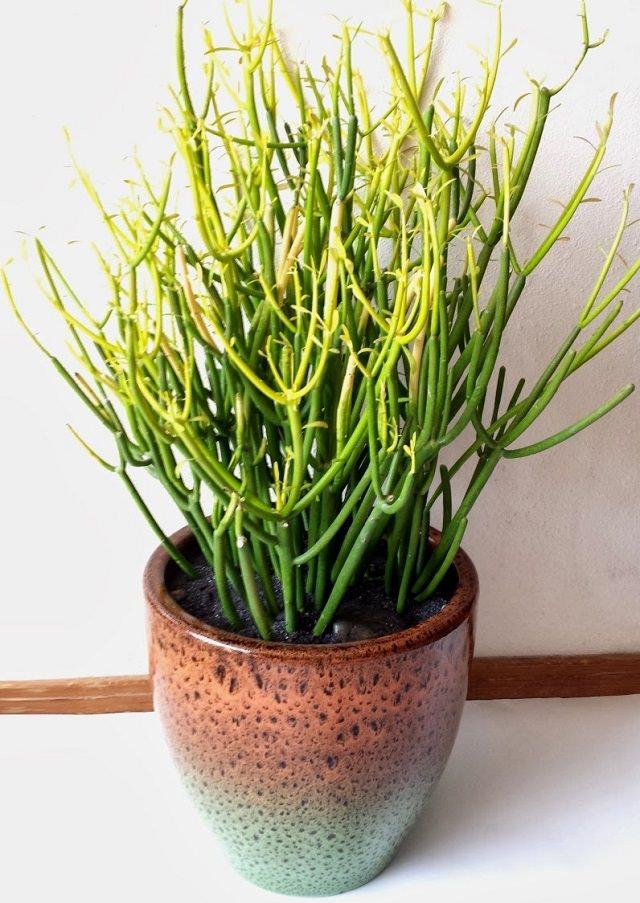
This unusual looking astonishing plant is notorious for its toxic milky sap (take care when handling this plant); still, it’s getting popular as a houseplant. Pencil cactus has medium to high light requirements and low watering needs; it also doesn’t mind dry air. Watering 2-3 times in a month is sufficient. To grow, keep the plant in a spot with ample light, a shaft of sunlight for a few hours or even more and it would do fine.
5. Silver Vase Plant
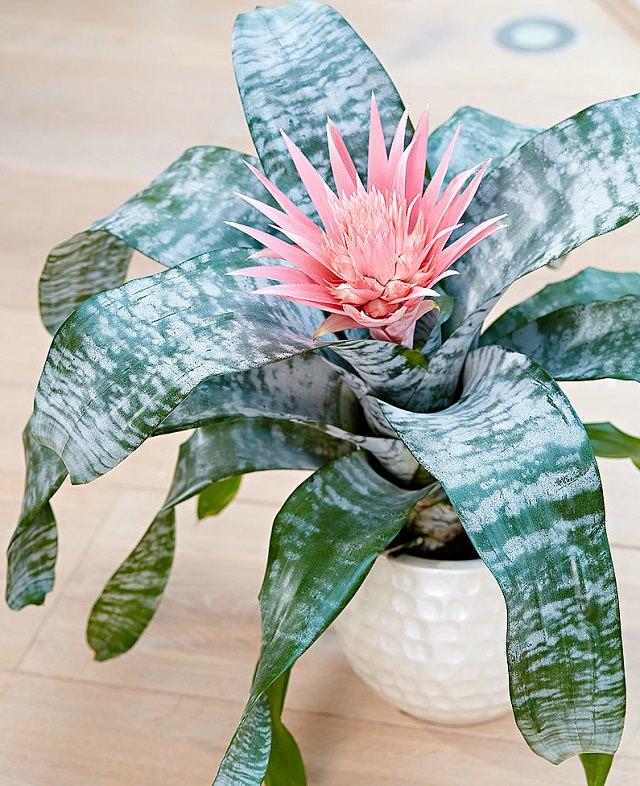
Unusual but a beautiful indoor plant, the silver vase or “urn plant” belongs to bromeliad family. Overall, growing this houseplant is similar to others– Be careful with watering, provide bright indirect light.
6. Fiddle Leaf Fig
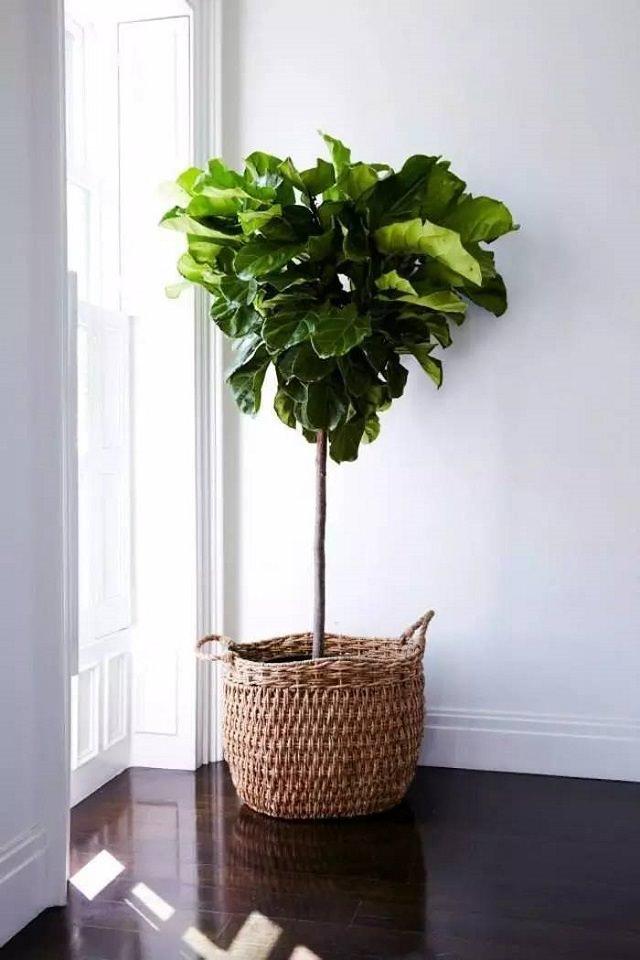
We couldn’t complete this list without adding fiddle leaf fig. Fiddle leaf is a tall, appealing houseplant with glossy, leathery foliage. This large houseplant can change the look of any room.
7. Aluminium Plant
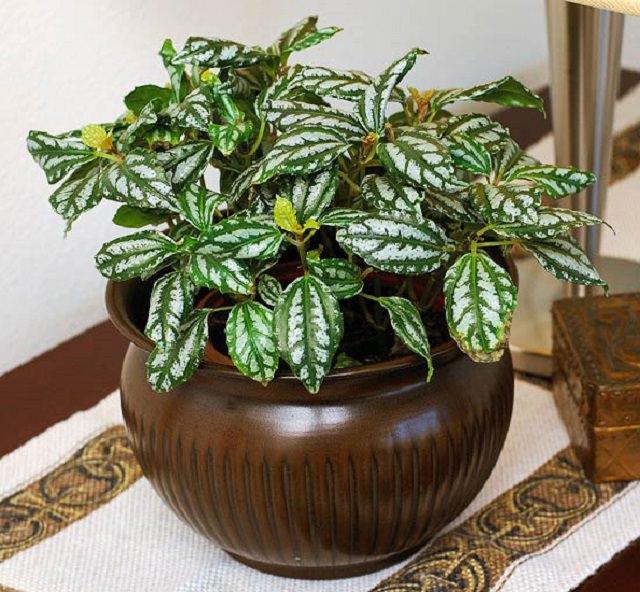
This plant is known for the beautiful silver strips that look like a color of aluminum; these strips appear over the glossy green color of each leaf. One of the beautiful indoor plants it is low maintenance. Keep it in a cool shady spot that receives a few hours of bright indirect light, water only when soil is dry.
8. Red Aglaonema
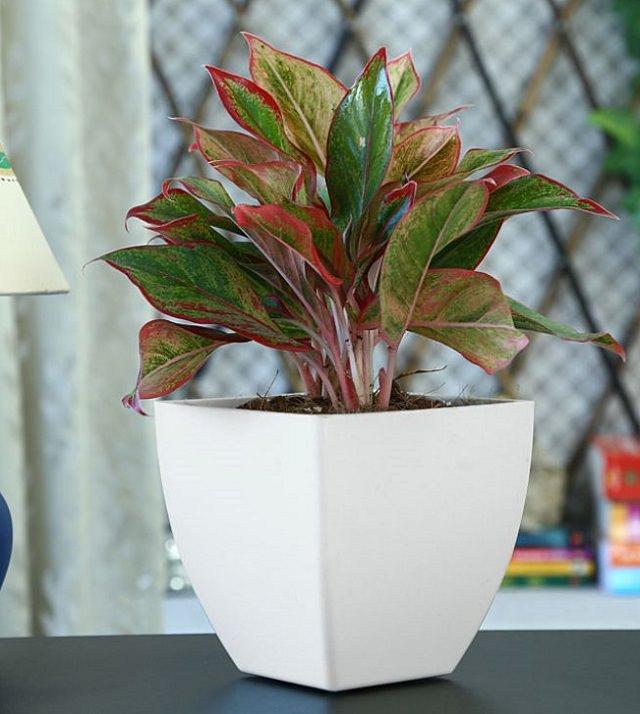
This beautiful houseplant’s dark green leaves with streaks of red and pink make it look really adorable indoors. It is absolutely easy to grow like Chinese evergreen and tolerates low light conditions and drought.
9. Anthurium
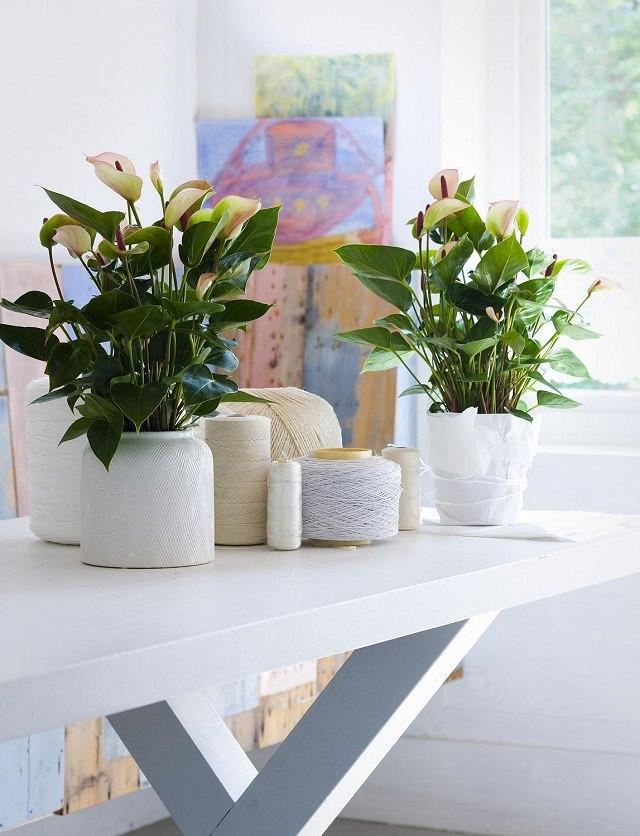
Anthuriums are beautiful houseplants that bloom in alluring shades of white, pink red or lavender. With a rich color palette, long lifespan and low care requirements, they are good for those with a busy lifestyle. Anthurium produces more foliage when grown in low-light conditions, so it’s you keep this plant in a spot that receives indirect sunlight all day.
10. African Mask Plant
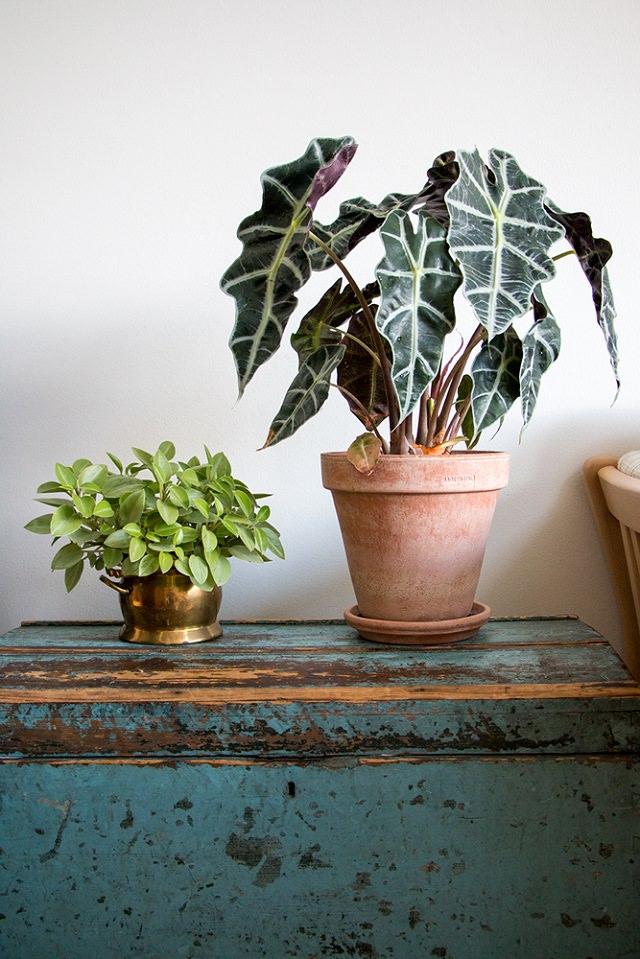
African Mask Plant with its dark green leaves and silvery-white veins can be easily mistaken for an artificial plant. This plant needs moderate watering and a bright position away from direct sunlight. Clean the leaves every few days to keep the plant looking attractive and healthy.
11. Prayer Plant
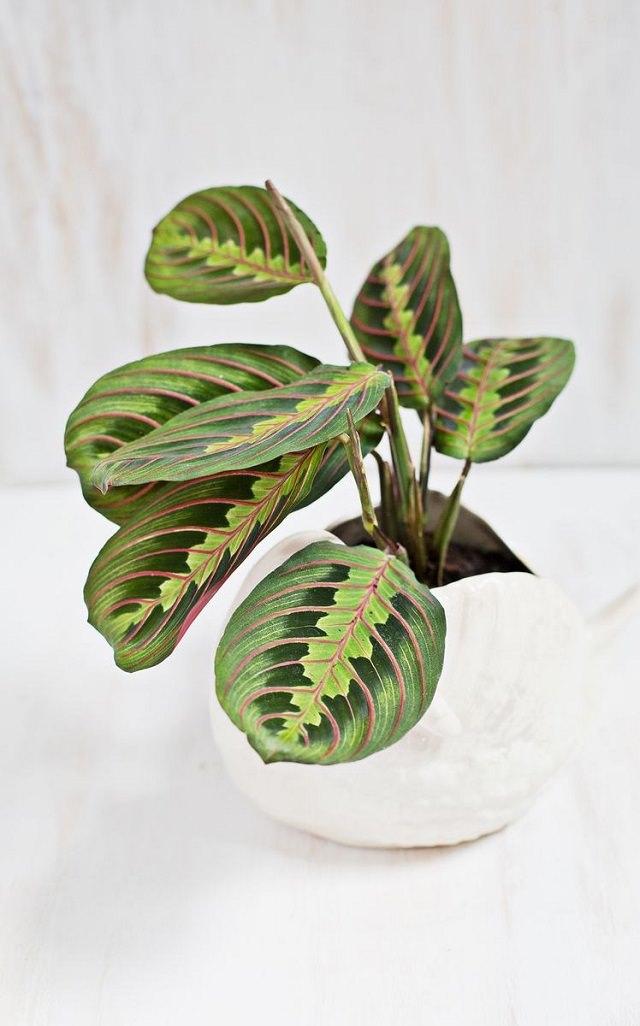
With its beautifully patterned oblong foliage and low care requirements, this exotic houseplant is a lovely addition to any home. It requires bright light, moderate watering, and warm room temperature when it’s grown indoors. One interesting fact about this houseplant is that it folds up its leaves in the night or in the dark place.
12. Bird’s Nest Fern
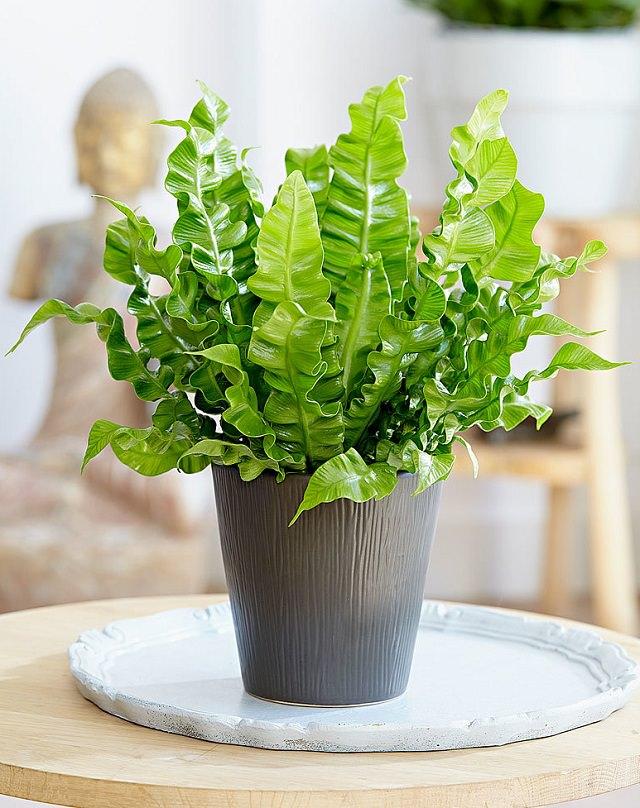
Native to Southeast Asia, bird’s nest fern (Asplenium nidus) is easy to grow if the proper conditions are given—mainly warmth and humidity. Bright indirect light and temperature around 70 F are optimum for growing bird’s nest fern indoors. Visit HGTV to learn more growing this!
13. Adenium
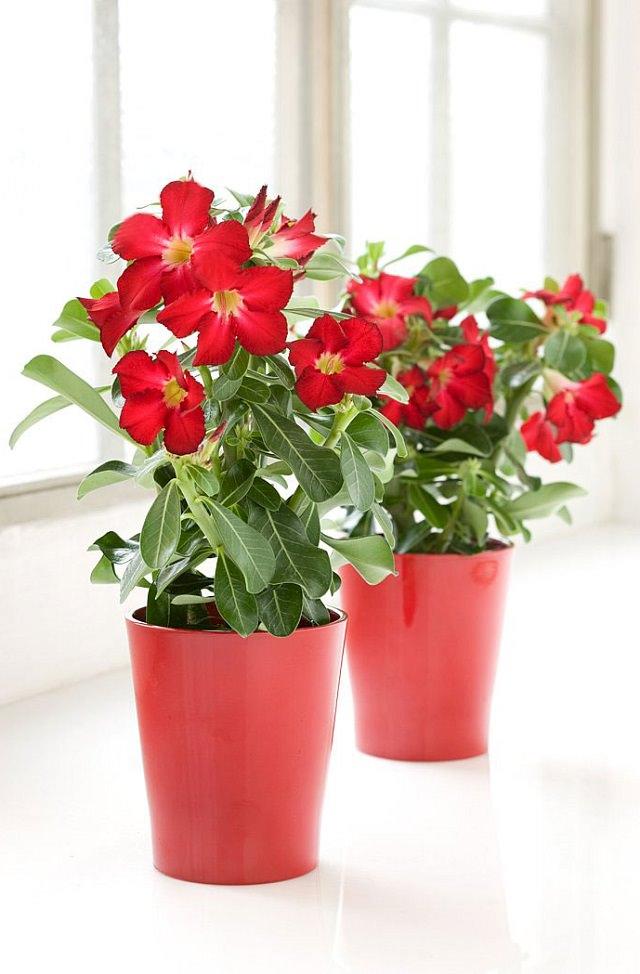
If you live in a warm climate and have a South or West facing window in your room, this is the plant you need to grow. Except for its sunlight requirements, Adenium is a low maintenance houseplant and flowers heartily throughout the year in frost-free climates.
14. Fiber-Optic Grass
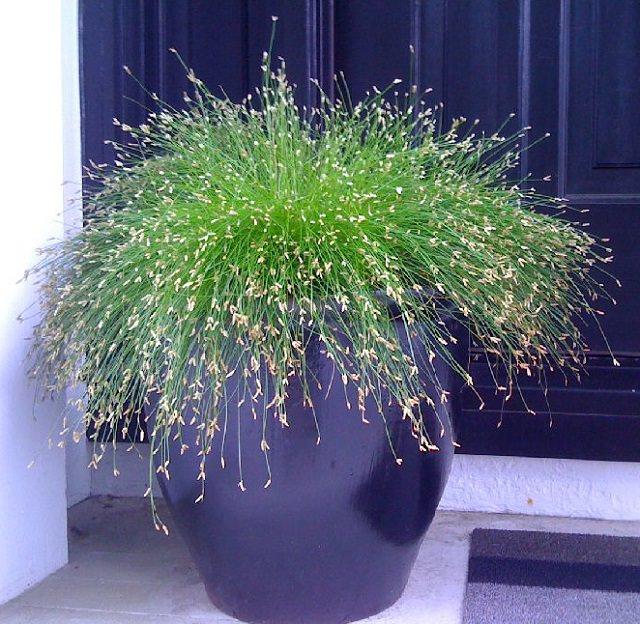
Fiber optic grass is a tropical grass that grows best in subtropical and tropical outdoor areas under USDA Zones (9-11), but it can be grown indoors in cooler regions too (We also added it to our list of BEST ORNAMENTAL GRASSES). Choose an ALLURING pot that will accentuate the beauty of this exotic grass, place it in a warm spot that receives bright light, and keep the soil slightly moist.
15. Ti Plant
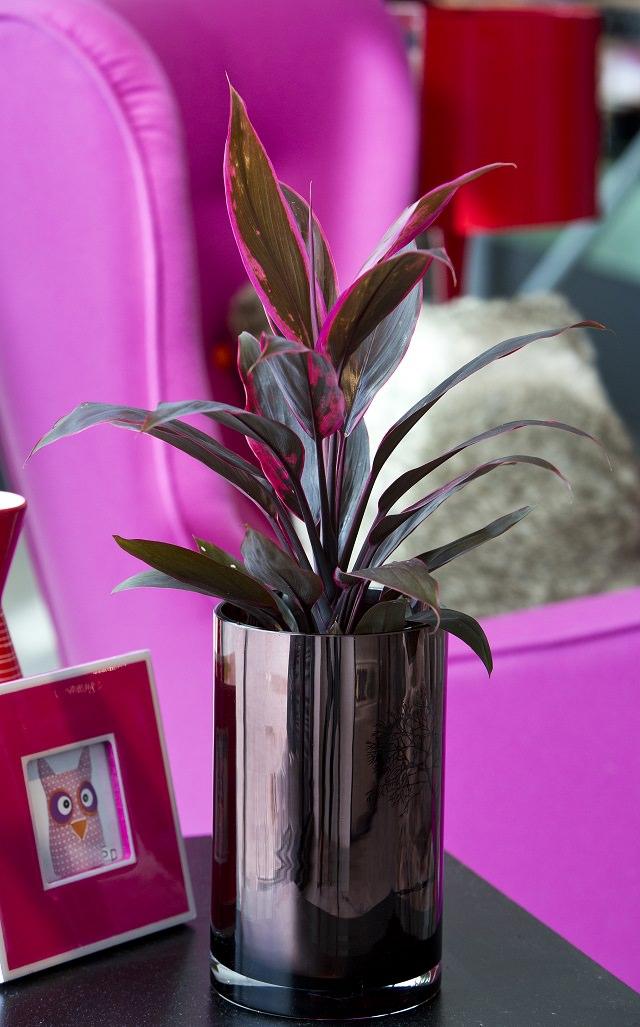
Purple foliage with streaks of blazing pink, the Ti plant looks hot and gorgeous. You can grow this plant for year around foliage attraction. This plant is drought tolerant but has a high light requirement, indoors, it must be kept somewhere where it can absorb direct and indirect light both.
16. Oxalis
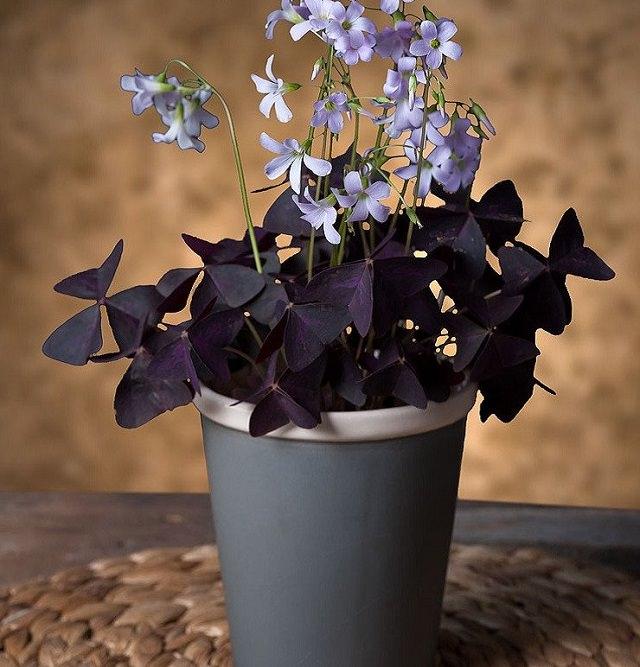
Oxalis belongs to a genus of edible, perennial plants characterized by striking mauve leaves and pink or white blooms. It prefers medium-to-bright light and performs better when grown in evenly moist soil.
17. Ponytail Palm
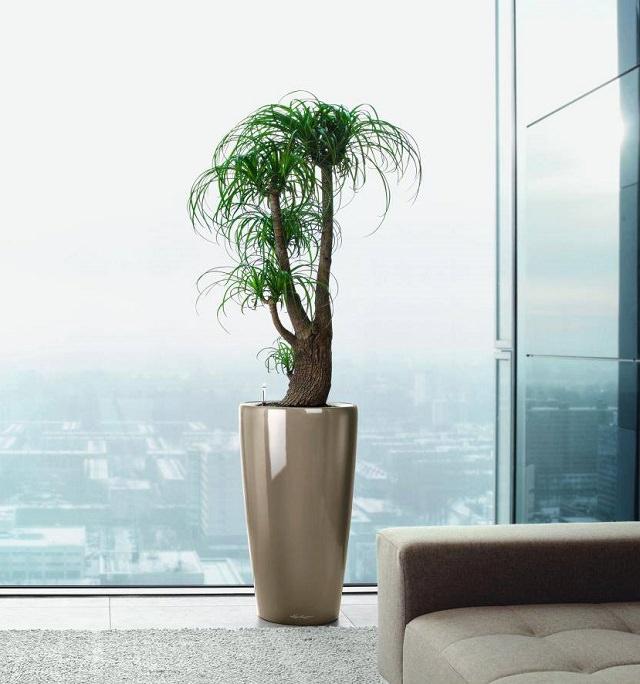
Ponytail Palm is an exotic succulent plant. It looks so interesting, one of the low maintenance plants as it has low watering needs and grows slowly, which means you don’t need to repot it frequently.
18. Poinsettia
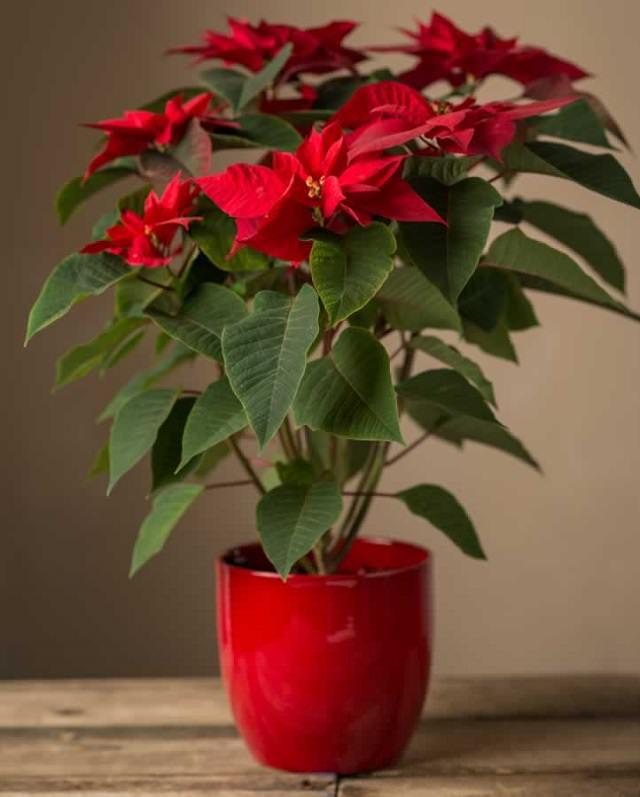
Poinsettias and holiday decorations go hand in hand. This plant looks stunning with or without blooms due to its colorful bracts and foliage. To remain healthy, cheery, and colorful, it needs a bright spot, a couple of hours of morning sunlight and indirect light all day long is sufficient. A draft-free place is best, watering when the soil is dry is required.
19. Rex Begonia
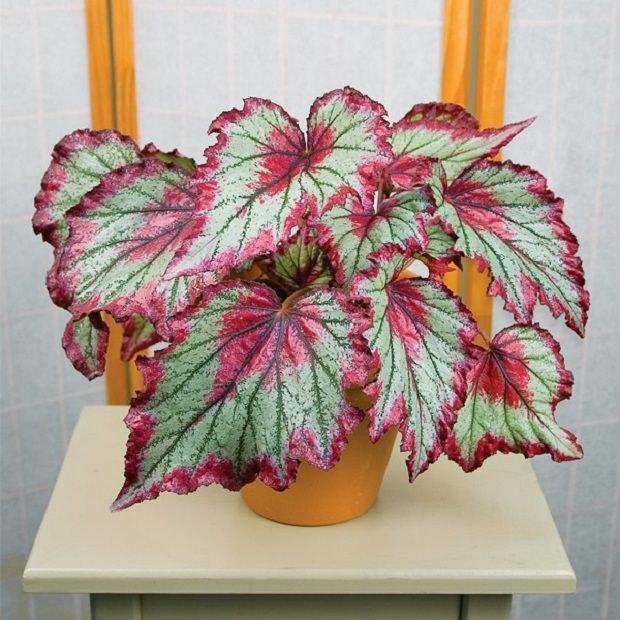
Rex begonias are best-looking begonias out there. Too showy, if you want to add a sparkle to your interior, grow them. Keeping in a bright shady spot in a well-drained medium, it’s important that you don’t overwater them.
20. Monstera Deliciosa
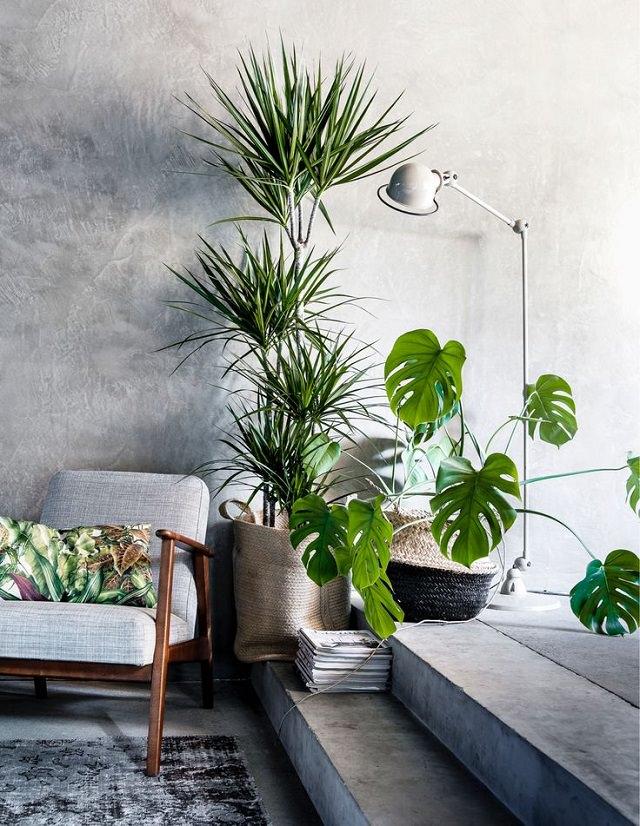
Monstera plant in a good looking pot standing beside a brightly painted wall in its supreme health displaying lush, oversized foliage of dark green color. You can imagine, it’ll look magnificent. Known as split leaf philodendron, you can also keep it in low light, for best result place it near a window where it’ll receive indirect sunlight all day long.
21. Schefflera (Umbrella Tree)
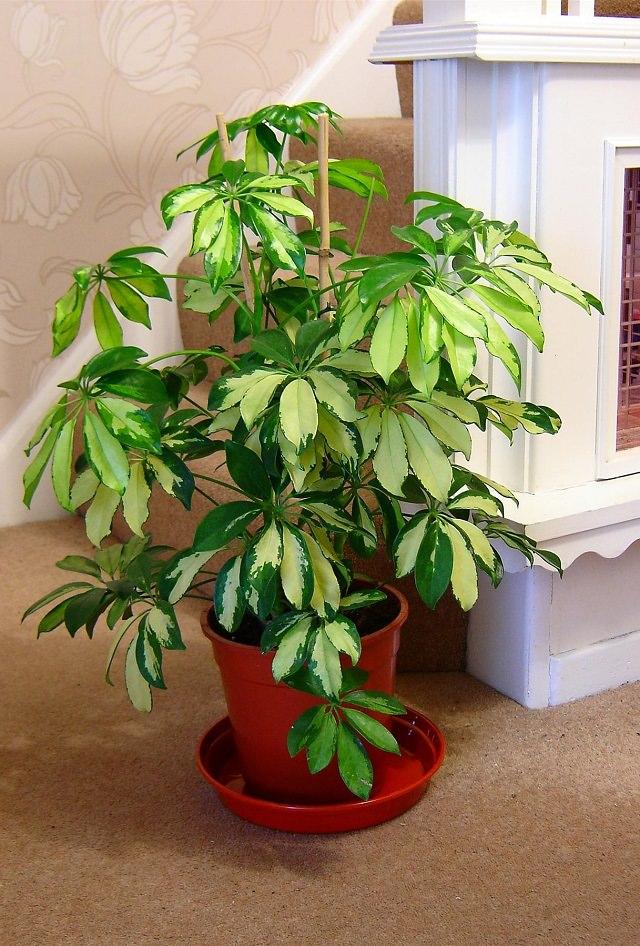
If you’re searching for a tall houseplant to improve the look of your interior, Schefflera is a good choice. Schefflera is finicky about its light requirements and doesn’t like direct sun but this doesn’t mean you can keep it in dim light, a spot near a window that receive indirect sunlight most of the time and have proper air circulation is what it demands. Watering should be done moderately.
22. Streptocarpus
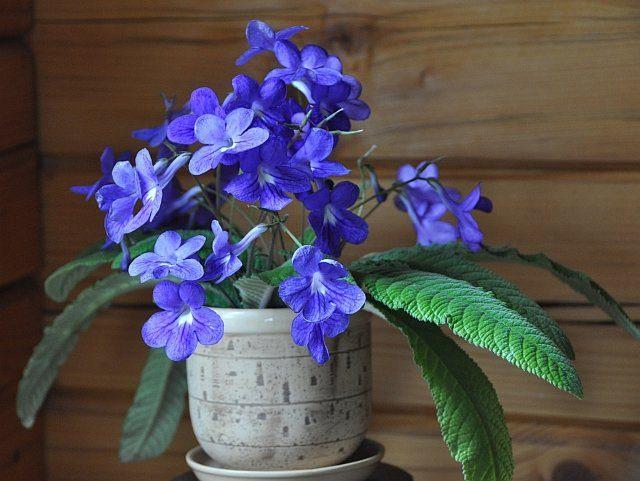
Streptocarpus, better known as the cape primrose is related to the African Violets; it prefers the same growing conditions of indirect light or filtered sunlight and moderately watered soil. Its velvety, deep green leaves and eye-catchy floral clusters hovering above the underlying foliage create a stunning appeal, which makes it perfect for adorning a secluded corner of a drawing room or adding a dash of color to an otherwise, dull space.
23. String of Pearls

The string of pearls is an easy-care succulent plant. It looks stunning in hanging baskets, trailing down. It is drought tolerant so you don’t need to water frequently, once in every other week would be enough.
24. Pleomele (Song of India)
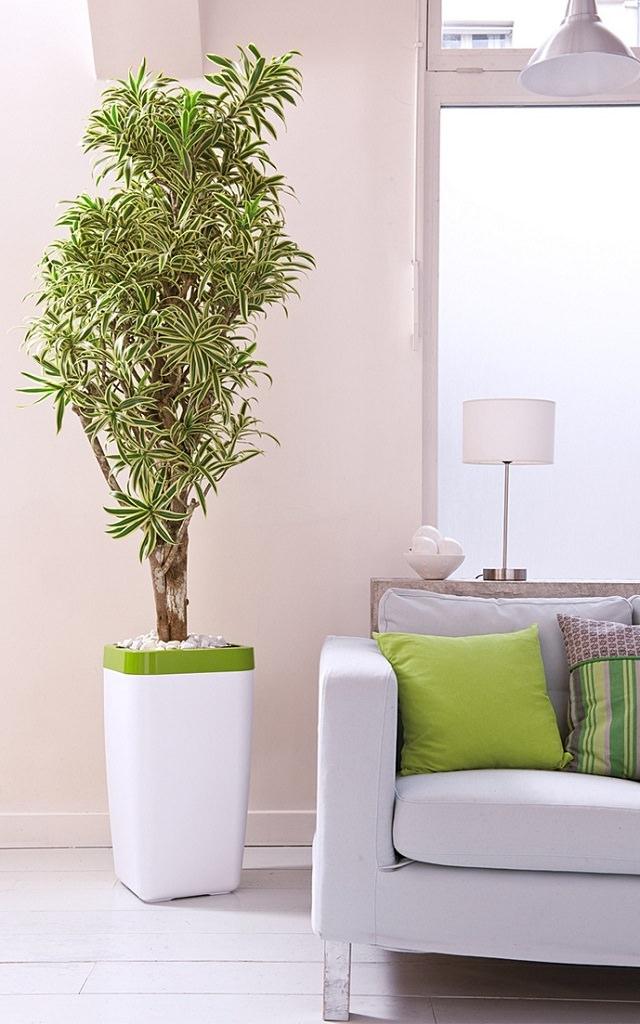
Dracaena reflexa like other plants of this genus is an easy-care houseplant. It’s one of the most ornamental dracaenas; the leaves have solid green color in the middle and a line of lime-yellow color on sides. Good for tabletops and plant stands as pleomele is a slow growing plant.
25. Brazilian Fireworks
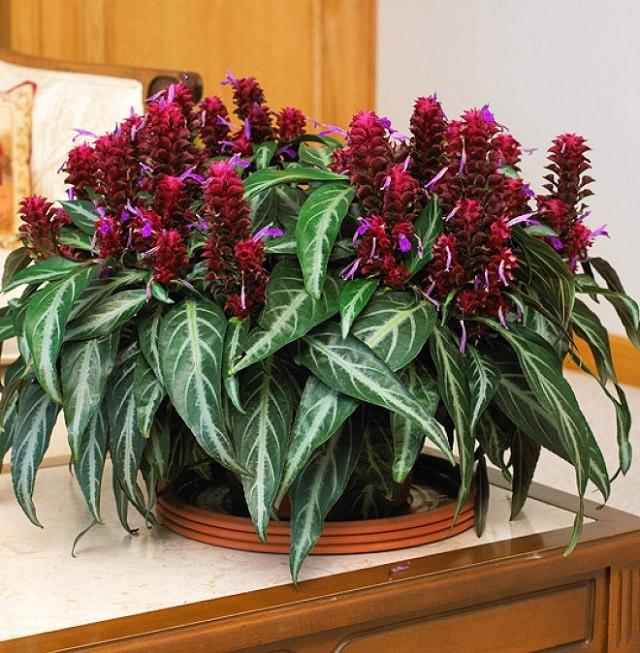
Whether you use this gorgeous tropical plant indoors, or in warm, shade gardens (if living in USDA zones 9-11), the Brazilian fireworks is a year-round delight with or without its flowers. This shade-loving plant is DEMANDING but thrives best when subjected to bright, indirect sunlight and occasional watering.
26. Peace lily
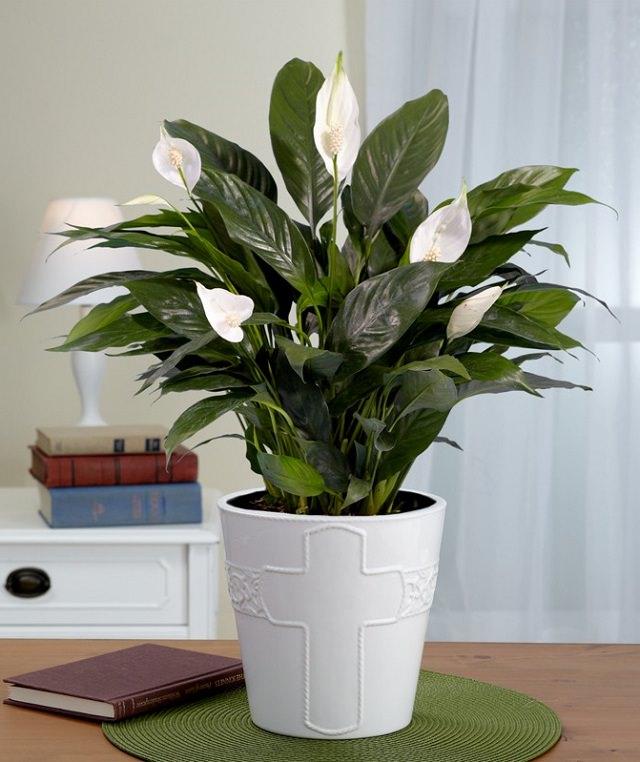
The peace lily is an attractive, low maintenance, air cleaning houseplant. This plant bears showy, spoon-shaped white spathe amidst a spike of white flower. Peace Lily survives best in a shady environment and easily tackle the absence of light.
27. Crown of Thorns
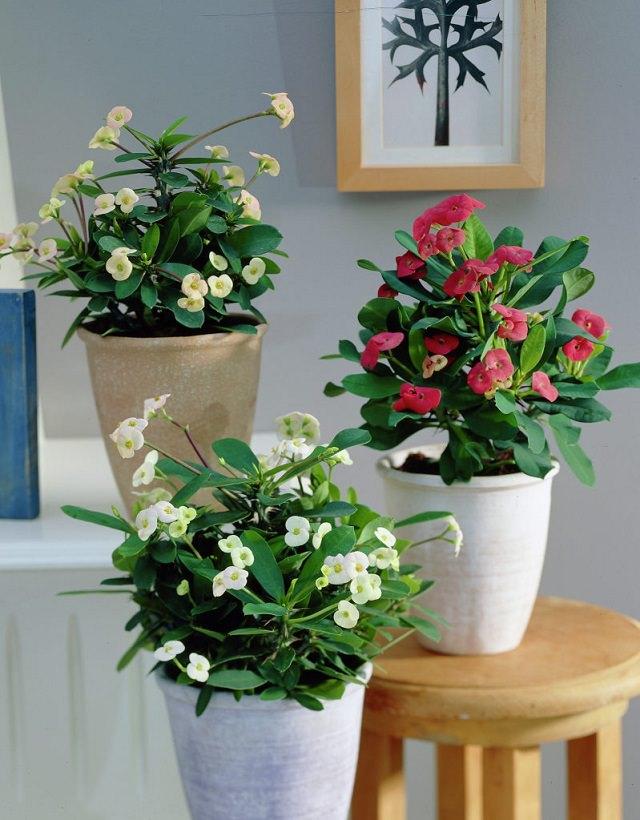
This lovely poinsettia relative is quite tolerant of neglect and thrives well as long as you place it in a bright spot and keep it in drier side. Appreciated for its showy flowers and thick, grayish-green leaves, it is a popular choice for indoor gardening.
28. Money Tree (Pachira Aquatica)

Tall, fat trunk, glossy-large foliage, the money tree is indeed a substitute for the fiddle leaf fig. Only a few indoor trees can become that tall. Also, it’s a low-maintenance houseplant. If you want to learn how to grow Pachira Aquatica indoors, click here!
29. African Violet

African violets are among the most easy-to-care flowering houseplants. They produce delicate, mauve flowers with little effort from your side. You can choose from several varieties, right from the white-edged blooms to the variegated foliage forms.

This demanding houseplant looks gorgeous due to its striking leaves. Picky about watering and dry indoor air and cold drafts. You must need to keep balance in watering.
2. Croton

The bold and bodacious houseplant that is low maintenance too. The mix of yellow, amber, and orange color linear markings on thick dark green foliage, croton looks stunning. To grow, keep it in a spot that receives bright indirect light most of the time and water sporadically.
3. Calathea

Lovely plant, great to look at! Many varieties are available in astonishing color combinations and patterns. This tropical houseplant doesn’t mind low light conditions. Keep it in warm, normal room temperature, saving from cold drafts. It likes humid surroundings and moderate watering.
4. Pencil Cactus

This unusual looking astonishing plant is notorious for its toxic milky sap (take care when handling this plant); still, it’s getting popular as a houseplant. Pencil cactus has medium to high light requirements and low watering needs; it also doesn’t mind dry air. Watering 2-3 times in a month is sufficient. To grow, keep the plant in a spot with ample light, a shaft of sunlight for a few hours or even more and it would do fine.
5. Silver Vase Plant

Unusual but a beautiful indoor plant, the silver vase or “urn plant” belongs to bromeliad family. Overall, growing this houseplant is similar to others– Be careful with watering, provide bright indirect light.
6. Fiddle Leaf Fig

We couldn’t complete this list without adding fiddle leaf fig. Fiddle leaf is a tall, appealing houseplant with glossy, leathery foliage. This large houseplant can change the look of any room.
7. Aluminium Plant

This plant is known for the beautiful silver strips that look like a color of aluminum; these strips appear over the glossy green color of each leaf. One of the beautiful indoor plants it is low maintenance. Keep it in a cool shady spot that receives a few hours of bright indirect light, water only when soil is dry.
8. Red Aglaonema

This beautiful houseplant’s dark green leaves with streaks of red and pink make it look really adorable indoors. It is absolutely easy to grow like Chinese evergreen and tolerates low light conditions and drought.
9. Anthurium

Anthuriums are beautiful houseplants that bloom in alluring shades of white, pink red or lavender. With a rich color palette, long lifespan and low care requirements, they are good for those with a busy lifestyle. Anthurium produces more foliage when grown in low-light conditions, so it’s you keep this plant in a spot that receives indirect sunlight all day.
10. African Mask Plant

African Mask Plant with its dark green leaves and silvery-white veins can be easily mistaken for an artificial plant. This plant needs moderate watering and a bright position away from direct sunlight. Clean the leaves every few days to keep the plant looking attractive and healthy.
11. Prayer Plant

With its beautifully patterned oblong foliage and low care requirements, this exotic houseplant is a lovely addition to any home. It requires bright light, moderate watering, and warm room temperature when it’s grown indoors. One interesting fact about this houseplant is that it folds up its leaves in the night or in the dark place.
12. Bird’s Nest Fern

Native to Southeast Asia, bird’s nest fern (Asplenium nidus) is easy to grow if the proper conditions are given—mainly warmth and humidity. Bright indirect light and temperature around 70 F are optimum for growing bird’s nest fern indoors. Visit HGTV to learn more growing this!
13. Adenium

If you live in a warm climate and have a South or West facing window in your room, this is the plant you need to grow. Except for its sunlight requirements, Adenium is a low maintenance houseplant and flowers heartily throughout the year in frost-free climates.
14. Fiber-Optic Grass

Fiber optic grass is a tropical grass that grows best in subtropical and tropical outdoor areas under USDA Zones (9-11), but it can be grown indoors in cooler regions too (We also added it to our list of BEST ORNAMENTAL GRASSES). Choose an ALLURING pot that will accentuate the beauty of this exotic grass, place it in a warm spot that receives bright light, and keep the soil slightly moist.
15. Ti Plant

Purple foliage with streaks of blazing pink, the Ti plant looks hot and gorgeous. You can grow this plant for year around foliage attraction. This plant is drought tolerant but has a high light requirement, indoors, it must be kept somewhere where it can absorb direct and indirect light both.
16. Oxalis

Oxalis belongs to a genus of edible, perennial plants characterized by striking mauve leaves and pink or white blooms. It prefers medium-to-bright light and performs better when grown in evenly moist soil.
17. Ponytail Palm

Ponytail Palm is an exotic succulent plant. It looks so interesting, one of the low maintenance plants as it has low watering needs and grows slowly, which means you don’t need to repot it frequently.
18. Poinsettia

Poinsettias and holiday decorations go hand in hand. This plant looks stunning with or without blooms due to its colorful bracts and foliage. To remain healthy, cheery, and colorful, it needs a bright spot, a couple of hours of morning sunlight and indirect light all day long is sufficient. A draft-free place is best, watering when the soil is dry is required.
19. Rex Begonia

Rex begonias are best-looking begonias out there. Too showy, if you want to add a sparkle to your interior, grow them. Keeping in a bright shady spot in a well-drained medium, it’s important that you don’t overwater them.
20. Monstera Deliciosa

Monstera plant in a good looking pot standing beside a brightly painted wall in its supreme health displaying lush, oversized foliage of dark green color. You can imagine, it’ll look magnificent. Known as split leaf philodendron, you can also keep it in low light, for best result place it near a window where it’ll receive indirect sunlight all day long.
21. Schefflera (Umbrella Tree)

If you’re searching for a tall houseplant to improve the look of your interior, Schefflera is a good choice. Schefflera is finicky about its light requirements and doesn’t like direct sun but this doesn’t mean you can keep it in dim light, a spot near a window that receive indirect sunlight most of the time and have proper air circulation is what it demands. Watering should be done moderately.
22. Streptocarpus

Streptocarpus, better known as the cape primrose is related to the African Violets; it prefers the same growing conditions of indirect light or filtered sunlight and moderately watered soil. Its velvety, deep green leaves and eye-catchy floral clusters hovering above the underlying foliage create a stunning appeal, which makes it perfect for adorning a secluded corner of a drawing room or adding a dash of color to an otherwise, dull space.
23. String of Pearls

The string of pearls is an easy-care succulent plant. It looks stunning in hanging baskets, trailing down. It is drought tolerant so you don’t need to water frequently, once in every other week would be enough.
24. Pleomele (Song of India)

Dracaena reflexa like other plants of this genus is an easy-care houseplant. It’s one of the most ornamental dracaenas; the leaves have solid green color in the middle and a line of lime-yellow color on sides. Good for tabletops and plant stands as pleomele is a slow growing plant.
25. Brazilian Fireworks

Whether you use this gorgeous tropical plant indoors, or in warm, shade gardens (if living in USDA zones 9-11), the Brazilian fireworks is a year-round delight with or without its flowers. This shade-loving plant is DEMANDING but thrives best when subjected to bright, indirect sunlight and occasional watering.
26. Peace lily

The peace lily is an attractive, low maintenance, air cleaning houseplant. This plant bears showy, spoon-shaped white spathe amidst a spike of white flower. Peace Lily survives best in a shady environment and easily tackle the absence of light.
27. Crown of Thorns

This lovely poinsettia relative is quite tolerant of neglect and thrives well as long as you place it in a bright spot and keep it in drier side. Appreciated for its showy flowers and thick, grayish-green leaves, it is a popular choice for indoor gardening.
28. Money Tree (Pachira Aquatica)

Tall, fat trunk, glossy-large foliage, the money tree is indeed a substitute for the fiddle leaf fig. Only a few indoor trees can become that tall. Also, it’s a low-maintenance houseplant. If you want to learn how to grow Pachira Aquatica indoors, click here!
29. African Violet

African violets are among the most easy-to-care flowering houseplants. They produce delicate, mauve flowers with little effort from your side. You can choose from several varieties, right from the white-edged blooms to the variegated foliage forms.
2
0
文章
Gina
2017年05月23日


If your vision of growing cactus involves a dry desert look, think again. Cactus and succulents are one of the hottest garden trends going on right now, and we all should give them a little look. Live in a northern climate and don’t think you can grow them? We cover that too. Here’s how to grow cactus, and some great inspiration in using them as a modern design element to update any garden or landscaping .
Basics Needs of Cactus
First of all, when most of us think of cactus, we think of the varieties meant for desert environments. While there are many beautiful ones that grow down south, most people don’t know that there are several hardy varieties as well. Check with your local nursery, then check out our guidelines for growing in northern gardens. So number one is that they need to be well matched with their planting zone.
Second, all cacti need well drained soil. Grow them in a mix of 50 percent soil to 50 percent coarse sand. If growing in containers, use a commercially available cacti mix.
They need very little water. If you live in an area that gets rain in the summer, than that is probably all they need. If they grow in containers, let them dry out completely before watering.
They need little fertilizer. For blooming varieties, you may wish to give them a diluted drink of liquid fertilizer just as they start setting buds.
They need full sun. Duh.
Growing them in the North
So the only trick to growing cacti in the north is to grow the proper varieties. Better Homes and Gardens has a good article on just that right here.
Contain Your Cactus
If you don’t want to be held back by your climate, keep in mind cacti do well in containers. They can be brought inside during the winter to a sun room or other bright warm space. Three tips for you…
Use gloves. Another duh.
Use a well drained soil mix made for cacti.
Don’t over water.
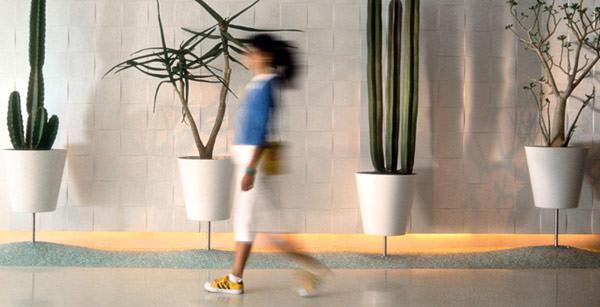
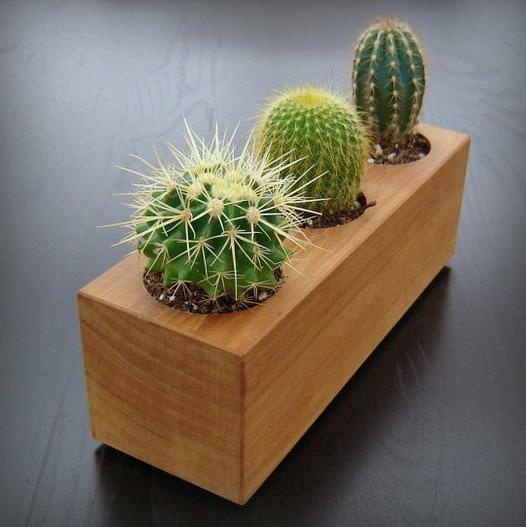
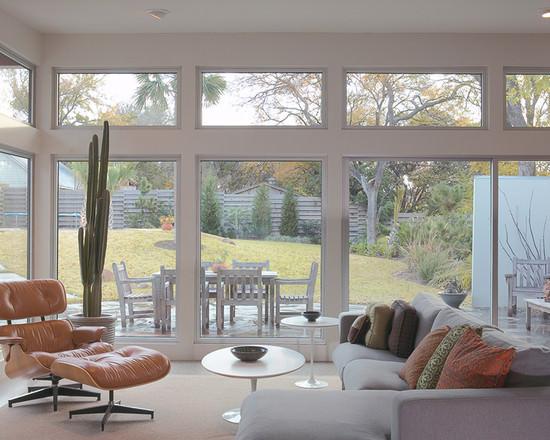
Texture, Design and Interest
So here is where the appreciation for cacti comes in. Fewer plants on this earth have such amazing adaptive qualities. They are a lesson in form and function, in the beauty of Mother Nature and a lesson in her harshness as well. Used in a repeat pattern they are an exceptional design element. Nothing adds more texture and interest to a garden. Aren’t convinced? Check out these inspiring photos.
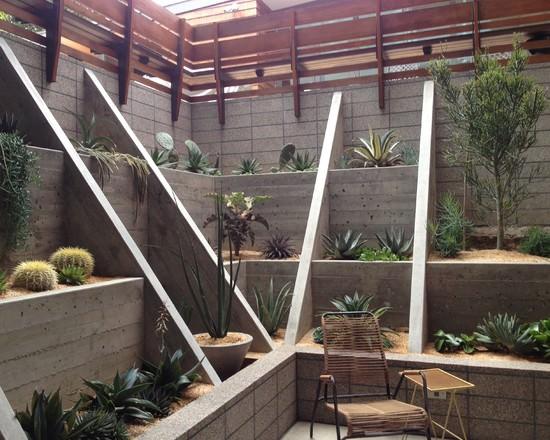
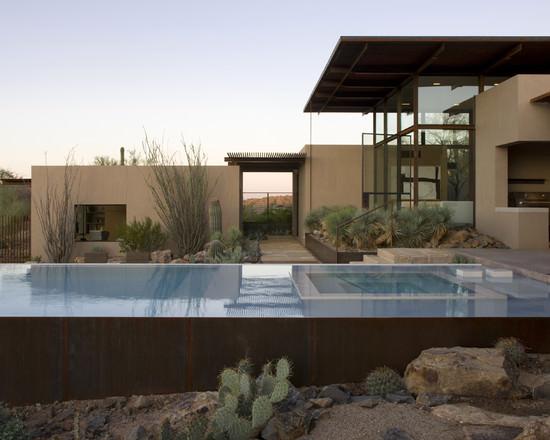
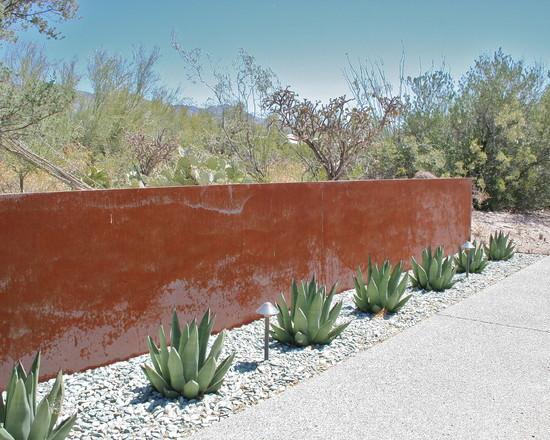

Growing cactus can be an adventure in modern gardening, and can be the beginning of a whole new obsession no matter where you live!
0
0
文章
安静的美女子
2017年05月23日

Learn how to care for lipstick plant. Lipstick plant care is simple, all it requires is constantly warm temperature and humid surrounding to grow and thrive.
Lipstick plant (Aeschynanthus radicans) is native to Indonesia and Malaysia. It is an epiphyte— a delicate, tropical vine that can also be grown as houseplant and excellent for use in hanging baskets on a shady balcony or patio.

USDA Zones– 10 – 12
Difficulty– Easy to Moderate
Lipstick Plant Characteristics
Its leaves are green, ovate, opposite, waxy and somewhat succulent like. Arranged in long, tanned and thin branches. The inflorescence appear are terminal, with flowers of tubular corolla like a cylindrical cup, with colors ranging from bright red to purplish-brown. The flower resembles a lipstick and that’s why it is called “Lipstick Plant”. The flowers have pungent aroma and are attractive to sunbirds and hummingbirds.
Lipstick Plant Propagation
Lipstick plant propagation can be done from cuttings or from seeds. Best propagation time is when temperature is around 70 F (21 C).
Requirements for Growing Lipstick PlantLocation
Must be grown in dappled shade, always protected from direct sun but under full indirect light. Location must not be windy or cool. Keep the plant above 60 F (15 C). It can be grown tropical climate in USDA Zones 10b – 12 but below these zones, you need to be careful as the lipstick plant is not frost tolerant and likes to grow in constantly warm temperature between 65 to 85 F (18 – 30 C)
Once established do not change the location of plant again and again.
Soil
Grow it in fertile, well draining and airy substrate that is rich in humus, peat moss or cocopeat.
Watering
Water whenever the surface begins to dry. Soak the entire pot every time. Water regularly in summer to keep the root ball moist. In winter, reduce the watering. Be careful with watering in cooler climates, in winter watering should be almost suspended as it can cause root rot.
It prefers non-calcareous lukewarm water, best to water it with distilled or rain water if possible.
Lipstick Plant Care
Lipstick plant care is simple, all it requires is constantly warm temperature and humid surrounding to grow and thrive.
Fertilizer
Feed the plant once a month using 3-1-2 ratio liquid fertilizer, such as 9-3-6 diluted at half strength recommended. Make sure to water plant before fertilizing to avoid root burn. Stop fertilizing in late fall and resume again in early spring.
Pruning
Prune it after it finishes flowering. Cut each branch to a length of about 6 inches using a sharp pair of scissors.
Pinching
The tip of the branches should be pinched regularly to encourage dense growth.
Pests, Diseases and Problems during Lipstick Plant Care
Generally, it is not susceptible to diseases. Root rot is possible if plant is overwatered in winter. In pests it might be attacked by aphids, red spider mite, mealybugs and whiteflies.
If you’re growing lipstick plant indoors keep it moist but avoid excess watering. Place it on a ventilated place with good air circulation and bright indirect light.
Lipstick Plant Losing Leaves
Lipstick plant (Aeschynanthus radicans) is native to Indonesia and Malaysia. It is an epiphyte— a delicate, tropical vine that can also be grown as houseplant and excellent for use in hanging baskets on a shady balcony or patio.

USDA Zones– 10 – 12
Difficulty– Easy to Moderate
Lipstick Plant Characteristics
Its leaves are green, ovate, opposite, waxy and somewhat succulent like. Arranged in long, tanned and thin branches. The inflorescence appear are terminal, with flowers of tubular corolla like a cylindrical cup, with colors ranging from bright red to purplish-brown. The flower resembles a lipstick and that’s why it is called “Lipstick Plant”. The flowers have pungent aroma and are attractive to sunbirds and hummingbirds.
Lipstick Plant Propagation
Lipstick plant propagation can be done from cuttings or from seeds. Best propagation time is when temperature is around 70 F (21 C).
Requirements for Growing Lipstick PlantLocation
Must be grown in dappled shade, always protected from direct sun but under full indirect light. Location must not be windy or cool. Keep the plant above 60 F (15 C). It can be grown tropical climate in USDA Zones 10b – 12 but below these zones, you need to be careful as the lipstick plant is not frost tolerant and likes to grow in constantly warm temperature between 65 to 85 F (18 – 30 C)
Once established do not change the location of plant again and again.
Soil
Grow it in fertile, well draining and airy substrate that is rich in humus, peat moss or cocopeat.
Watering
Water whenever the surface begins to dry. Soak the entire pot every time. Water regularly in summer to keep the root ball moist. In winter, reduce the watering. Be careful with watering in cooler climates, in winter watering should be almost suspended as it can cause root rot.
It prefers non-calcareous lukewarm water, best to water it with distilled or rain water if possible.
Lipstick Plant Care
Lipstick plant care is simple, all it requires is constantly warm temperature and humid surrounding to grow and thrive.
Fertilizer
Feed the plant once a month using 3-1-2 ratio liquid fertilizer, such as 9-3-6 diluted at half strength recommended. Make sure to water plant before fertilizing to avoid root burn. Stop fertilizing in late fall and resume again in early spring.
Pruning
Prune it after it finishes flowering. Cut each branch to a length of about 6 inches using a sharp pair of scissors.
Pinching
The tip of the branches should be pinched regularly to encourage dense growth.
Pests, Diseases and Problems during Lipstick Plant Care
Generally, it is not susceptible to diseases. Root rot is possible if plant is overwatered in winter. In pests it might be attacked by aphids, red spider mite, mealybugs and whiteflies.
If you’re growing lipstick plant indoors keep it moist but avoid excess watering. Place it on a ventilated place with good air circulation and bright indirect light.
Lipstick Plant Losing Leaves
2
0
Maria Manuel:mine's
Maria Manuel:mind's loosing buds & flowers...what should I do? (...bought it 2 days ago...)
文章
Colorful
2017年05月23日

New to growing plants and no idea what you should grow indoors? Learn about these 15 Best Houseplants for Beginners. They all are easy to grow!
Potted houseplants provide a lavish look and can be used to decorate the interior at low cost. Also, they create positive impact and many of them purify the air. But what you’ll do if you don’t have much knowledge about growing plants and the houseplants that are best to grow? Simple! Learn about these 15 Best Houseplants for Beginners! They are easy to grow and tolerate poor conditions.
1. Snake Plant
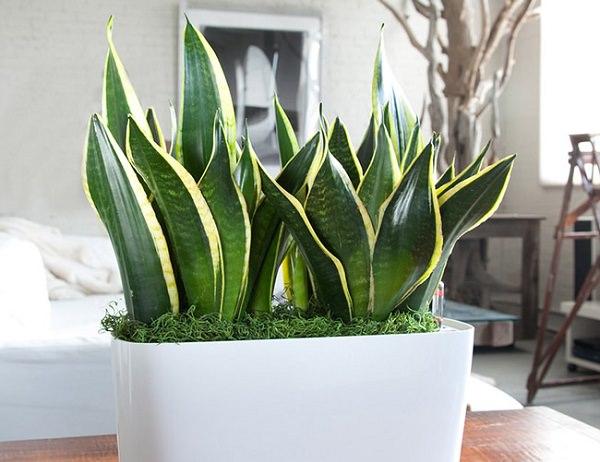
Snake plant is one of the best plants for the beginners. Easy to grow and hard to kill, it can be grown in low light and need to be watered occasionally. Snake plant also removes toxins from the air– All this makes it a perfect houseplant for beginners.
2. Heartleaf Philodendron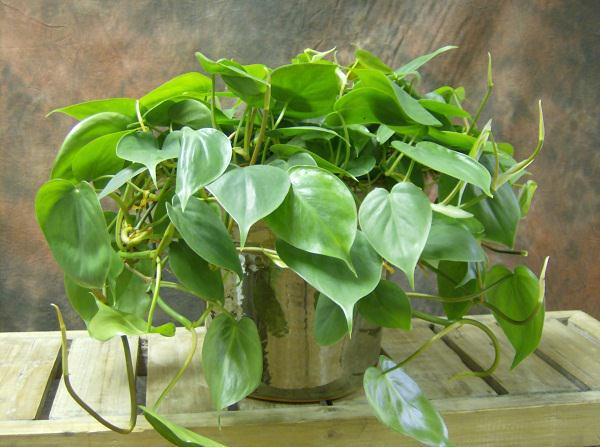
Philodendron scandens is extremely easy to grow and great for beginners. It needs a moderate amount of light and prefers the soil to dry out between watering spells.
3. Spider Plant
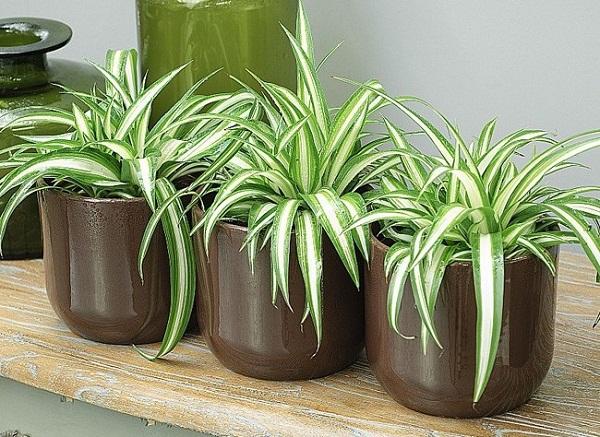
One of the most popular houseplants. Its popularity is due to its toughness and the ease of growing and maintenance. The plant can easily adapt to almost any condition. Keep the plant in a bright spot and maintain slight moisture in the soil and it will grow happily.
4. Peace Lily

The peace lily is among the easiest plants to grow indoors. It can tolerate a wide range of lighting conditions, and needs only moderate watering. With graceful curving leaves and white flower that rise up from the dark foliage, peace lily looks exotic and elegant.
5. English Ivy
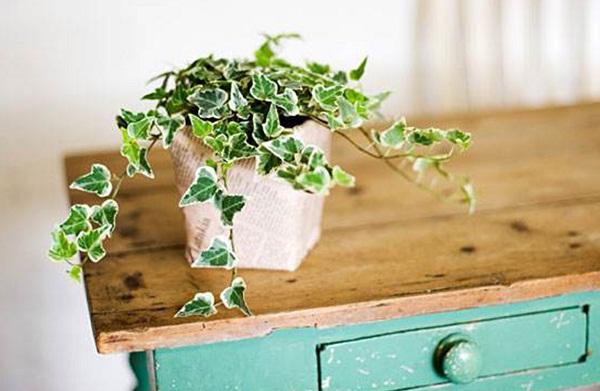
English Ivy is very hardy and easy to grow. Keep the pot in a spot that receives bright indirect sun and plant it in a container that is wide and shallow rather than narrow and deep.
6. Succulents and Cactus

Succulents and cacti are ideal for those who forget to water and care for plants. They are very adaptable and can survive many adverse conditions.
They need to be placed on a bright spot and a well-drained soil with little water.
7. Lucky Bamboo
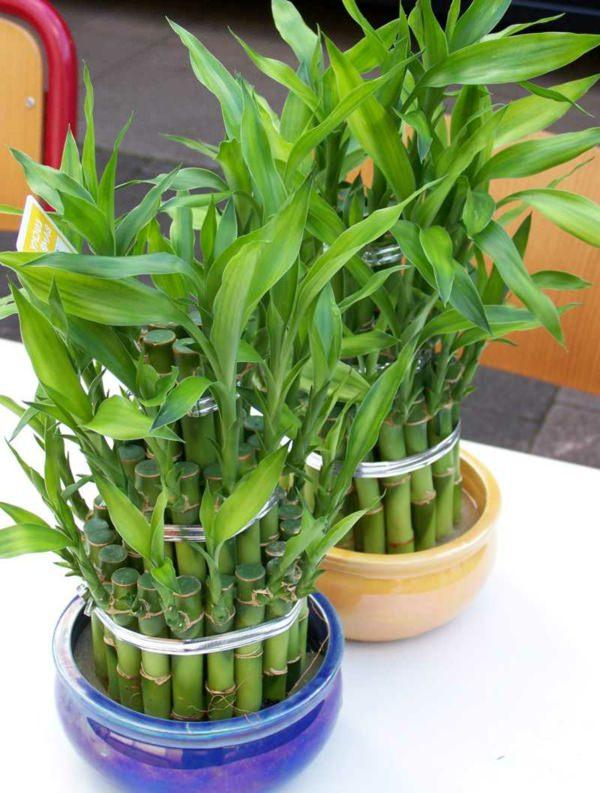
Lucky bamboo is not a bamboo, but a plant belongs to Dracaena genus. It is an easy-care houseplant. Just provide it abundant water and it’ll grow well even in indirect light. Protect the plant from cold drafts and provide iron fertilizer occasionally.
8. Jade Plant
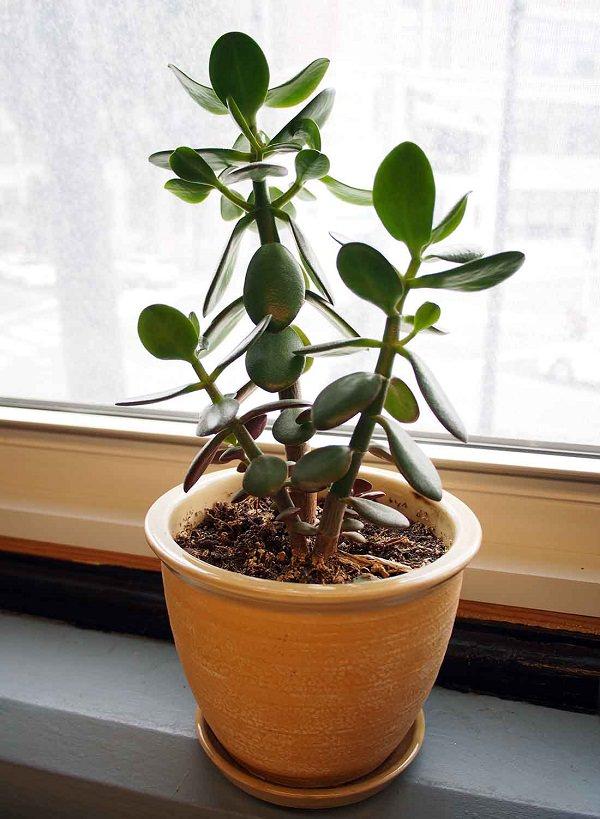
Jade plant is a succulent and is probably one of the best houseplants for beginners. When grown indoors, a jade plant can grow up to a size of a small shrub. Keep the plant in a spot that receives partial or indirect sunlight from having a healthy specimen.
9. Cast Iron Plant
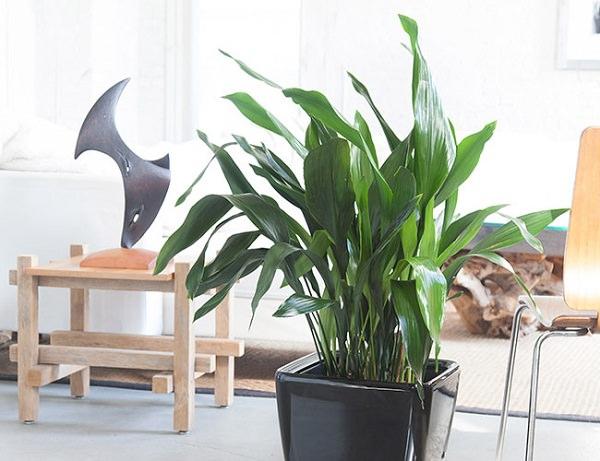
As the name suggest, one of the toughest plants that make it ideal for beginners. Cast-iron plant can withstands neglect, low light, low humidity, and a wide range of temperatures. It prefers moist soil.
10. Peperomia

Credit: Houseplants Expert
Another good plant for beginners is Peperomia. Peperomia is small striking houseplant that is available in different colors and shapes. Peperomia likes slightly moist soil and humidity but watering should be reduced in winter.
11. ZZ Plant
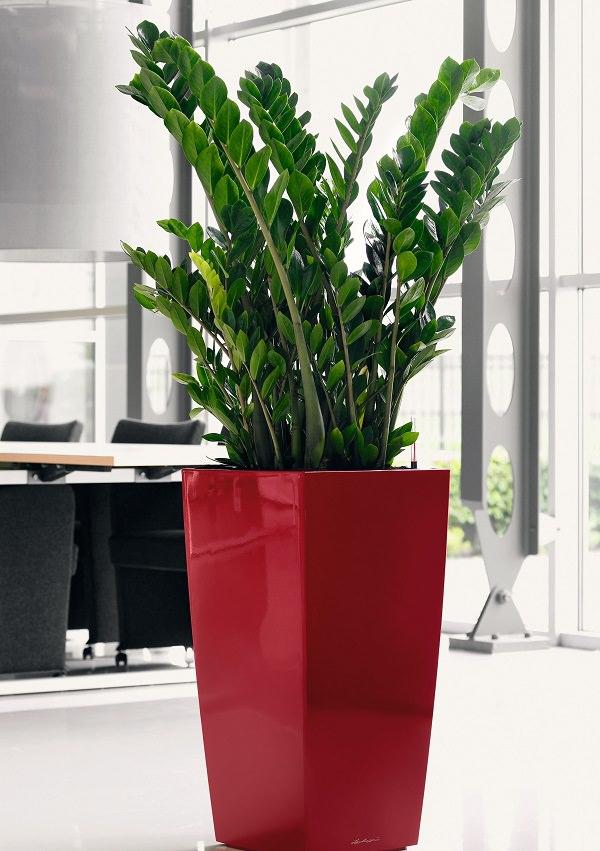
This super-tough plant is high resistant to adverse conditions like drought and low light. The plant prefers bright to moderate indirect light and well-drained soil. ZZ plant can do fine without fertilizer, but if you would like, you can fertilize the plant with half strength general fertilizer one to two times a year in the summer months.
12. Pothos (Devil’s Ivy)
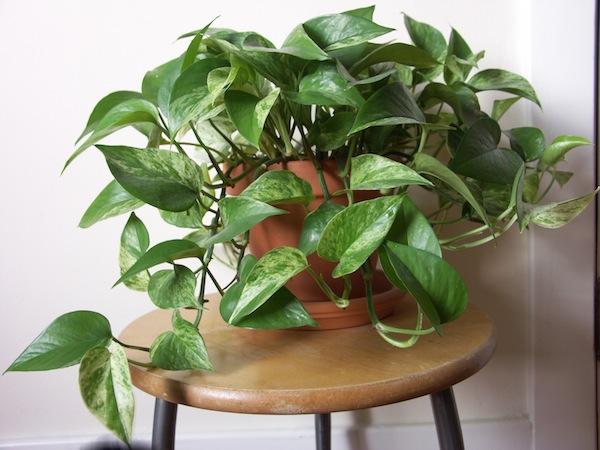
Plants of the pothos family are easy to grow and become great houseplants for beginners. This attractive and durable vine prefers bright indirect light and a draft free place. It can grow in low light and needs moist soil.
13. Dracaena
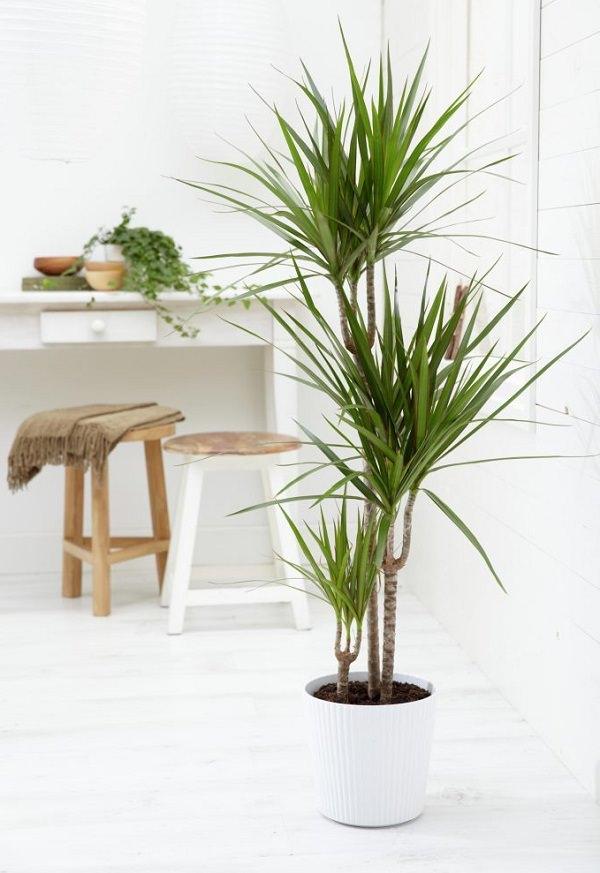
There are many varieties of Dracaena genus that are hardy houseplants, Dracaena marginata, Dracaena fragrans are among the most popular and easy to grow plants. This beautiful houseplant needs occasional pruning and regular watering. Keep the plant away from direct sun and avoid overwatering.
14. Bromeliads
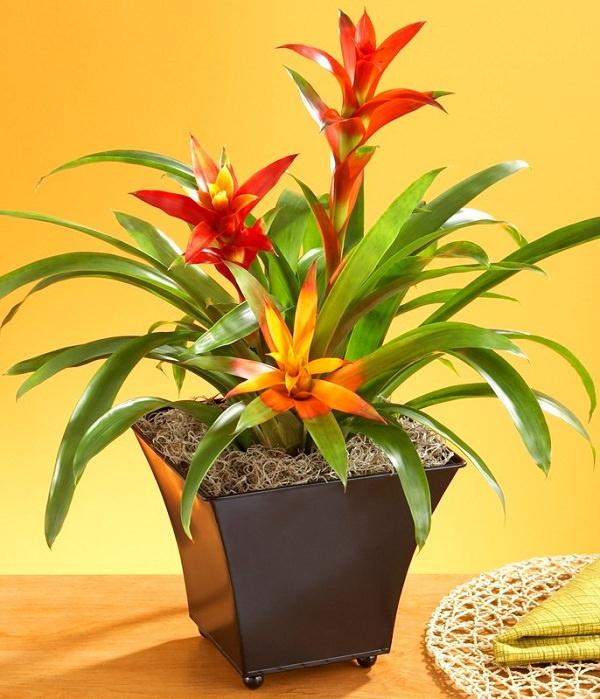
Bromeliad is a perfect plant to grow indoors, most of the varieties of this plant thrive easily indoors. Although it is difficult to make it bloom, there are many varieties that have beautiful foliage that makes an attractive display.
15. Rubber Plant
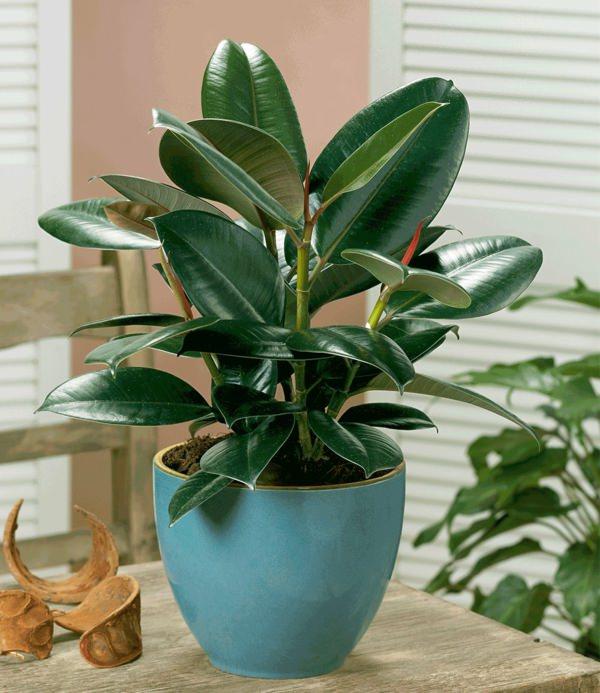
Rubber plant is a large houseplant that can become a focal point to any room. Low maintenance and easy to grow. Keep it in a well-lit position in your home and allow the soil to dry out between watering spells. Besides the ornamental aspect, rubber plant is also an air purifying plant.
Potted houseplants provide a lavish look and can be used to decorate the interior at low cost. Also, they create positive impact and many of them purify the air. But what you’ll do if you don’t have much knowledge about growing plants and the houseplants that are best to grow? Simple! Learn about these 15 Best Houseplants for Beginners! They are easy to grow and tolerate poor conditions.
1. Snake Plant

Snake plant is one of the best plants for the beginners. Easy to grow and hard to kill, it can be grown in low light and need to be watered occasionally. Snake plant also removes toxins from the air– All this makes it a perfect houseplant for beginners.
2. Heartleaf Philodendron

Philodendron scandens is extremely easy to grow and great for beginners. It needs a moderate amount of light and prefers the soil to dry out between watering spells.
3. Spider Plant

One of the most popular houseplants. Its popularity is due to its toughness and the ease of growing and maintenance. The plant can easily adapt to almost any condition. Keep the plant in a bright spot and maintain slight moisture in the soil and it will grow happily.
4. Peace Lily

The peace lily is among the easiest plants to grow indoors. It can tolerate a wide range of lighting conditions, and needs only moderate watering. With graceful curving leaves and white flower that rise up from the dark foliage, peace lily looks exotic and elegant.
5. English Ivy

English Ivy is very hardy and easy to grow. Keep the pot in a spot that receives bright indirect sun and plant it in a container that is wide and shallow rather than narrow and deep.
6. Succulents and Cactus

Succulents and cacti are ideal for those who forget to water and care for plants. They are very adaptable and can survive many adverse conditions.
They need to be placed on a bright spot and a well-drained soil with little water.
7. Lucky Bamboo

Lucky bamboo is not a bamboo, but a plant belongs to Dracaena genus. It is an easy-care houseplant. Just provide it abundant water and it’ll grow well even in indirect light. Protect the plant from cold drafts and provide iron fertilizer occasionally.
8. Jade Plant

Jade plant is a succulent and is probably one of the best houseplants for beginners. When grown indoors, a jade plant can grow up to a size of a small shrub. Keep the plant in a spot that receives partial or indirect sunlight from having a healthy specimen.
9. Cast Iron Plant

As the name suggest, one of the toughest plants that make it ideal for beginners. Cast-iron plant can withstands neglect, low light, low humidity, and a wide range of temperatures. It prefers moist soil.
10. Peperomia

Credit: Houseplants Expert
Another good plant for beginners is Peperomia. Peperomia is small striking houseplant that is available in different colors and shapes. Peperomia likes slightly moist soil and humidity but watering should be reduced in winter.
11. ZZ Plant

This super-tough plant is high resistant to adverse conditions like drought and low light. The plant prefers bright to moderate indirect light and well-drained soil. ZZ plant can do fine without fertilizer, but if you would like, you can fertilize the plant with half strength general fertilizer one to two times a year in the summer months.
12. Pothos (Devil’s Ivy)

Plants of the pothos family are easy to grow and become great houseplants for beginners. This attractive and durable vine prefers bright indirect light and a draft free place. It can grow in low light and needs moist soil.
13. Dracaena

There are many varieties of Dracaena genus that are hardy houseplants, Dracaena marginata, Dracaena fragrans are among the most popular and easy to grow plants. This beautiful houseplant needs occasional pruning and regular watering. Keep the plant away from direct sun and avoid overwatering.
14. Bromeliads

Bromeliad is a perfect plant to grow indoors, most of the varieties of this plant thrive easily indoors. Although it is difficult to make it bloom, there are many varieties that have beautiful foliage that makes an attractive display.
15. Rubber Plant

Rubber plant is a large houseplant that can become a focal point to any room. Low maintenance and easy to grow. Keep it in a well-lit position in your home and allow the soil to dry out between watering spells. Besides the ornamental aspect, rubber plant is also an air purifying plant.
0
2
文章
扭扭
2017年05月23日

Learn how to grow cucumbers vertically to get the most productive plant. Growing cucumbers vertically also save lot of space, which is suitable for small gardens.
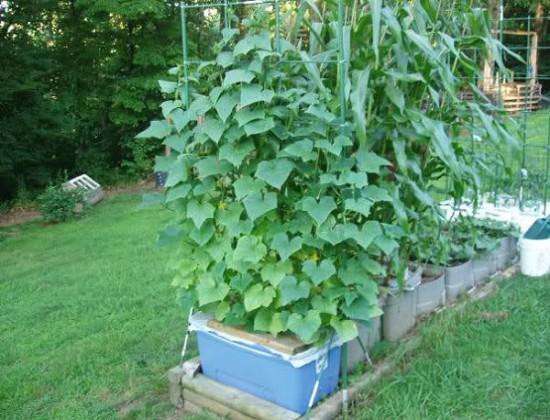
Cucumber is a refreshing vegetable, especially if picked up fresh. It is eaten in variety of ways: raw in salad, cooked or pickled. It is easy to grow and only requires a warm, sunny exposure and deep and regular watering.
What if you want to grow cucumbers but you have a small garden. Definitely, it will take a lot of space. In that case growing cucumbers vertically is an space savvy option.
Benefits of Growing Cucumbers Vertically
One advantage of Growing Cucumbers Vertically is that by this you can avoid a common problem of fruit rot associated with cucumber cultivation, which happens when fruit sitting in moist soil for long period of time. When you allow cucumber vines to grow up vertically, it improves the air circulation around the plant that prevents fungal diseases. Cucumber plants have sprawling habit and growing cucumbers vertically allow their leaves to absorb more sun, which result in healthy plant and large cucumbers. One more key benefit is that you can harvest the fruits more easily and in time.
Why you should grow cucumbers vertically
When cucumbers grown horizontally they usually cover 10 – 20 sq ft of space, plant sprawls over the surface around it. However, smaller and bushier varieties take only 1/3 of this space but they produce less fruits. Climbing, vine type varieties are more productive and when you grow them vertically they barely take 1 sq ft of space, climbing up on the support of trellis.
How to Grow Cucumbers VerticallyChoosing Container and Trellis
If you’re growing cucumbers vertically in containers, prefer large containers that are about at least 12 inches deep and wide. How many cucumber plants you can grow in such a container depends on the variety you are planting. A vining variety grows tall and send long roots, whereas bushier varieties are short.
Trellis Size
Choose a 5 to 6 feet tall trellis that is sturdy and doesn’t topple. If growing climbing varieties use “A frame trellis” so that the plant crawl up and down from it easily.
Propagation and Planting Cucumbers
Sow seeds directly onto the desired spot or in small pots. Cover them with about 2 cm of soil. Once the seedlings germinate and have a few leaves, transplant the healthiest ones into a bigger pot or on the frost free ground in spring or summer when soil temperature is around 70 F (20 C). If you live in tropical or subtropical climate, you can grow cucumber year round.
Cucumber plant is a heavy feeder like tomatoes, prepare your soil well before planting by incorporating decomposed manure and compost.
Requirements for Growing Cucumbers VerticallyPosition
Cucumber loves a warm and sunny exposure that is less windy. It does not tolerate temperature below 50 F (10 C). Optimum temperature to grow cucumbers fall in the range of 60 – 95 F (15 – 35 C).
Soil
It prefers well drained, loose and deep soil, rich in organic matter and neutral in pH.
Watering
Regular and deep watering is the key of productive harvest, when growing cucumber. It is due to the high water content of its fruits. While watering, avoid wetting the foliage as it may encourage fungal diseases.
Mulching
Mulch around the base of plant to improve moisture retaining ability of soil.
Fertilizer
At the time of planting add all purpose slow release fertilizer in soil. Once the plant starts to flower, side dress the plant with aged manure. Also apply balanced liquid fertilizer at that time according to manufacturer’s instructions.
Diseases and Pests
Cucumber plants particularly suffer from anthracnose, powdery mildew and in pests look out for aphids.
HarvestWhen and how to harvest cucumbers?
Cucumbers are ready for harvest in 60 to 90 days after seed sowing, depending on the variety. Pick cucumbers when they are developed enough, do not
let the fruit to overripe.

Cucumber is a refreshing vegetable, especially if picked up fresh. It is eaten in variety of ways: raw in salad, cooked or pickled. It is easy to grow and only requires a warm, sunny exposure and deep and regular watering.
What if you want to grow cucumbers but you have a small garden. Definitely, it will take a lot of space. In that case growing cucumbers vertically is an space savvy option.
Benefits of Growing Cucumbers Vertically
One advantage of Growing Cucumbers Vertically is that by this you can avoid a common problem of fruit rot associated with cucumber cultivation, which happens when fruit sitting in moist soil for long period of time. When you allow cucumber vines to grow up vertically, it improves the air circulation around the plant that prevents fungal diseases. Cucumber plants have sprawling habit and growing cucumbers vertically allow their leaves to absorb more sun, which result in healthy plant and large cucumbers. One more key benefit is that you can harvest the fruits more easily and in time.
Why you should grow cucumbers vertically
When cucumbers grown horizontally they usually cover 10 – 20 sq ft of space, plant sprawls over the surface around it. However, smaller and bushier varieties take only 1/3 of this space but they produce less fruits. Climbing, vine type varieties are more productive and when you grow them vertically they barely take 1 sq ft of space, climbing up on the support of trellis.
How to Grow Cucumbers VerticallyChoosing Container and Trellis

If you’re growing cucumbers vertically in containers, prefer large containers that are about at least 12 inches deep and wide. How many cucumber plants you can grow in such a container depends on the variety you are planting. A vining variety grows tall and send long roots, whereas bushier varieties are short.
Trellis Size
Choose a 5 to 6 feet tall trellis that is sturdy and doesn’t topple. If growing climbing varieties use “A frame trellis” so that the plant crawl up and down from it easily.
Propagation and Planting Cucumbers
Sow seeds directly onto the desired spot or in small pots. Cover them with about 2 cm of soil. Once the seedlings germinate and have a few leaves, transplant the healthiest ones into a bigger pot or on the frost free ground in spring or summer when soil temperature is around 70 F (20 C). If you live in tropical or subtropical climate, you can grow cucumber year round.
Cucumber plant is a heavy feeder like tomatoes, prepare your soil well before planting by incorporating decomposed manure and compost.
Requirements for Growing Cucumbers VerticallyPosition
Cucumber loves a warm and sunny exposure that is less windy. It does not tolerate temperature below 50 F (10 C). Optimum temperature to grow cucumbers fall in the range of 60 – 95 F (15 – 35 C).
Soil
It prefers well drained, loose and deep soil, rich in organic matter and neutral in pH.
Watering
Regular and deep watering is the key of productive harvest, when growing cucumber. It is due to the high water content of its fruits. While watering, avoid wetting the foliage as it may encourage fungal diseases.
Mulching
Mulch around the base of plant to improve moisture retaining ability of soil.
Fertilizer
At the time of planting add all purpose slow release fertilizer in soil. Once the plant starts to flower, side dress the plant with aged manure. Also apply balanced liquid fertilizer at that time according to manufacturer’s instructions.
Diseases and Pests
Cucumber plants particularly suffer from anthracnose, powdery mildew and in pests look out for aphids.
HarvestWhen and how to harvest cucumbers?
Cucumbers are ready for harvest in 60 to 90 days after seed sowing, depending on the variety. Pick cucumbers when they are developed enough, do not
let the fruit to overripe.
1
0
文章
Colorful
2017年05月23日

Love the color purple? Then grow these 15 GORGEOUS purple houseplants known for their colorful foliage and warm texture!1. Purple Oxalis
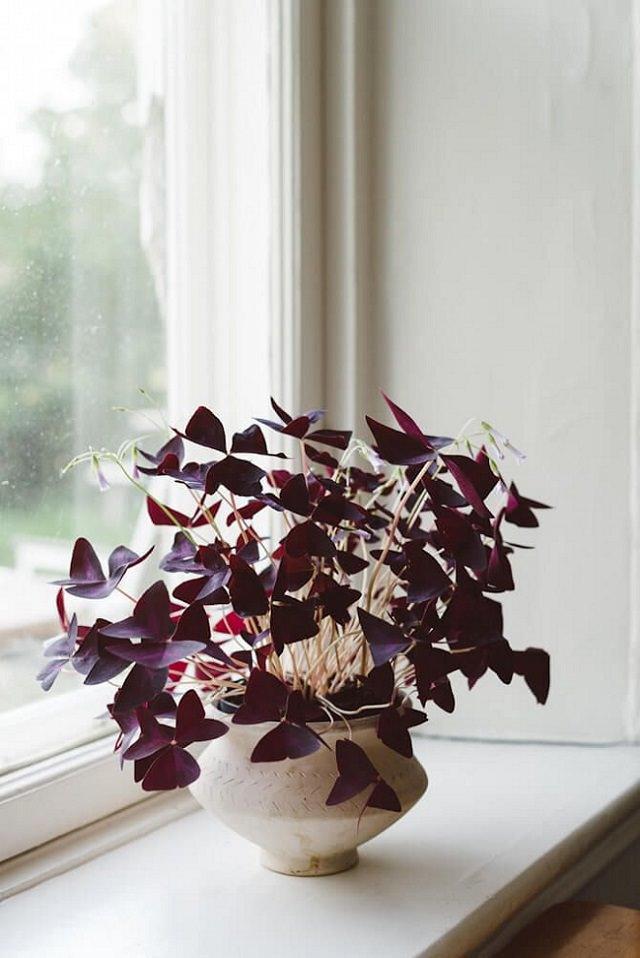
Native to Brazil, Oxalis plants display unique, pinwheel foliage and a wealth of starry blossoms. Some varieties produce purple leaves or foliage with deeper accent markings. Its delicate foliage and dainty flowers make it an ideal choice for containers and indoors alike. The tiny, triangular leaflets close at night, which make it a fun plant to have around the house.
2. Coleus
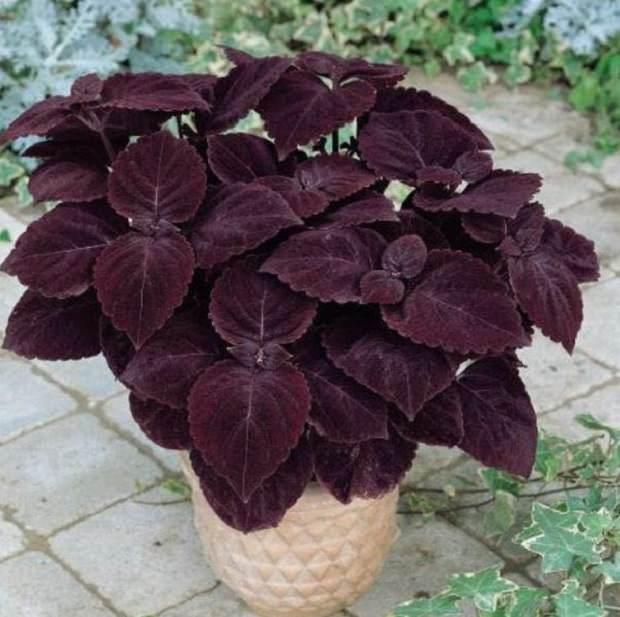
Coleus is a beautiful, showy plant that is available in various colors and styles. Mostly used as an annual for outdoor gardens, it is super easy to grow as an indoor plant as well. The vibrancy of its colors comes from receiving an adequate amount of sunlight. The more the light, the more vivid the colors. However, shade does allow the colors to form as well, though they will be a tad subdued. Coleus is remarkably easy to propagate. The eye-catchy, fancy leaves can liven up a dull drawing room, while the compact structure does justice to space-constrained corners well.
3. Prayer Plant
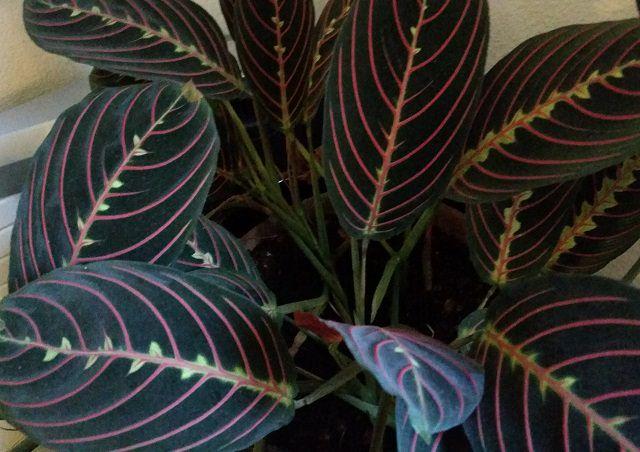
The prayer plant, with its unusual, purplish brown leaf markings is a fun little plant to have around the house. Also known as rabbit tracks, it has two different varieties, the green, and the red one. The latter has bold red leaf veins alongside the markings. Leaves close at night, thereby creating the appearance of praying hands. Prayer plant thrives well on moderately high humidity and uniformly watered soil. However, it appreciates remaining on a drier side in winter.
4. Sweet Caroline ‘Purple’ Potato Vine

We love this! One of the most gorgeous and versatile plants around for CONTAINER GARDENERS, sweet potato vine, performs well in both partial sun and shade and looks pretty in container gardens, borders, garden beds and landscapes. The plant is mainly loved for its brilliant foliage that is available in different colors of lime, purple, bronze, black or copper. And since its beauty comes from its leaf, the plant can be enjoyed all year long without having to wait for the blooms to show up. Sweet potato vine grows best in the moist and well-drained soil. It is remarkably flexible regarding light requirements.
5. Wandering Jew

A unique, easy to grow houseplant, the Wandering Jew is a popular houseplant that is both easy to grow and looks amazing in a hanging basket as well as in a topiary form. The most widely available variety of this vine has leaves marked with characteristic olive and silver markings on the top and a dark purplish maroon color on the undersides. Some varieties flaunt a purplish color on both surfaces of the leaves. Wandering Jew thrives well on medium to bright low light and uniformly-watered soil. You can grow this plant from stem cuttings stuck in water or a moist potting soil. It’s recommended to allow the soil to dry in between watering spells.
6. Ti Plant

Ti plant is an astonishing red-purple colored houseplant featuring flamboyantly colored foliage and an elegant appeal; the ti plant is a perfect choice for adding a pop of color, style, and drama to a well-lit corner of your room. Most varieties have strap-like leaves variegated with bright streaks of different colors of hot pink, white, cream, or deeper shades of purple. Ti plant is picky about sunlight and likes to be in a spot that receives a partial sun.
7. Rex Begonia
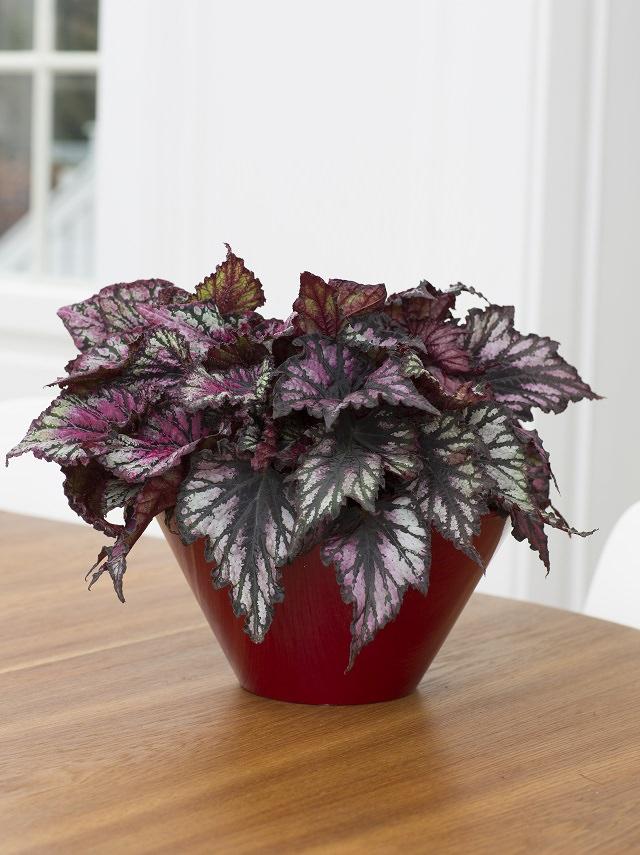
Rex begonia plants are cherished for their dramatically colored and textured foliage. The leaves come in a broad spectrum of colors, shapes, and stripes. While the flowers are insignificant, the unique leaf shapes and attractive color combinations of silver, red, purple, white and pink pretty much makes up for it. Rex begonia mostly enjoys shade gardens, which makes it apt for indoor gardening. Soggy soil and excessive use of fertilizers lead to instant rotting, while prolonged wet leaves make them susceptible to infection. If you keep these in mind, caring for your Rex begonia plant will be a breeze.
8. Purple Passion (Gynura Aurantiaca)
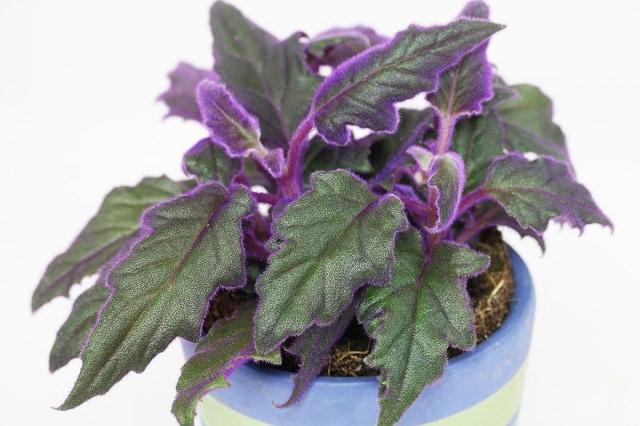
This lovely houseplant has fuzzy green foliage with a dab of purple hairs and edges. Grow it in any neutral colored houseplant, and you’ll see how it’ll stand out from the other houseplants. Its characteristic purple sheen comes when it is touched by a fleck of sunlight. Purple passion has an upright habit when young and becomes more vine-like and spreading as it matures. This makes it a perfect choice for adorning hanging baskets and small trellises alike. The plant enjoys the bright light and evenly moist soil.
9. Caladium

Caladiums are beautiful tropical plants with big, wafer-thin leaves having varying patterns in reds, pink, purple and cream. The brilliant foliage of this plant is its USP, as it is available in unusual shapes like hearts, lances or arrows, as well as eye-catchy color combinations of red, pink, rose and white. Being a shade plant, it doesn’t mind growing indoors, though it requires a minimum of 3-4 hours of filtered light each day.
10. Waffle Plant
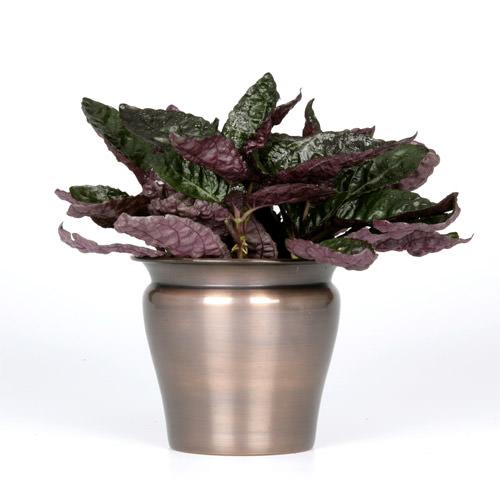
The waffle plant is a beautiful tiny houseplant with colorful foliage having a metallic tone in purple color, the striking appearance, which makes it an excellent addition to your home or office. Its small stature makes it ideal for decorating crammed-up desks or countertops, while its low growing nature makes it suitable for use as a groundcover underneath larger indoor plants like ficus trees. Waffle plant benefits from medium to bright light indoors. Remember, if it doesn’t get adequate sunlight, it may lose its vibrant purple coloring. However, direct light is a hazard as the leaves may bleach and undergo sunburn. Accent the waffle plant’s brilliant foliage with a terracotta container for a classic appeal.
11. Red Aglaonema
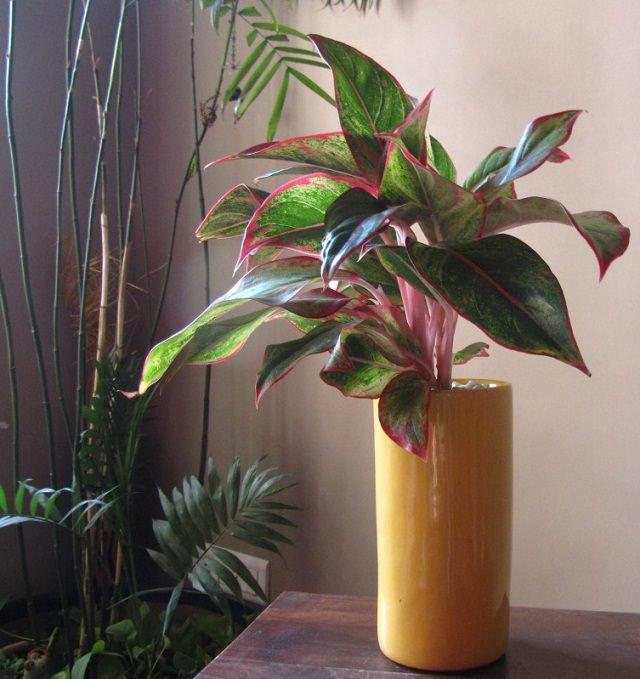
Red aglaonema is a spectacular Chinese evergreen plant with stunning, purple or red-tinted leaves. One of the easiest houseplants to grow, red aglaonema, is a new and stylish entree to the world of houseplants. This beauty flaunts dark green leaves marked elegantly with bright red, purple or pink stripes. Its colorful foliage makes it apt for decorating desks, tabletops, coffee tables as well as side tables in bedrooms. You can also consider using it as a substitute for poinsettia this season. The long-lived houseplant retains its color all through the year and demands little care in the process.
12. Calathea
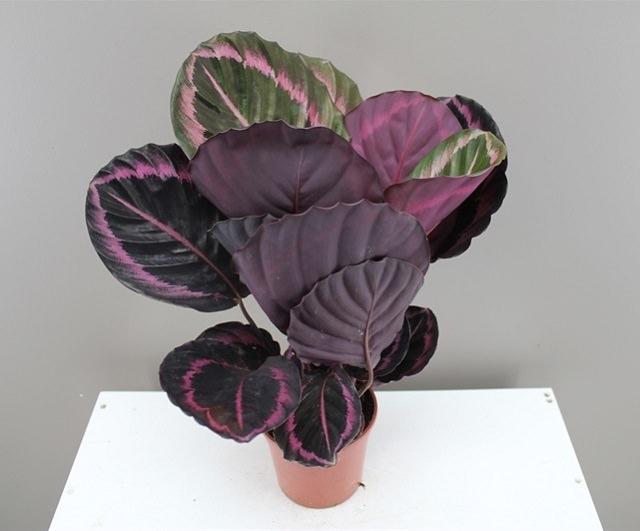
The calathea is one of the most beautiful houseplants that has the potential to light up any room with colorful accents. With a special marking of stark white veins against red, purple, green and cream leaves, the calathea lends an exciting and fashionable touch to your home. Most varieties have reddish purple color on the undersides of leaves, which makes them attractive when viewed from both above or below.
13. Iron-Cross Begonia
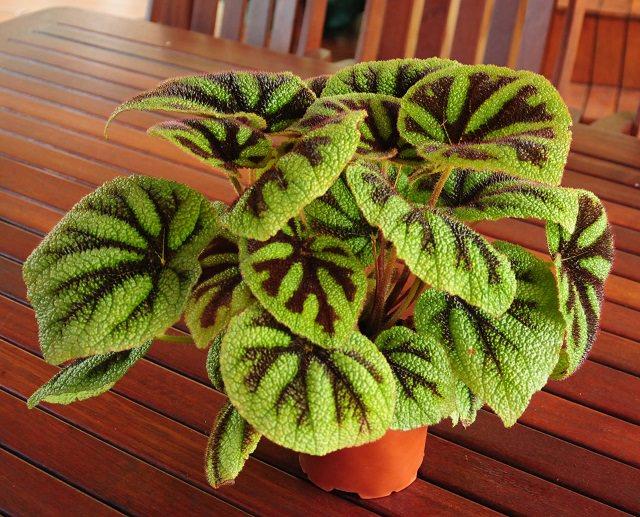
This beautiful New Guinea species is a must for you if you love growing unique indoor plants. Its leaves sport wide, chocolate-brown markings which stand out well against the dark green backdrop and radiate all the way to the leaf margins, thereby resembling the German iron cross. The beautiful coloration set against solid green with a coarse, pebbled texture makes for a very royal presence that is sure to liven up your home like none other. The plant prefers humid conditions, though you are best off cutting back on the water amount if you notice yellowing or browning of the leaves.
14. Rubber Tree (Ficus elastica)
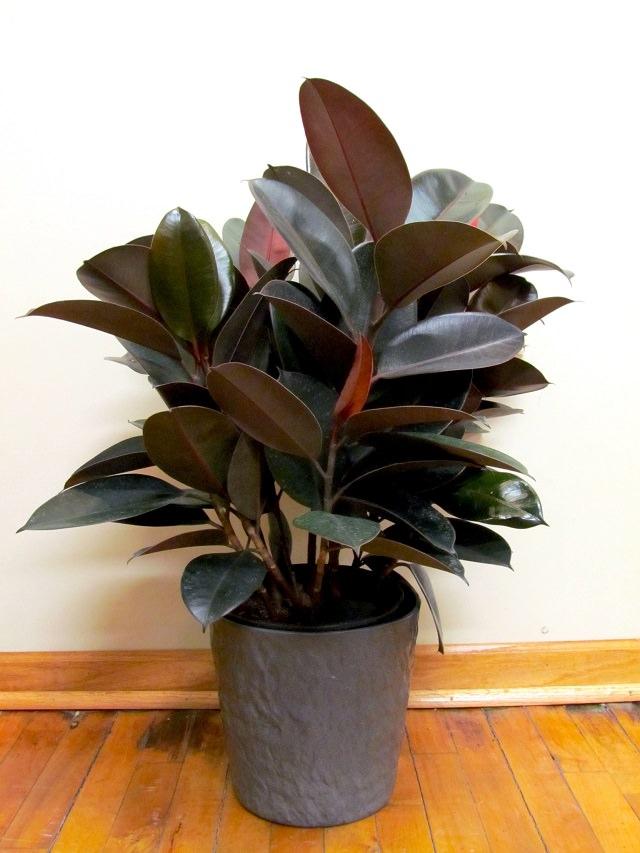
The mention of rubber tree immediately conjures up images of latex oozing out from barks. True that but it is one of the most popular houseplants today and why not it looks impressive indoors and cleanse the air too. Its leaves appear dark purple when mature, and bright red when young and opening. Learn how to grow a rubber tree houseplant here!
Also Read: Plants for Restful Sleep
15. Silver Squill

Contrary to its name, silver squill is a tough little plant. Hailing from the Cape Province of South Africa, it grows in dry habitats and stores moisture in its succulent, bulb-like stems as an adaptation tactic against the moisture-deprived soil. With its unique structure and colorful foliage, it becomes an unusual houseplant, which is sure to attract plenty of eyeballs. The plant derives its name from the lovely, silver-colored polka dots on leaves and the rich purple undersides of the stems. It’s easy to care as well, provided you grow them in the shade.

Native to Brazil, Oxalis plants display unique, pinwheel foliage and a wealth of starry blossoms. Some varieties produce purple leaves or foliage with deeper accent markings. Its delicate foliage and dainty flowers make it an ideal choice for containers and indoors alike. The tiny, triangular leaflets close at night, which make it a fun plant to have around the house.
2. Coleus

Coleus is a beautiful, showy plant that is available in various colors and styles. Mostly used as an annual for outdoor gardens, it is super easy to grow as an indoor plant as well. The vibrancy of its colors comes from receiving an adequate amount of sunlight. The more the light, the more vivid the colors. However, shade does allow the colors to form as well, though they will be a tad subdued. Coleus is remarkably easy to propagate. The eye-catchy, fancy leaves can liven up a dull drawing room, while the compact structure does justice to space-constrained corners well.
3. Prayer Plant

The prayer plant, with its unusual, purplish brown leaf markings is a fun little plant to have around the house. Also known as rabbit tracks, it has two different varieties, the green, and the red one. The latter has bold red leaf veins alongside the markings. Leaves close at night, thereby creating the appearance of praying hands. Prayer plant thrives well on moderately high humidity and uniformly watered soil. However, it appreciates remaining on a drier side in winter.
4. Sweet Caroline ‘Purple’ Potato Vine

We love this! One of the most gorgeous and versatile plants around for CONTAINER GARDENERS, sweet potato vine, performs well in both partial sun and shade and looks pretty in container gardens, borders, garden beds and landscapes. The plant is mainly loved for its brilliant foliage that is available in different colors of lime, purple, bronze, black or copper. And since its beauty comes from its leaf, the plant can be enjoyed all year long without having to wait for the blooms to show up. Sweet potato vine grows best in the moist and well-drained soil. It is remarkably flexible regarding light requirements.
5. Wandering Jew

A unique, easy to grow houseplant, the Wandering Jew is a popular houseplant that is both easy to grow and looks amazing in a hanging basket as well as in a topiary form. The most widely available variety of this vine has leaves marked with characteristic olive and silver markings on the top and a dark purplish maroon color on the undersides. Some varieties flaunt a purplish color on both surfaces of the leaves. Wandering Jew thrives well on medium to bright low light and uniformly-watered soil. You can grow this plant from stem cuttings stuck in water or a moist potting soil. It’s recommended to allow the soil to dry in between watering spells.
6. Ti Plant

Ti plant is an astonishing red-purple colored houseplant featuring flamboyantly colored foliage and an elegant appeal; the ti plant is a perfect choice for adding a pop of color, style, and drama to a well-lit corner of your room. Most varieties have strap-like leaves variegated with bright streaks of different colors of hot pink, white, cream, or deeper shades of purple. Ti plant is picky about sunlight and likes to be in a spot that receives a partial sun.
7. Rex Begonia

Rex begonia plants are cherished for their dramatically colored and textured foliage. The leaves come in a broad spectrum of colors, shapes, and stripes. While the flowers are insignificant, the unique leaf shapes and attractive color combinations of silver, red, purple, white and pink pretty much makes up for it. Rex begonia mostly enjoys shade gardens, which makes it apt for indoor gardening. Soggy soil and excessive use of fertilizers lead to instant rotting, while prolonged wet leaves make them susceptible to infection. If you keep these in mind, caring for your Rex begonia plant will be a breeze.
8. Purple Passion (Gynura Aurantiaca)

This lovely houseplant has fuzzy green foliage with a dab of purple hairs and edges. Grow it in any neutral colored houseplant, and you’ll see how it’ll stand out from the other houseplants. Its characteristic purple sheen comes when it is touched by a fleck of sunlight. Purple passion has an upright habit when young and becomes more vine-like and spreading as it matures. This makes it a perfect choice for adorning hanging baskets and small trellises alike. The plant enjoys the bright light and evenly moist soil.
9. Caladium

Caladiums are beautiful tropical plants with big, wafer-thin leaves having varying patterns in reds, pink, purple and cream. The brilliant foliage of this plant is its USP, as it is available in unusual shapes like hearts, lances or arrows, as well as eye-catchy color combinations of red, pink, rose and white. Being a shade plant, it doesn’t mind growing indoors, though it requires a minimum of 3-4 hours of filtered light each day.
10. Waffle Plant

The waffle plant is a beautiful tiny houseplant with colorful foliage having a metallic tone in purple color, the striking appearance, which makes it an excellent addition to your home or office. Its small stature makes it ideal for decorating crammed-up desks or countertops, while its low growing nature makes it suitable for use as a groundcover underneath larger indoor plants like ficus trees. Waffle plant benefits from medium to bright light indoors. Remember, if it doesn’t get adequate sunlight, it may lose its vibrant purple coloring. However, direct light is a hazard as the leaves may bleach and undergo sunburn. Accent the waffle plant’s brilliant foliage with a terracotta container for a classic appeal.
11. Red Aglaonema

Red aglaonema is a spectacular Chinese evergreen plant with stunning, purple or red-tinted leaves. One of the easiest houseplants to grow, red aglaonema, is a new and stylish entree to the world of houseplants. This beauty flaunts dark green leaves marked elegantly with bright red, purple or pink stripes. Its colorful foliage makes it apt for decorating desks, tabletops, coffee tables as well as side tables in bedrooms. You can also consider using it as a substitute for poinsettia this season. The long-lived houseplant retains its color all through the year and demands little care in the process.
12. Calathea

The calathea is one of the most beautiful houseplants that has the potential to light up any room with colorful accents. With a special marking of stark white veins against red, purple, green and cream leaves, the calathea lends an exciting and fashionable touch to your home. Most varieties have reddish purple color on the undersides of leaves, which makes them attractive when viewed from both above or below.
13. Iron-Cross Begonia

This beautiful New Guinea species is a must for you if you love growing unique indoor plants. Its leaves sport wide, chocolate-brown markings which stand out well against the dark green backdrop and radiate all the way to the leaf margins, thereby resembling the German iron cross. The beautiful coloration set against solid green with a coarse, pebbled texture makes for a very royal presence that is sure to liven up your home like none other. The plant prefers humid conditions, though you are best off cutting back on the water amount if you notice yellowing or browning of the leaves.
14. Rubber Tree (Ficus elastica)

The mention of rubber tree immediately conjures up images of latex oozing out from barks. True that but it is one of the most popular houseplants today and why not it looks impressive indoors and cleanse the air too. Its leaves appear dark purple when mature, and bright red when young and opening. Learn how to grow a rubber tree houseplant here!
Also Read: Plants for Restful Sleep
15. Silver Squill

Contrary to its name, silver squill is a tough little plant. Hailing from the Cape Province of South Africa, it grows in dry habitats and stores moisture in its succulent, bulb-like stems as an adaptation tactic against the moisture-deprived soil. With its unique structure and colorful foliage, it becomes an unusual houseplant, which is sure to attract plenty of eyeballs. The plant derives its name from the lovely, silver-colored polka dots on leaves and the rich purple undersides of the stems. It’s easy to care as well, provided you grow them in the shade.
2
1
文章
扭扭
2017年05月23日

Growing strawberries in gutters is the best way to use up your vertical space smartly. Strawberries are super easy fruits to grow in gutters, it also saves them from diseases like crown rot and fruit rot.
You can try to grow strawberries upside down too, learn here.
Things You’ll Need for Growing Strawberries in Gutters
A simple PVC pipe with a diameter of 10 cm., hole saw to make holes. You will also need something to clog pipe from both sides.
1. Step One

Image Credit: ogrodwcentrum
Divide PVC pipes into equal sizes as many you want and make holes according to the size of pipe (approx. 5 cm). Use hole saw to make holes. You’ll also need to make a few hole for drainage on the bottom. Then clog pipe from both sides.
2. Step Two

Image Credit: ogrodwcentrum
Now fill up the soil in the holes you made and plant strawberry plants carefully in each hole. Take care that the crown of strawberry plants should not be covered in soil.
3. Step Three

You can try to grow strawberries upside down too, learn here.
Things You’ll Need for Growing Strawberries in Gutters
A simple PVC pipe with a diameter of 10 cm., hole saw to make holes. You will also need something to clog pipe from both sides.
1. Step One

Image Credit: ogrodwcentrum
Divide PVC pipes into equal sizes as many you want and make holes according to the size of pipe (approx. 5 cm). Use hole saw to make holes. You’ll also need to make a few hole for drainage on the bottom. Then clog pipe from both sides.
2. Step Two

Image Credit: ogrodwcentrum
Now fill up the soil in the holes you made and plant strawberry plants carefully in each hole. Take care that the crown of strawberry plants should not be covered in soil.
3. Step Three

1
0
文章
Colorful
2017年05月23日

There are herbs and vegetables that regrow in water INDOORS , you can grow them from scraps and use in salads and toppings. Take a look!
In this article, you’ll learn about the herbs and vegetables that can re-grow (for a while) without soil, using just water and water, good for those who have no space to grow their own food, growing plants in water also help if you want to grow the roots of these scrap food plants for propagation.
Growing your own fruits, vegetables and herbs is one of the trendiest thing in the gardening. Growing food generates anticipation, curiosity, and interest, as well as it is fundamentally healthy- organic and free from harmful chemicals that are often used in producing large crops.
In addition, it’s much more rewarding! There is nothing better than a meal made with organic fruits of your own.1. Carrot Greens
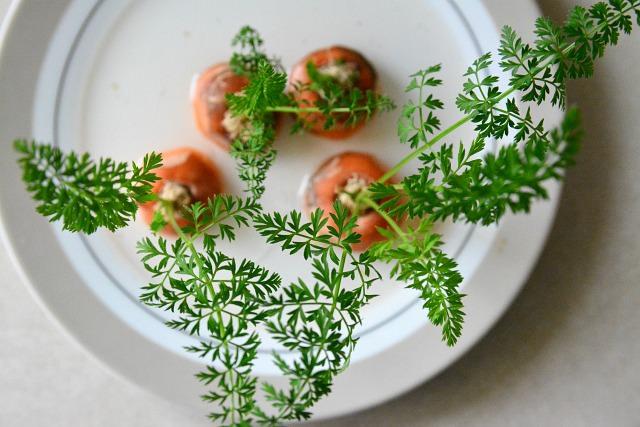
Although you can not bring back and GROW carrots in water but instead of throwing away the green ends from the top, put them in a shallow container of water in a bright spot to regrow the carrot greens. Keep changing the water every other day and in a few days, you’ll be able to see tiny green leaves, a wonderful addition to a salad, pesto or chutney.
2. Green Onion
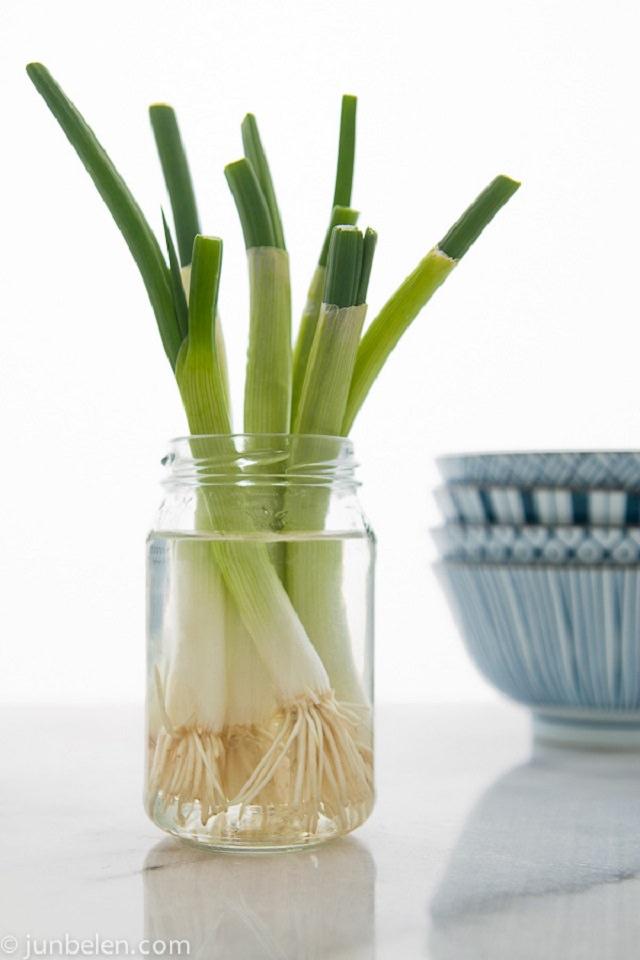
Noodles, Salads, and Pasta or even much more, there’re so many recipes in which you can try green onions. Isn’t it better to grow them fresh in your home?
Growing green onions in water is super easy, too. You don’t need a garden for this; all you need is a sunny windowsill, transparent jar or glass, and green onion bulbs. Read more about this here!
3. Bok Choi
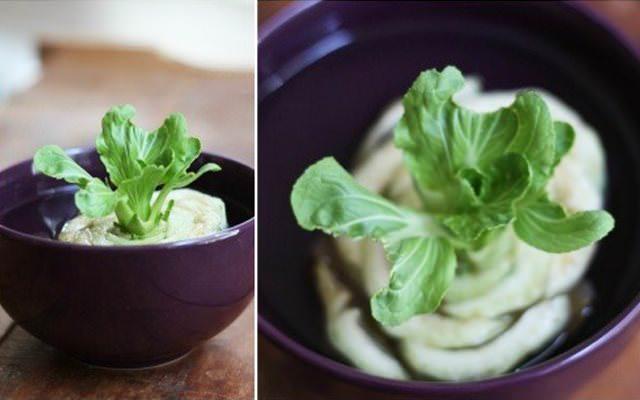
Bok choy, Bok Choi or Chinese cabbage is a green vegetable widely consumed in many Asian countries. Can be eaten raw, in salad and cooked. It contains lots of vitamins and minerals. To regrow again, cut the base of the stem and place this in a small bowl of water. It’s that simple! You will see how the new growth begins in only 2 days. See the tutorial! Either use the young leaves or transplant the regrowing Bok Choi in a container.
4. Celery

Celery is a herb that has been used since ancient times for its natural medicinal qualities. It is characterized by having a diuretic, digestive, purifying and anti-inflammatory action. To grow again, use the base! Place that in a small bowl of water. You will see how it grows back in 3 or 4 days. Young leaves can be used again or plant it if you have a small pot.
Also Read: Cool DIY Planter Ideas from Household Items
5. Fennel
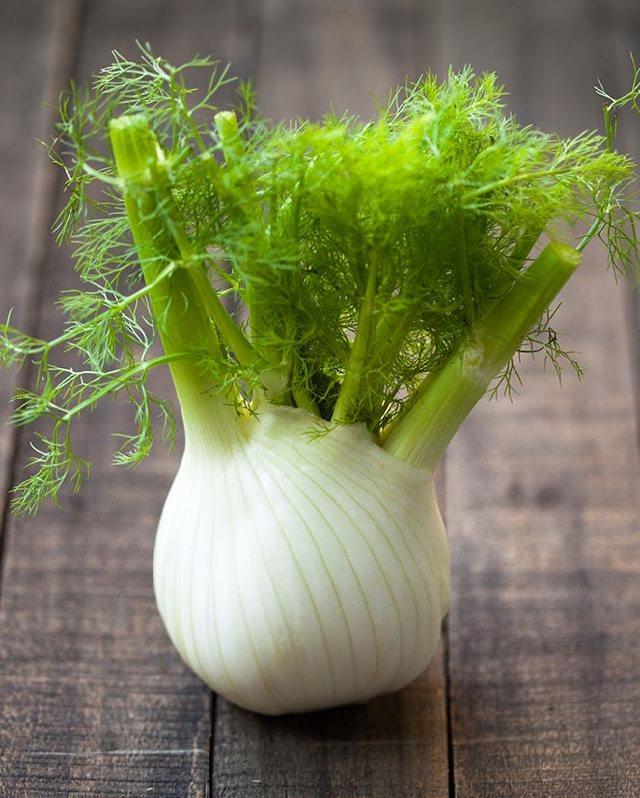
Fennel looks similar to dill, it can be a great addition to your cuisines. You can regrow it as easily as celery. Take a fennel bulb and set it in a cup or small bowl of clear water, a level of water should be at the level of the bulb. Keep the bowl in a spot that receives some sun and change the water in every couple of days.
6. Lettuce
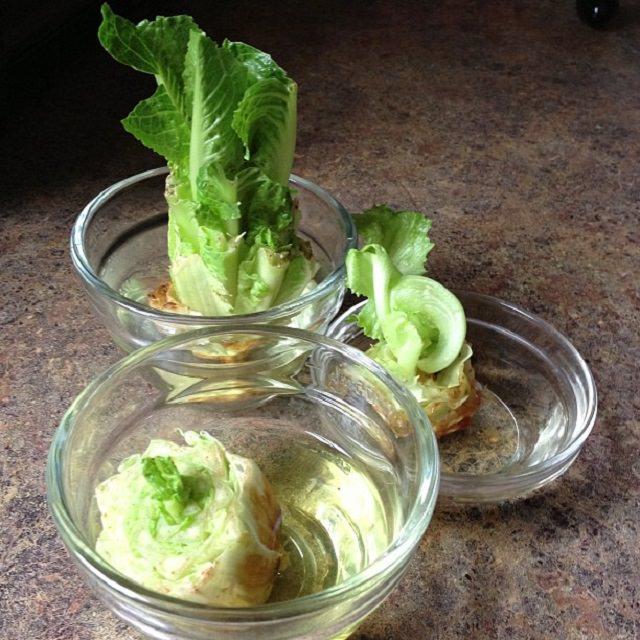
Lettuce taste best when fresh! However, growing lettuce in water won’t satiate your lettuce needs but you’ll love growing it that way. You can use this tiny supply in your salads or top the sandwiches with it. To regrow, eat your purchased lettuce, cutting the leaves at about 1 inch from the bottom. Place remaining stem in a shallow dish of water (about 1/2 inch). Now place that on a windowsill or under grow lights. Change water in a bowl every 1 to 2 days. Read more on Getty Stewart’s site!
7. Lemongrass
Get the lemongrass stalks and keep them in water in a bright spot that receives some sun, change the water every day, and watch as new leaves begin growing almost immediately. The roots start emerging after a week, and the stalk eventually divides itself (via offshoot stalks) after a few weeks. You can either use it or transplant that in pot.
8. Garlic Sprout

To make it grow, find a garlic clove with green sprout and keep it in a glass. Fill the water up to the level of clove. In 2-3 days the sprout will start to grow and the clove will produce roots. When the sprouts are 3 inches in height, you can cut it for use leaving 1/3 of the shoot. It can be used in salads baked potatoes, or to spice up any preparation, because it has an aroma and garlic-like flavor.
9. Beet Greens

Beetroot is a highly nutritious vegetable, but its green part is also very healthy. It contains more iron than spinach, also the vitamin A that helps strengthen the immune system and stimulates the production of antibodies and white blood cells. To regrow, slice off the top portion of a beet with a knife. Take no more than one-third of the beet. Fill a glass, mug or bowl with water. Place the beet top into the water, with the cut side facing downward. Set the glass on a windowsill, counter or table that is close to the window, so the beet top will receive adequate sunlight. Read more of it here.
In this article, you’ll learn about the herbs and vegetables that can re-grow (for a while) without soil, using just water and water, good for those who have no space to grow their own food, growing plants in water also help if you want to grow the roots of these scrap food plants for propagation.
Growing your own fruits, vegetables and herbs is one of the trendiest thing in the gardening. Growing food generates anticipation, curiosity, and interest, as well as it is fundamentally healthy- organic and free from harmful chemicals that are often used in producing large crops.
In addition, it’s much more rewarding! There is nothing better than a meal made with organic fruits of your own.1. Carrot Greens

Although you can not bring back and GROW carrots in water but instead of throwing away the green ends from the top, put them in a shallow container of water in a bright spot to regrow the carrot greens. Keep changing the water every other day and in a few days, you’ll be able to see tiny green leaves, a wonderful addition to a salad, pesto or chutney.
2. Green Onion

Noodles, Salads, and Pasta or even much more, there’re so many recipes in which you can try green onions. Isn’t it better to grow them fresh in your home?
Growing green onions in water is super easy, too. You don’t need a garden for this; all you need is a sunny windowsill, transparent jar or glass, and green onion bulbs. Read more about this here!
3. Bok Choi

Bok choy, Bok Choi or Chinese cabbage is a green vegetable widely consumed in many Asian countries. Can be eaten raw, in salad and cooked. It contains lots of vitamins and minerals. To regrow again, cut the base of the stem and place this in a small bowl of water. It’s that simple! You will see how the new growth begins in only 2 days. See the tutorial! Either use the young leaves or transplant the regrowing Bok Choi in a container.
4. Celery

Celery is a herb that has been used since ancient times for its natural medicinal qualities. It is characterized by having a diuretic, digestive, purifying and anti-inflammatory action. To grow again, use the base! Place that in a small bowl of water. You will see how it grows back in 3 or 4 days. Young leaves can be used again or plant it if you have a small pot.
Also Read: Cool DIY Planter Ideas from Household Items
5. Fennel

Fennel looks similar to dill, it can be a great addition to your cuisines. You can regrow it as easily as celery. Take a fennel bulb and set it in a cup or small bowl of clear water, a level of water should be at the level of the bulb. Keep the bowl in a spot that receives some sun and change the water in every couple of days.
6. Lettuce

Lettuce taste best when fresh! However, growing lettuce in water won’t satiate your lettuce needs but you’ll love growing it that way. You can use this tiny supply in your salads or top the sandwiches with it. To regrow, eat your purchased lettuce, cutting the leaves at about 1 inch from the bottom. Place remaining stem in a shallow dish of water (about 1/2 inch). Now place that on a windowsill or under grow lights. Change water in a bowl every 1 to 2 days. Read more on Getty Stewart’s site!
7. Lemongrass
Get the lemongrass stalks and keep them in water in a bright spot that receives some sun, change the water every day, and watch as new leaves begin growing almost immediately. The roots start emerging after a week, and the stalk eventually divides itself (via offshoot stalks) after a few weeks. You can either use it or transplant that in pot.
8. Garlic Sprout

To make it grow, find a garlic clove with green sprout and keep it in a glass. Fill the water up to the level of clove. In 2-3 days the sprout will start to grow and the clove will produce roots. When the sprouts are 3 inches in height, you can cut it for use leaving 1/3 of the shoot. It can be used in salads baked potatoes, or to spice up any preparation, because it has an aroma and garlic-like flavor.
9. Beet Greens

Beetroot is a highly nutritious vegetable, but its green part is also very healthy. It contains more iron than spinach, also the vitamin A that helps strengthen the immune system and stimulates the production of antibodies and white blood cells. To regrow, slice off the top portion of a beet with a knife. Take no more than one-third of the beet. Fill a glass, mug or bowl with water. Place the beet top into the water, with the cut side facing downward. Set the glass on a windowsill, counter or table that is close to the window, so the beet top will receive adequate sunlight. Read more of it here.
3
0
文章
lenny
2017年05月23日

Growing lettuce in containers is fun and easy and you can harvest fresh, crispy, and organic lettuce leaves for your salads in no time.

Lettuce is one of the vegetables that is very easy to grow in pots and you can even grow it in a small container. Healthy and continuously productive, this crispy salad green has many qualities that make it a blessing for health. Rich in water, fiber, vitamins and minerals such as calcium, magnesium, potassium and sodium, the lettuce is perfect for those who have intestinal transit problems, and also contributes to the smooth functioning of the nervous system.
You can start to harvest lettuce in no time– about 8 weeks for most of the varieties, it is super easy to grow and productive; similar to spinach. And the best part is you don’t need a lot of space to grow lettuce.
Also Read: How to Grow Spinach
Choosing a Pot
Almost all the lettuce varieties grow well in pots. As their shallow roots don’t need deep soil, they do best in wide and shallow containers. The pot must have adequate drainage holes in the bottom and should be at least 6 inches deep. You can use any material for pots such as plastic, clay or terracotta pots.
*However, if you’re growing lettuce in a container in a warm climate, do that in clay pots and plant heat resistant varieties.Planting Lettuce in Pots

Lettuce is a cool season crop and growing lettuce in pots is possible from spring to fall in most of the regions. Although, if you live in USDA Zones 10-11 or in any other subtropical or tropical part of the world, you should try to grow lettuce in winter.
You can easily cultivate the lettuce from seeds or from seedlings. If you want to grow it from seeds, read this post. Alternatively, you can directly buy the seedlings from a nearby nursery.
For continuous harvest do successive planting, sow seeds in every two weeks throughout the growing season.
In summer, when the weather starts to heat up the lettuce tends to bolt, to reduce this tendency keep your potted lettuce plant in a cool spot and provide proper shade.
Requirements for Growing Lettuce in ContainersSpacing
Considering you’re growing lettuce in a small space in your container garden, we assume you’ll harvest your lettuce plants regularly; trying “Cut And Come Again” method. This way you don’t need to care much about spacing.
Sow seeds densely and thin out the seedlings as they grow picking young, tender leaves regularly. Keep the plants 4-6 inches apart (depending on the size of the leaves you want and cultivar). However, head lettuces require more spacing than leaf lettuces and planting depth (8 inches) must be increased too.
Position
The lettuce loves the sunlight (*more in cooler zones) though it can be grown easily in a partially shaded area but if you’re growing lettuce in a warm climate where the sun is intense try to place the pot in a spot that receives only a few hours of morning sun.
During the hottest hours of the day (in the afternoon) it is recommended to create a shade for the plant to prevent the drying of the soil as lettuce prefers slightly moist soil constantly. Also, move the container in a cool spot when the temperature rises as this favorite green is heat sensitive.
Soil
For growing healthy lettuce, use a good quality soil mix which has plenty of organic matter, such as compost and peat. You can also add well-rotted manure or compost additionally. The soil you use must be loamy and well-drained and doesn’t hold water too much.
Watering
In shallow pots, you may need to water frequently so that the plant will not dry out completely. Make sure that you not only keep the soil slightly moist but also avoid to overwater your container grown lettuces as overwatering can kill the plants due to root rot.
Fertilizer
Because lettuce plants mature quickly, a single or double application of fertilizer is usually all that is needed to boost the production. Before you fertilize, wait for a few weeks to allow the seedlings to establish. To fertilize lettuce you can use a granular balanced fertilizer such as 10-10-10. You can also use liquid fertilizer for a quick boost. When fertilizing, be sure to follow manufacturer’s instructions as both over and under fertilization can be harmful.
Pests and Diseases
Growing lettuces in containers require care from leaf eating insects. However, if the plants are healthy there are fewer chances of infestation of pests or diseases. Mildew, leaf spot, rot and a variety of bacterial infections are common diseases that can attack lettuce. In pests and insects– caterpillars, cutworms, aphids, maggots and beetles can cause damage to the plant.
Harvesting
Once the lettuce leaves have reached the height of 4-6″ (the baby green size perfect for cut and come again method) or according to your desired size, either pick the outer leaves individually or harvest them by cutting the leaves off 1″ (2-3 cm) from above the base or crown (Must remember, don’t cut into or below the crown or else your plant will die). This way the plant will grow back and you’ll be able to harvest it again.
You can also pick the leaf lettuce before maturity, it’s simple, just remove the outer leaves when you need them in salads and keep the center leaves growing.

Lettuce is one of the vegetables that is very easy to grow in pots and you can even grow it in a small container. Healthy and continuously productive, this crispy salad green has many qualities that make it a blessing for health. Rich in water, fiber, vitamins and minerals such as calcium, magnesium, potassium and sodium, the lettuce is perfect for those who have intestinal transit problems, and also contributes to the smooth functioning of the nervous system.
You can start to harvest lettuce in no time– about 8 weeks for most of the varieties, it is super easy to grow and productive; similar to spinach. And the best part is you don’t need a lot of space to grow lettuce.
Also Read: How to Grow Spinach
Choosing a Pot
Almost all the lettuce varieties grow well in pots. As their shallow roots don’t need deep soil, they do best in wide and shallow containers. The pot must have adequate drainage holes in the bottom and should be at least 6 inches deep. You can use any material for pots such as plastic, clay or terracotta pots.
*However, if you’re growing lettuce in a container in a warm climate, do that in clay pots and plant heat resistant varieties.Planting Lettuce in Pots

Lettuce is a cool season crop and growing lettuce in pots is possible from spring to fall in most of the regions. Although, if you live in USDA Zones 10-11 or in any other subtropical or tropical part of the world, you should try to grow lettuce in winter.
You can easily cultivate the lettuce from seeds or from seedlings. If you want to grow it from seeds, read this post. Alternatively, you can directly buy the seedlings from a nearby nursery.
For continuous harvest do successive planting, sow seeds in every two weeks throughout the growing season.
In summer, when the weather starts to heat up the lettuce tends to bolt, to reduce this tendency keep your potted lettuce plant in a cool spot and provide proper shade.
Requirements for Growing Lettuce in ContainersSpacing
Considering you’re growing lettuce in a small space in your container garden, we assume you’ll harvest your lettuce plants regularly; trying “Cut And Come Again” method. This way you don’t need to care much about spacing.
Sow seeds densely and thin out the seedlings as they grow picking young, tender leaves regularly. Keep the plants 4-6 inches apart (depending on the size of the leaves you want and cultivar). However, head lettuces require more spacing than leaf lettuces and planting depth (8 inches) must be increased too.
Position
The lettuce loves the sunlight (*more in cooler zones) though it can be grown easily in a partially shaded area but if you’re growing lettuce in a warm climate where the sun is intense try to place the pot in a spot that receives only a few hours of morning sun.
During the hottest hours of the day (in the afternoon) it is recommended to create a shade for the plant to prevent the drying of the soil as lettuce prefers slightly moist soil constantly. Also, move the container in a cool spot when the temperature rises as this favorite green is heat sensitive.
Soil
For growing healthy lettuce, use a good quality soil mix which has plenty of organic matter, such as compost and peat. You can also add well-rotted manure or compost additionally. The soil you use must be loamy and well-drained and doesn’t hold water too much.
Watering
In shallow pots, you may need to water frequently so that the plant will not dry out completely. Make sure that you not only keep the soil slightly moist but also avoid to overwater your container grown lettuces as overwatering can kill the plants due to root rot.
Fertilizer

Because lettuce plants mature quickly, a single or double application of fertilizer is usually all that is needed to boost the production. Before you fertilize, wait for a few weeks to allow the seedlings to establish. To fertilize lettuce you can use a granular balanced fertilizer such as 10-10-10. You can also use liquid fertilizer for a quick boost. When fertilizing, be sure to follow manufacturer’s instructions as both over and under fertilization can be harmful.
Pests and Diseases
Growing lettuces in containers require care from leaf eating insects. However, if the plants are healthy there are fewer chances of infestation of pests or diseases. Mildew, leaf spot, rot and a variety of bacterial infections are common diseases that can attack lettuce. In pests and insects– caterpillars, cutworms, aphids, maggots and beetles can cause damage to the plant.
Harvesting
Once the lettuce leaves have reached the height of 4-6″ (the baby green size perfect for cut and come again method) or according to your desired size, either pick the outer leaves individually or harvest them by cutting the leaves off 1″ (2-3 cm) from above the base or crown (Must remember, don’t cut into or below the crown or else your plant will die). This way the plant will grow back and you’ll be able to harvest it again.
You can also pick the leaf lettuce before maturity, it’s simple, just remove the outer leaves when you need them in salads and keep the center leaves growing.
0
0
文章
Colorful
2017年05月23日

Love growing plants indoors? Some of the best indoor vines and climbers that are easy to grow are listed here. Must check out!A house with indoor plants looks more lavish and expensive. That’s a fact!1. Heartleaf Philodendron
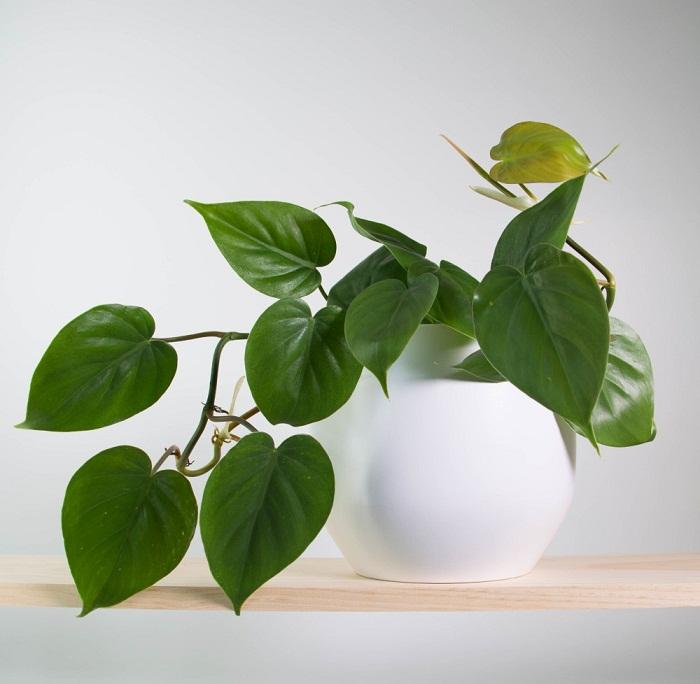
Heartleaf Philodendron is extremely easy to grow and great for beginners. It needs a moderate amount of light and prefers the soil to dry out between watering spells.
Also Read: Easiest Indoor Plants
2. Ivy
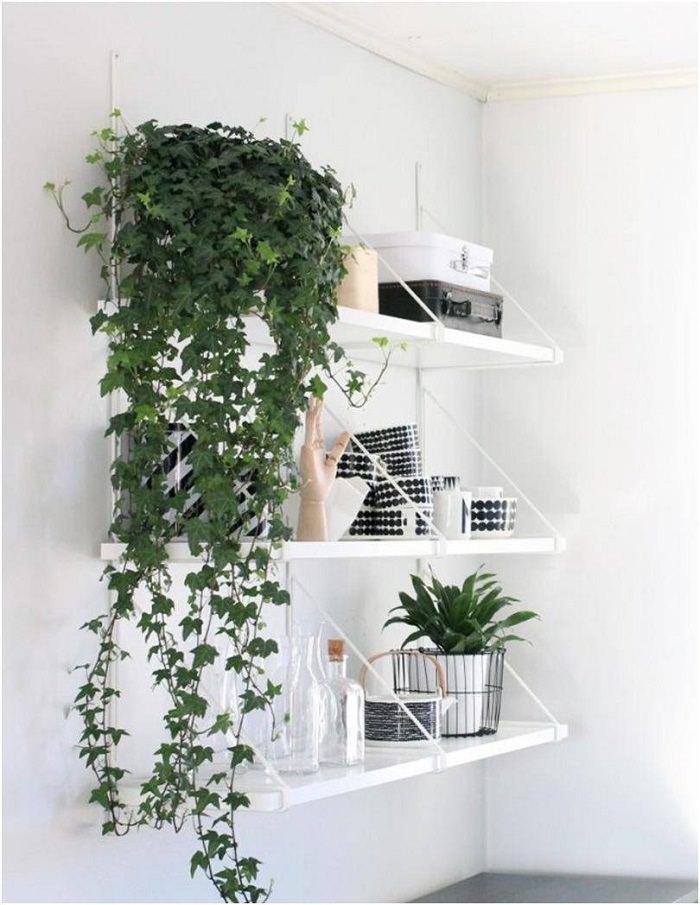
Ivy is one of the best indoor vines. It can easily adapt to many light conditions. This fast-growing vine has evergreen foliage that remains green even in winters. Plant it in a container that is wide and shallow rather than narrow and deep. Keep the pot in a spot that receives bright indirect sun.
Also Read: Best Indoor Plants According to Different Light Conditions
3. Pothos
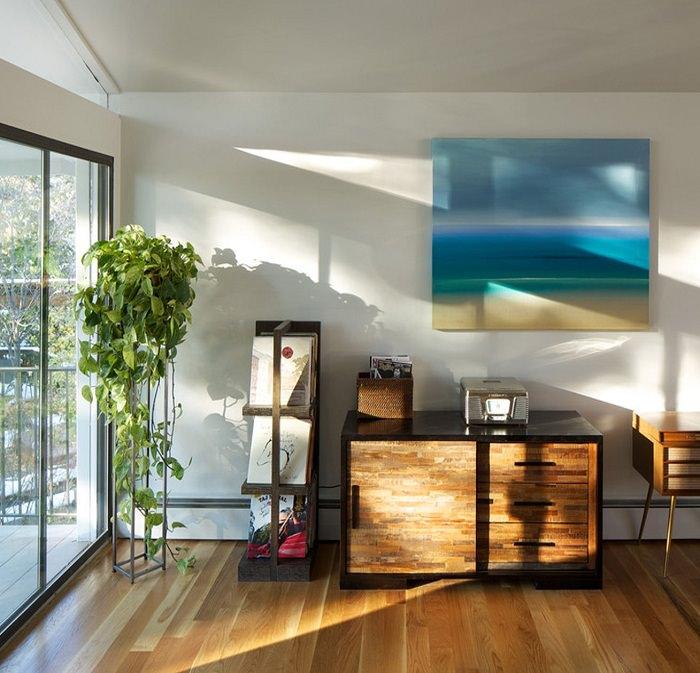
Plants of the pothos family are easiest to grow and most of them can even grow without direct sunlight. They become great houseplants for beginners. Attractive and hardy vine prefers bright indirect light and a draft free place. It can grow in low light and needs moist soil.
Also Read: Plants You can Grow Without Sunlight
4. Betel Leaf Plant
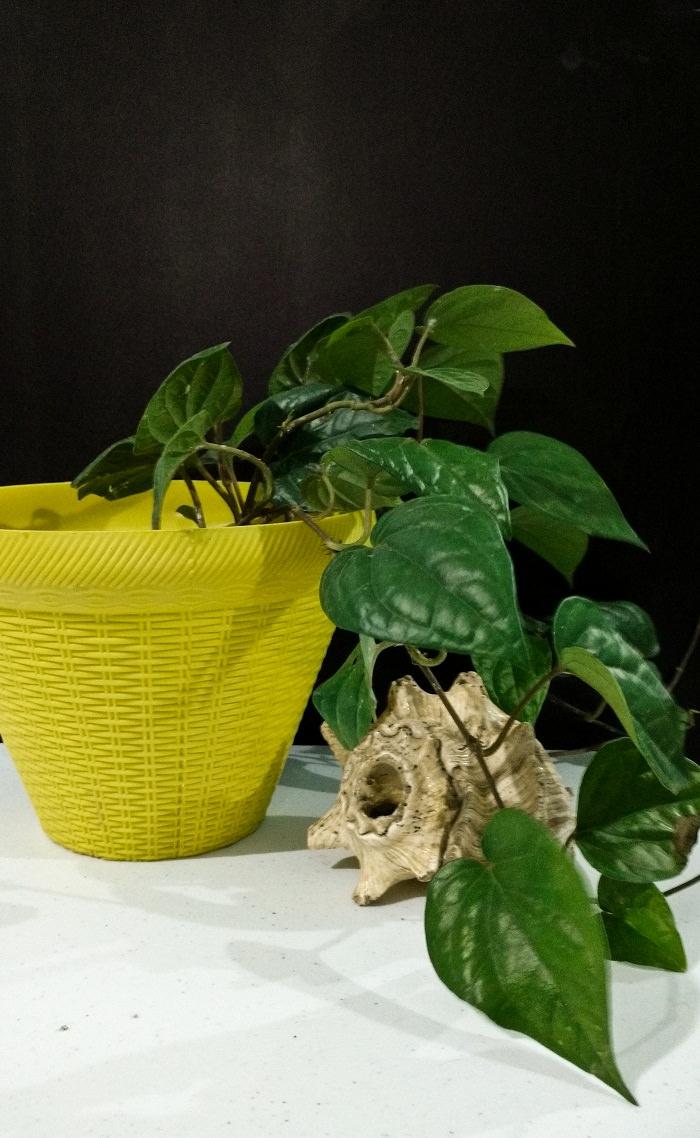
Betel leaf plant is very popular in South and East Asia, especially in the Indian subcontinent, Indonesia, Vietnam, and Thailand. This vine from pepper family has many culinary and medicinal uses. It can be tried indoors if space where you want to keep it receives part sun and remains slightly humid. All the other information is available here.
5. Jasmine

Many jasmine varieties can be grown indoors. If you keep this most fragrant vine in a bright spot where it receives some hours of direct sunlight daily, it’ll grow. The selection of jasmine varieties you want to plant indoors depends on the climate you live in. For colder regions, Jasminum polyanthum is the one you can try, whereas in tropics most of the plants from this species will grow.
6. Creeping Fig

It’s a slow growing creeper with small, leathery dark green foliage. Vigorous-growing, clinging, dense branches adhere to any surface and look enchanting. Be careful not to overwater creeping fig. Let the soil dry out before watering.
7. Arrowhead Plant

This elegant vine like houseplant prefers to be in a spot that is bright, needs moderate watering. Allow the soil to dry out between watering spells and make sure not to overwater it, as it may lead to root rot.
Also Read: Houseplants that are Harmful to Dogs
8. Hoya (Hoya spp.)

Beautiful waxy foliage and fragrant flowers, hoya looks stunning when grown indoors. The plant has low watering needs and doesn’t mind if you forget to water it occasionally. The trailing stems of this plant is approximately a foot in length along with clusters of aromatic waxy flowers.
Also Read: 99 Great Ideas to Display Houseplants
9. String Of Pearls
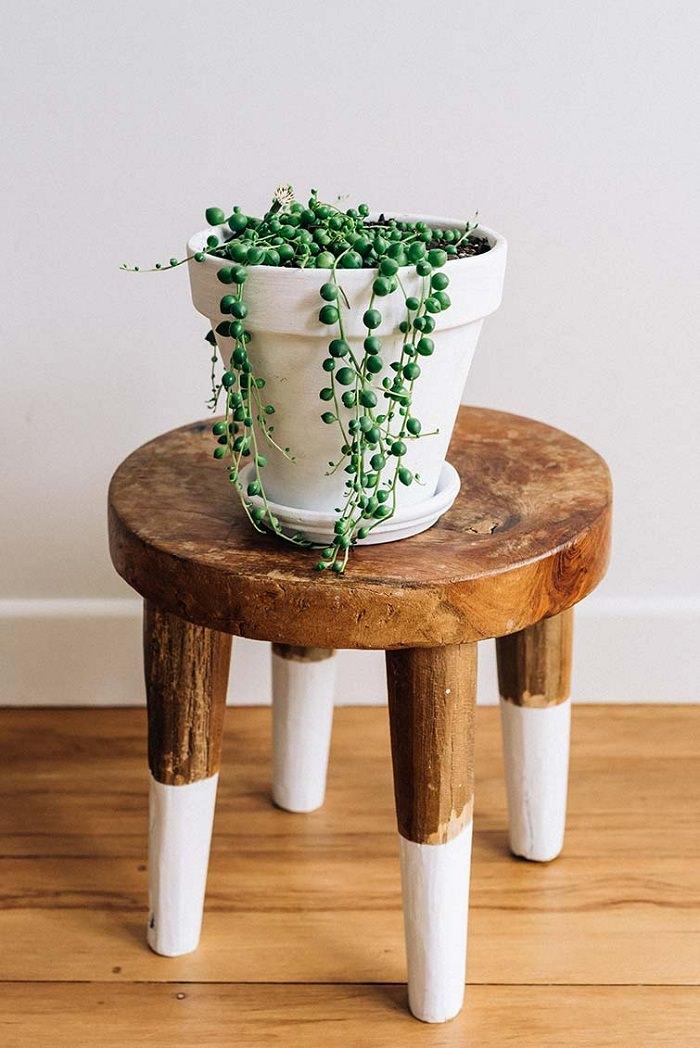
Growing string of pearls is easy, it is a low-maintenance creeper. This succulent tolerates prolonged drought and does well in a bright light position. You can also combine it with other houseplants to create a great appearance or it can be grown in a hanging basket.
10. Black Eyed Susan Vine

Black-eyed Susan vine can be grown indoors. Depending on your climate, this annual or perennial flowering plant can add a dramatic appeal to your rooms. Keep it near a window, where it receives a lot of sun.
11. Inch Plant
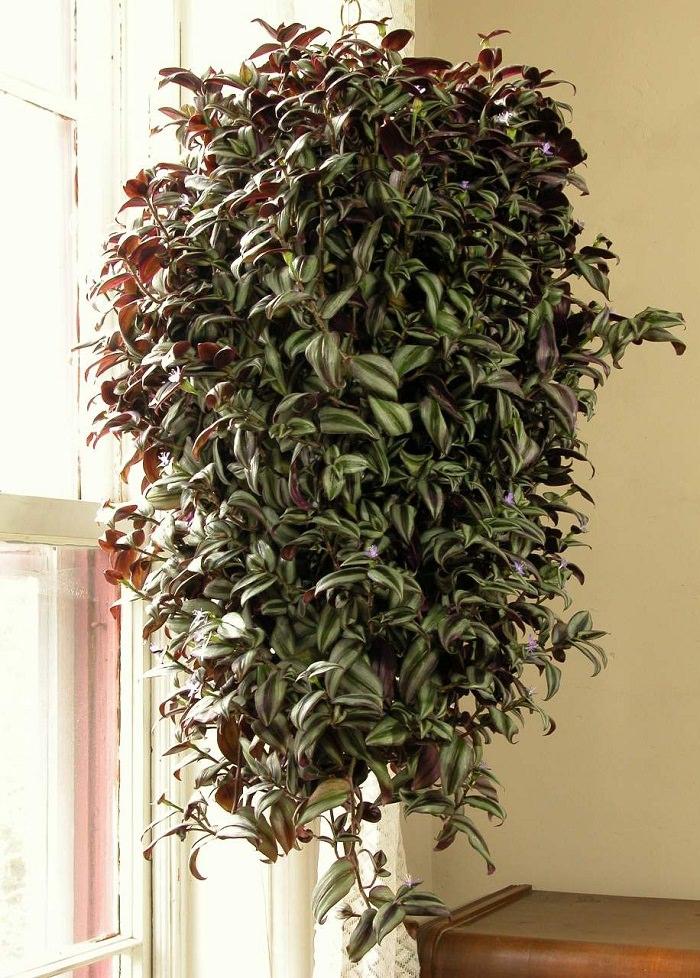
Also called “Wandering Jew” or “Purple heart”, this wonderful houseplant has beautiful trailing stems with attractive zebra patterned foliage that look stunning. Grow it in a pot or hanging basket, it’ll thrive. You can also keep this plant in dim light, but the markings on the foliage will fade.

Heartleaf Philodendron is extremely easy to grow and great for beginners. It needs a moderate amount of light and prefers the soil to dry out between watering spells.
Also Read: Easiest Indoor Plants
2. Ivy

Ivy is one of the best indoor vines. It can easily adapt to many light conditions. This fast-growing vine has evergreen foliage that remains green even in winters. Plant it in a container that is wide and shallow rather than narrow and deep. Keep the pot in a spot that receives bright indirect sun.
Also Read: Best Indoor Plants According to Different Light Conditions
3. Pothos

Plants of the pothos family are easiest to grow and most of them can even grow without direct sunlight. They become great houseplants for beginners. Attractive and hardy vine prefers bright indirect light and a draft free place. It can grow in low light and needs moist soil.
Also Read: Plants You can Grow Without Sunlight
4. Betel Leaf Plant

Betel leaf plant is very popular in South and East Asia, especially in the Indian subcontinent, Indonesia, Vietnam, and Thailand. This vine from pepper family has many culinary and medicinal uses. It can be tried indoors if space where you want to keep it receives part sun and remains slightly humid. All the other information is available here.
5. Jasmine

Many jasmine varieties can be grown indoors. If you keep this most fragrant vine in a bright spot where it receives some hours of direct sunlight daily, it’ll grow. The selection of jasmine varieties you want to plant indoors depends on the climate you live in. For colder regions, Jasminum polyanthum is the one you can try, whereas in tropics most of the plants from this species will grow.
6. Creeping Fig

It’s a slow growing creeper with small, leathery dark green foliage. Vigorous-growing, clinging, dense branches adhere to any surface and look enchanting. Be careful not to overwater creeping fig. Let the soil dry out before watering.
7. Arrowhead Plant

This elegant vine like houseplant prefers to be in a spot that is bright, needs moderate watering. Allow the soil to dry out between watering spells and make sure not to overwater it, as it may lead to root rot.
Also Read: Houseplants that are Harmful to Dogs
8. Hoya (Hoya spp.)

Beautiful waxy foliage and fragrant flowers, hoya looks stunning when grown indoors. The plant has low watering needs and doesn’t mind if you forget to water it occasionally. The trailing stems of this plant is approximately a foot in length along with clusters of aromatic waxy flowers.
Also Read: 99 Great Ideas to Display Houseplants
9. String Of Pearls

Growing string of pearls is easy, it is a low-maintenance creeper. This succulent tolerates prolonged drought and does well in a bright light position. You can also combine it with other houseplants to create a great appearance or it can be grown in a hanging basket.
10. Black Eyed Susan Vine

Black-eyed Susan vine can be grown indoors. Depending on your climate, this annual or perennial flowering plant can add a dramatic appeal to your rooms. Keep it near a window, where it receives a lot of sun.
11. Inch Plant

Also called “Wandering Jew” or “Purple heart”, this wonderful houseplant has beautiful trailing stems with attractive zebra patterned foliage that look stunning. Grow it in a pot or hanging basket, it’ll thrive. You can also keep this plant in dim light, but the markings on the foliage will fade.
4
4
文章
小马奥
2017年05月23日

Instead of having a dull and deserted balcony, use it to create a Balcony Kitchen Garden where you can grow fresh organic food. Read on!
Instead of having a dull and deserted balcony where you usually keep your trash or old, unused items; chairs with faded color, brooms or vacuum cleaner you can use it to create a tiny balcony KITCHEN garden. Which, when the time come will reward you with the HARVEST of aromatic herbs, fresh and organic vegetables, and juicy plump fruits with great flavor that you can never get from store bought edibles!

Time, effort and planning are required
You’ll need to dedicate some time from your busy urban life to look after the plants you’ve chosen to grow. Since you’re not growing a real garden– 15 minutes a day would be enough for the most basic tasks like watering, pinching, pruning, and deadheading the fading flowers.
Minimal effort and the maximum result– for this you’ll need to be consistent! The right amount of watering, avoiding both the overwatering and underwatering, fertilizing plants on time, pruning, transplanting must be done as per scheduled.
Planning is the most crucial part here. You have limited space and that’s the real challenge– How to utilize every inch of space and improve the productivity of crops. Also, choosing the right kind of plants and varieties according to your climate is required.
Take help of vertical gardening to create space

Opt for vertical gardening ideas and you’ll be able to double up the planting space. Not only the simple pots, on your balcony– install railing planters, wall planters, add some stack planters and hang a few hanging baskets to create space. Grow more climbers, vines, and plants that grow vertically. You can also place plant stand like one in the picture above or else DIY a ladder shelf or planter which will provide you more area to arrange your pots.
A few basic requirements and tips before you start
These are really basic needs and you might already know about them. For example, use a soilless potting medium as this is light, doesn’t thwart the drainage, and permeable. Take a look at the direction and amount of sunlight you receive in your balcony. For a kitchen garden, it should receive at least 6-7 hours of direct sunlight. However, if you live in tropics most of the plants will thrive in fewer hours of sunlight too. Always apply organic fertilizers and use large pots instead of smaller ones for the plants like tomatoes, peppers, and lemon tree.
Also Read: Plants for North and South Facing Balcony
Start with herbs

If you’re new to edible gardening, start with herbs! They are the easiest plants to grow and you can grow them anywhere (unless they are not receiving a few hours of sunlight). See balcony herb garden ideas for inspiration. Choose your favorite herbs according to the growing conditions and climate. Sow the seeds or bought a few plants from your nearby nursery. Chive, mint, thyme, basil, oregano, parsley, cilantro, whichever you like. Don’t forget to check out our list on easy to grow herbs!
Also Read: How to Start a Balcony Herb Garden
Growing fruits is possible too

Not only the herbs and vegetables, growing fruit trees in containers is possible, even in a limited space like a balcony! Lemon tree, strawberries, apple, pomegranate or watermelon if you like. The list of the fruiting plants and trees is big. You can read more about this in detail in our article.
Vegetables you can grow

You can grow almost any vegetable plant on your balcony kitchen garden (if growing conditions are appropriate). For bigger plants like zucchini, tomatoes, eggplants, cucumbers or other fruit vegetables like peppers, okras, and beans– choose pots that are large and at least 30-40 cm deep. Herbs, leafy vegetables, salad greens, radishes, and carrots can be planted in wide shallow pots that are
15 to 20 cm deep. Cherry tomatoes, green onions, spinach, beans, and lettuces can be very productive there as they don’t need a lot of space.
Also Read: Growing Tomatoes in Hanging Baskets
Vegetable and herbs according to sunlight requirementsLow sun (minimum 4-6 hours)CeleryParsleyMintCilantroLettuceSalad greensSpinachGreen onions, onionsAsian greensGingerPeasRadishes and Carrots
Also Read: How to Start a Salad Garden
Sunny (More than 6 hours)BasilSageThymeDillChivesTomatoesPeppers and ChiliesEggplantOkraCucumberMelon and GourdsBeside these you can also grow plants like lavender, marigold, nasturtiums in your Balcony kitchen garden!
Instead of having a dull and deserted balcony where you usually keep your trash or old, unused items; chairs with faded color, brooms or vacuum cleaner you can use it to create a tiny balcony KITCHEN garden. Which, when the time come will reward you with the HARVEST of aromatic herbs, fresh and organic vegetables, and juicy plump fruits with great flavor that you can never get from store bought edibles!

Time, effort and planning are required
You’ll need to dedicate some time from your busy urban life to look after the plants you’ve chosen to grow. Since you’re not growing a real garden– 15 minutes a day would be enough for the most basic tasks like watering, pinching, pruning, and deadheading the fading flowers.
Minimal effort and the maximum result– for this you’ll need to be consistent! The right amount of watering, avoiding both the overwatering and underwatering, fertilizing plants on time, pruning, transplanting must be done as per scheduled.
Planning is the most crucial part here. You have limited space and that’s the real challenge– How to utilize every inch of space and improve the productivity of crops. Also, choosing the right kind of plants and varieties according to your climate is required.
Take help of vertical gardening to create space

Opt for vertical gardening ideas and you’ll be able to double up the planting space. Not only the simple pots, on your balcony– install railing planters, wall planters, add some stack planters and hang a few hanging baskets to create space. Grow more climbers, vines, and plants that grow vertically. You can also place plant stand like one in the picture above or else DIY a ladder shelf or planter which will provide you more area to arrange your pots.
A few basic requirements and tips before you start
These are really basic needs and you might already know about them. For example, use a soilless potting medium as this is light, doesn’t thwart the drainage, and permeable. Take a look at the direction and amount of sunlight you receive in your balcony. For a kitchen garden, it should receive at least 6-7 hours of direct sunlight. However, if you live in tropics most of the plants will thrive in fewer hours of sunlight too. Always apply organic fertilizers and use large pots instead of smaller ones for the plants like tomatoes, peppers, and lemon tree.
Also Read: Plants for North and South Facing Balcony
Start with herbs

If you’re new to edible gardening, start with herbs! They are the easiest plants to grow and you can grow them anywhere (unless they are not receiving a few hours of sunlight). See balcony herb garden ideas for inspiration. Choose your favorite herbs according to the growing conditions and climate. Sow the seeds or bought a few plants from your nearby nursery. Chive, mint, thyme, basil, oregano, parsley, cilantro, whichever you like. Don’t forget to check out our list on easy to grow herbs!
Also Read: How to Start a Balcony Herb Garden
Growing fruits is possible too

Not only the herbs and vegetables, growing fruit trees in containers is possible, even in a limited space like a balcony! Lemon tree, strawberries, apple, pomegranate or watermelon if you like. The list of the fruiting plants and trees is big. You can read more about this in detail in our article.
Vegetables you can grow

You can grow almost any vegetable plant on your balcony kitchen garden (if growing conditions are appropriate). For bigger plants like zucchini, tomatoes, eggplants, cucumbers or other fruit vegetables like peppers, okras, and beans– choose pots that are large and at least 30-40 cm deep. Herbs, leafy vegetables, salad greens, radishes, and carrots can be planted in wide shallow pots that are
15 to 20 cm deep. Cherry tomatoes, green onions, spinach, beans, and lettuces can be very productive there as they don’t need a lot of space.
Also Read: Growing Tomatoes in Hanging Baskets
Vegetable and herbs according to sunlight requirementsLow sun (minimum 4-6 hours)CeleryParsleyMintCilantroLettuceSalad greensSpinachGreen onions, onionsAsian greensGingerPeasRadishes and Carrots
Also Read: How to Start a Salad Garden
Sunny (More than 6 hours)BasilSageThymeDillChivesTomatoesPeppers and ChiliesEggplantOkraCucumberMelon and GourdsBeside these you can also grow plants like lavender, marigold, nasturtiums in your Balcony kitchen garden!
0
0
文章
安静的美女子
2017年05月23日

Learn how to grow geranium indoors, growing geranium as a houseplant will allow you to have them year round. Check out!

Love geraniums? That’s good! Now you might be asking– Is it possible to grow geraniums indoors? Definitely yes, although growing geranium indoors is not as easy as other houseplants. There are some basic key requirements and geranium care information you need to know.
As you know geraniums (Pelargonium) are not winter hardy in cold climate, the best way to grow them year-round is to grow them indoors.Choosing a type of geranium you want to grow
Choose healthy geranium plants from a nearby nursery. Look out for your favorite flower colors and scents. Also, remember some of the geranium cultivars never bloom and grown for their fragrant leaves only. Mother Earth Living has good information on geranium varieties you can grow indoors.
Requirements for Growing Geranium Indoors

Location
Geraniums love the sun and don’t mind drenching in sunlight for long hours. Therefore, if your room has a South or West facing window, place them there.
Even when grown indoors geranium requires exposure to direct sun in order to thrive and bloom.
If you can’t keep the geranium near a sunny window use 40-watt supplemental fluorescent tube lighting fixed 12 inches over the plants for minimum 14 hours each day to help them growing.Soil
Don’t forget, the right soil is the key! Avoid soil that blocks the drainage holes. Use soilless potting mix. Don’t use garden soil, the texture of soil should be well-drained and loamy.
Watering
Here comes the most important part, proper watering ensures whether your geranium plant will live or die. As we know geranium is a drought-tolerant plant, it doesn’t require regular watering. Water only when the soil seems dry. Avoid overwatering!
Temperature
Avoid placing your geranium plants in cold, hot or drafty spots. Geranium adjusts well to room temperature if it is warm. However, during the day the temperature around 65 to 70 F and around 55 F at night are optimum.
Indoor Geranium Plant Care

Fertilizer
During the growing season fertilize every month using half strength all purpose liquid fertilizer for optimum growth. Instead, you can use slow release fertilizer as well.
Pinching and Pruning
To have a bushy, well-branched indoor geranium plant, remove the tips occasionally. Also, you can prune or cut the stems to get the desired shape.
Overwintering
As geraniums are not winter hardy it is important that you keep them away from drafts and too much cold. Also, watering must be reduced too!
Pests and Diseases
Overwatering can cause root rot, wetting the leaves while watering leads to fungal infection. In pests, mites, mealybugs, and aphids can be a problem.

Love geraniums? That’s good! Now you might be asking– Is it possible to grow geraniums indoors? Definitely yes, although growing geranium indoors is not as easy as other houseplants. There are some basic key requirements and geranium care information you need to know.
As you know geraniums (Pelargonium) are not winter hardy in cold climate, the best way to grow them year-round is to grow them indoors.Choosing a type of geranium you want to grow
Choose healthy geranium plants from a nearby nursery. Look out for your favorite flower colors and scents. Also, remember some of the geranium cultivars never bloom and grown for their fragrant leaves only. Mother Earth Living has good information on geranium varieties you can grow indoors.
Requirements for Growing Geranium Indoors

Location
Geraniums love the sun and don’t mind drenching in sunlight for long hours. Therefore, if your room has a South or West facing window, place them there.
Even when grown indoors geranium requires exposure to direct sun in order to thrive and bloom.
If you can’t keep the geranium near a sunny window use 40-watt supplemental fluorescent tube lighting fixed 12 inches over the plants for minimum 14 hours each day to help them growing.Soil
Don’t forget, the right soil is the key! Avoid soil that blocks the drainage holes. Use soilless potting mix. Don’t use garden soil, the texture of soil should be well-drained and loamy.
Watering
Here comes the most important part, proper watering ensures whether your geranium plant will live or die. As we know geranium is a drought-tolerant plant, it doesn’t require regular watering. Water only when the soil seems dry. Avoid overwatering!
Temperature
Avoid placing your geranium plants in cold, hot or drafty spots. Geranium adjusts well to room temperature if it is warm. However, during the day the temperature around 65 to 70 F and around 55 F at night are optimum.
Indoor Geranium Plant Care

Fertilizer
During the growing season fertilize every month using half strength all purpose liquid fertilizer for optimum growth. Instead, you can use slow release fertilizer as well.
Pinching and Pruning
To have a bushy, well-branched indoor geranium plant, remove the tips occasionally. Also, you can prune or cut the stems to get the desired shape.
Overwintering
As geraniums are not winter hardy it is important that you keep them away from drafts and too much cold. Also, watering must be reduced too!
Pests and Diseases
Overwatering can cause root rot, wetting the leaves while watering leads to fungal infection. In pests, mites, mealybugs, and aphids can be a problem.
3
3
Judikay:Also, should I change the soil in the baskets in the winter?
Judikay:I grow geraniums indoors every year in hanging baskets but I never got the nice & bushy. I also just brought in Martha Washington & they are very leggy. I don’t know how to pinch them back. They are getting so leggy,, they break. Then, I don’t know how to start the branches.




